The Polis Center researches the trends and impacts of social and environmental issues in our community. The selection of reports below showcases our research, often conducted in collaboration with partners. This portfolio includes Polis Center Annual Reports, Disaster Planning Reports, and SAVI Community Trends Reports.
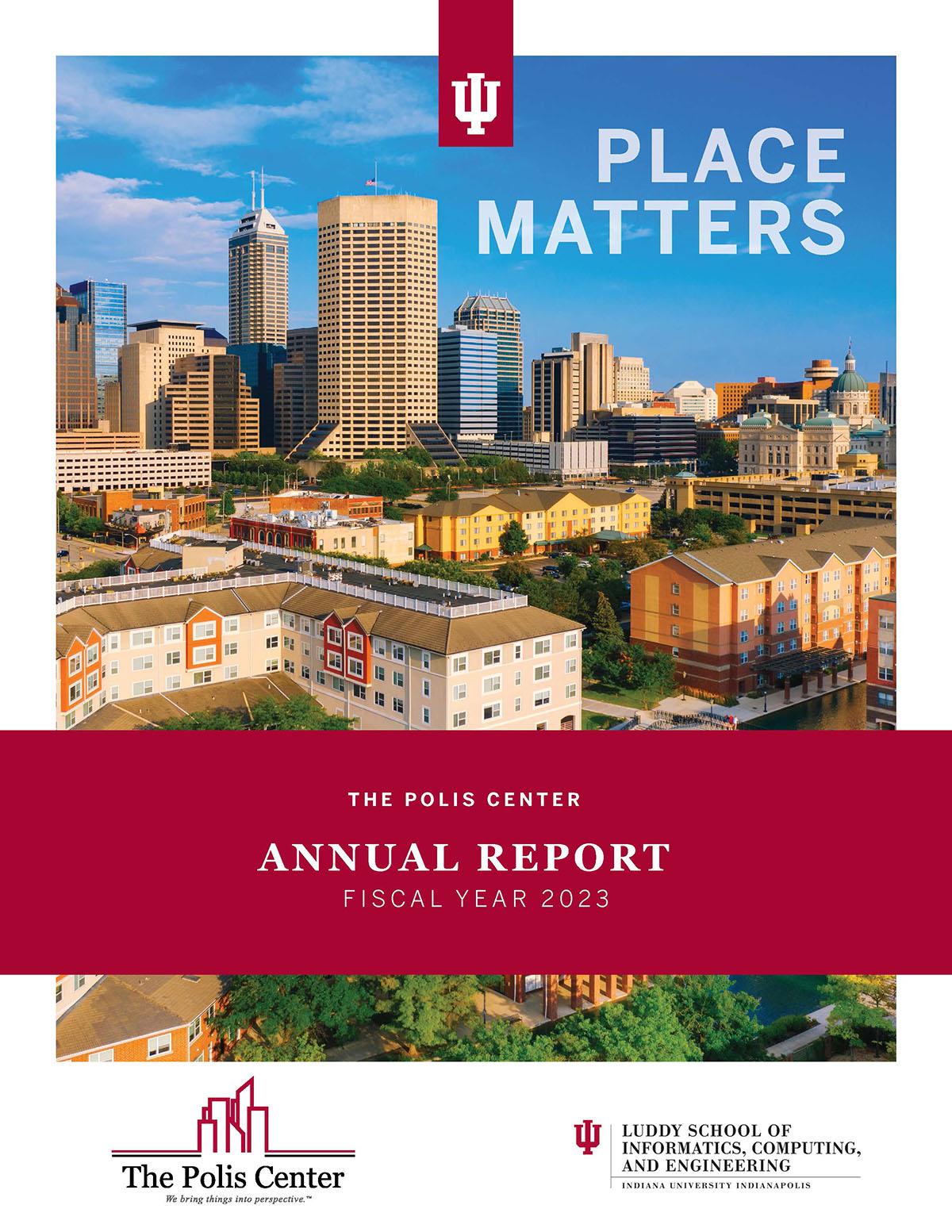
FY2023 Polis Center Annual Report
The Polis Center supports all three pillars of Indiana University – student success, research, and service to the state and beyond. Thanks to our new home in the IU Luddy School of Informatics, Computing, and Engineering, we have grown our engagement with students from 11 per year before joining the school in 2020 to 105 this year, providing each with experiential learning opportunities that prepare them for the workforce. We have grown our research partnerships with national institutes such as New America, Urban Institute, and Vera Institute, and we are a leading resource for health researchers who are exploring the social determinants of health. We grew our service to the state (and beyond) by expanding our SAVI Community Information System to the Evansville Region, supporting community disaster and resiliency efforts around the state, and equipping emergency management professionals around the nation with skills to apply geospatial resources to crisis management. We are at a pivotal time in our center’s history with unprecedented opportunities to amplify our work and its impact on society. Polis is recognized as a dynamic urban-centered, learning environment with highly professional staff who excel in partnerships, real-world application, and winning solutions for the communities. Going forward, we aim to become a national model for research and analysis of societal issues using geographically precise data.
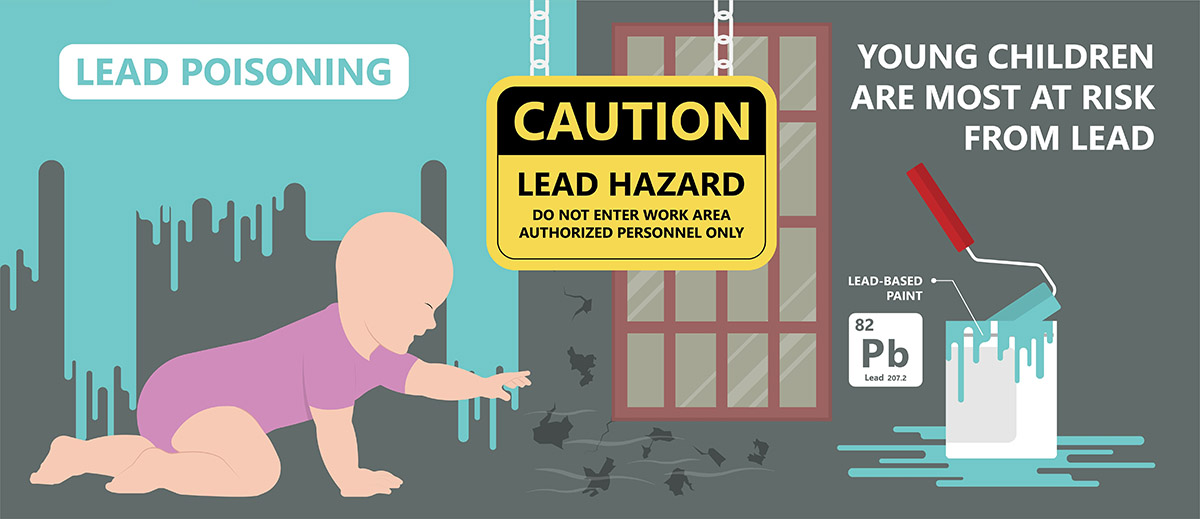
Lead exposure in the Indy East Promise Neighborhood
Matt Dietrich
We analyzed the adverse effects of childhood lead exposure, inequities relative to the rest of Marion County, and action steps regarding what can be done about it.
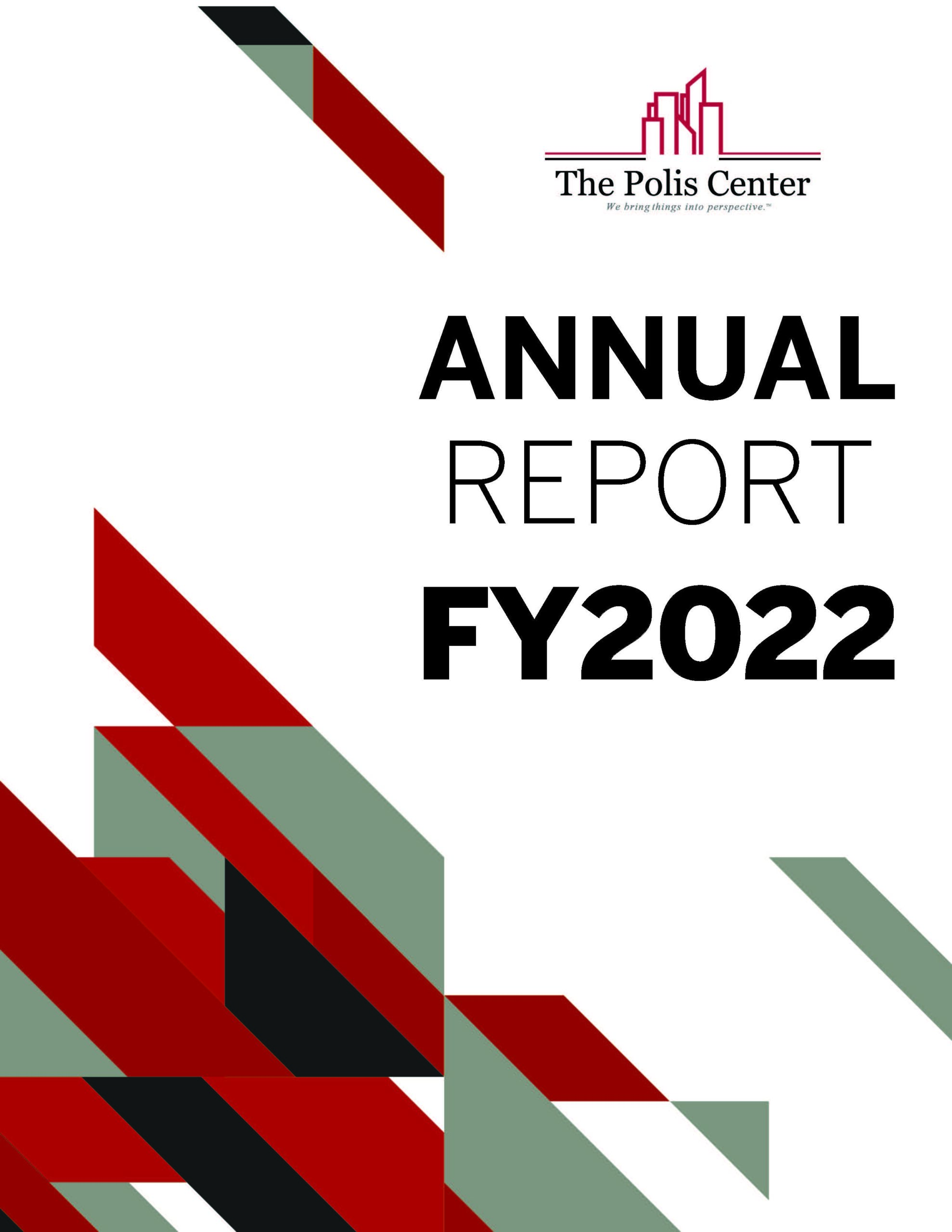
FY2022 Polis Center Annual Report
The Polis Center collaborated with more than 210 organizations on research and projects this year, applying informatics solutions to “real-world” place-based policies and practices for healthier and more resilient communities. Polis focused on inequities as a major theme through its emphasis areas, continuing an effort begun in 2020-21 in response to national and local health and racial equity crises. The Center’s work in this matter is guided by an equity research advisory committee comprised of experts and members of affected communities. The SAVI Equity & Data Hub is one of the most distinctive developments of this endeavor, an invaluable resource for Central Indiana decision-makers and news media. It features our research on equity in economic opportunity, housing, criminal justice, health, and more presented as articles, reports, maps, and charts. We also examined inequity in flood prone and non-flood prone areas.
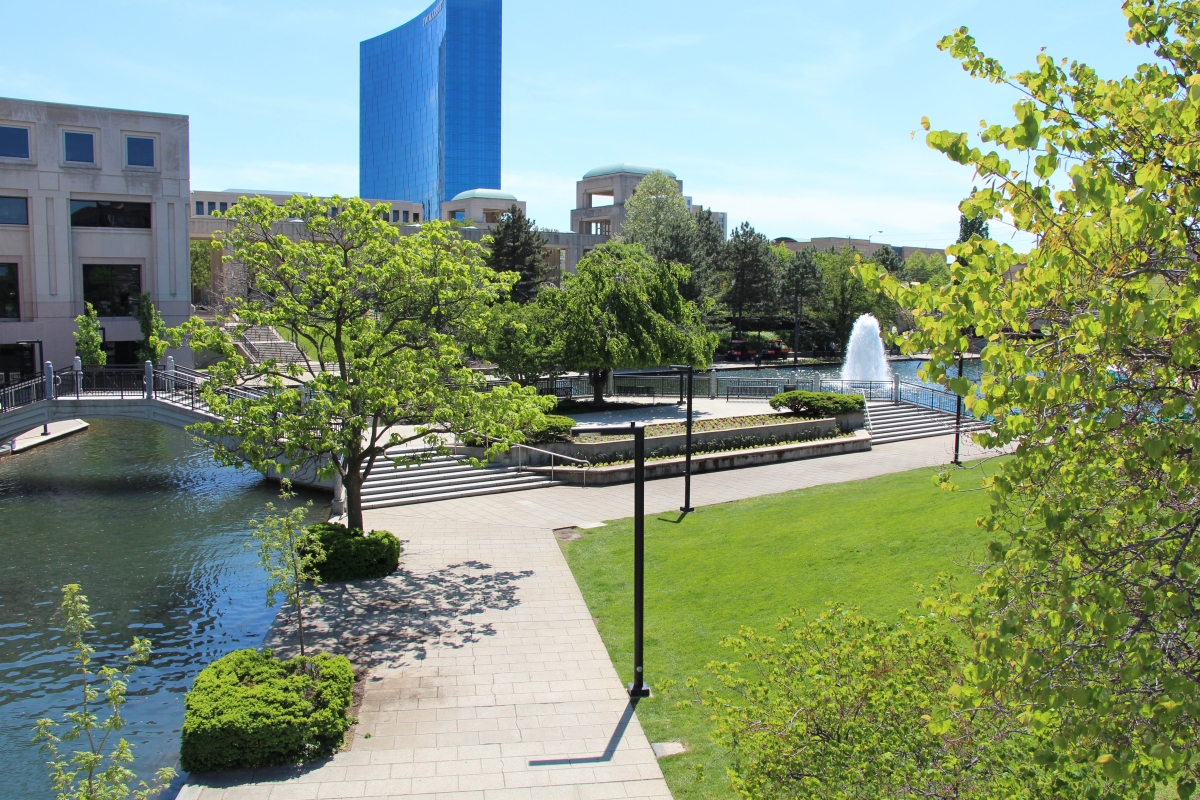
Greenspace Assessment for Marion County
Matt Dietrich, Danielle Lafever, Asger Ali, Aaron Olson
Greenspace can reduce the negative influence of urban areas on the environment by reducing overall atmospheric particulate matter pollution and mitigating the urban heat island effect.1 Indianapolis is known to have a significant urban heat island effect due to its large, sprawling metropolitan area. We developed a greenspace priority index to provide a starting point for deeper community assessment and engagement for neighborhoods needing more greenspace development and prioritization. See what we learned.

Are We Ready to Help Older Adults Age in Place?
Matt Dietrich and Karen Comer
Older adults are among the fastest growing demographic group both nationally and in Central Indiana. This means that in the future, there will be more older adults in the population than ever before. What will the characteristics and needs be of this older adult population? Will there be adequate services and care to meet the needs of this population so they can adequately age in place?

Male/female disparities within the older adult population of Central Indiana
Matt Dietrich
In this analysis, we point out several key differences between male and female older adults in Central Indiana, with a focus on data related to essential basic needs such as income, ability to live independently, health insurance coverage, and housing costs. We focus on adults aged 55 and over, but note that there are differences in need within that older adult population based on age, shown with our detailed evaluation of poverty rates throughout Central Indiana. While there are additional differences in need based on race and sexual orientation of older adults, this analysis is limited to female and male older adult (aged 55+) sub-populations.
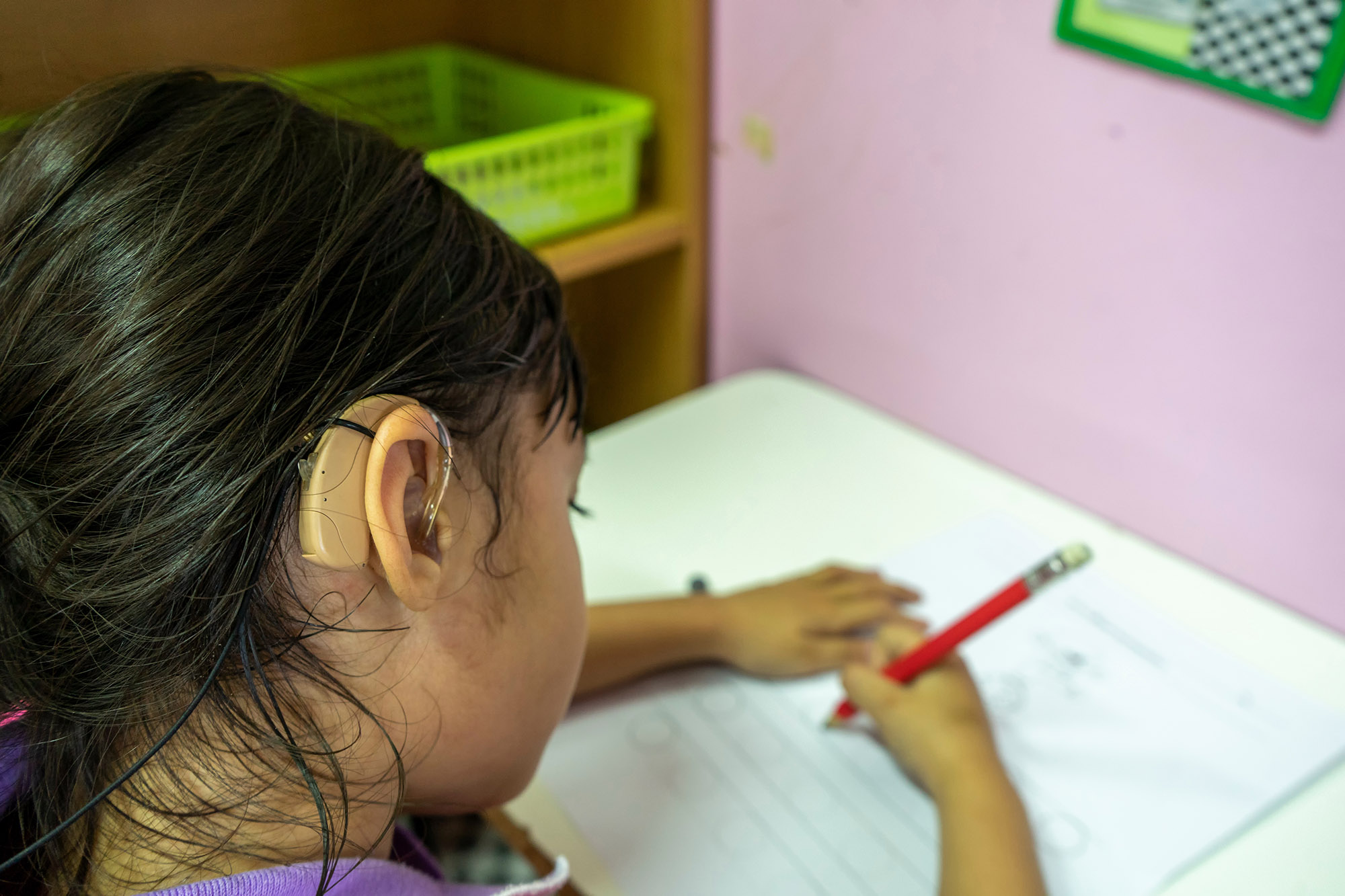
Academic Standardized Test Scores for the Hearing Aid Assistance Program of Indiana (HAAPI) Participants and Applicants
Aaron Olson
This report–a collaboration with Hear Indiana–summarizes our findings related to academic standardized test scores (IREAD, ISTEP) for deaf or hard of hearing (DHH) children who use hearing aids and communicate through spoken language as identified by Hearing Aid Assistance Program of Indiana (HAAPI) applicant data between 2014 and 2021. We find that these children have test scores comparable to or exceeding statewide averages in Math and English Language Arts (ELA). The findings provide evidence that DHH children who use hearing aids and communicate through spoken language can excel academically. In addition to these key findings, we also provide a detailed summary of the data sources used and recommendations for how to both reproduce and expand upon this analysis in the future. Those recommendations are listed at the end of the report.

Equity in Criminal Prosecutions: Analyzing Case Filings from the Marion County Prosecutor’s Office
Aaron Olson
The Kheprw Institute and The Polis Center are partnering to better understand the criminal justice system in Marion County and investigate potential disparities. This report is the next step in several prior analyses and reports examining the local criminal justice system.
Previous research from the Polis Center estimated that Black residents of Marion County were 2.7 times more likely to be jailed than their white counterparts in 2018 and 4.4 times more likely to be imprisoned in 2016. Significant progress has been made to narrow the racial gaps in both the prison and jail population, but that has slowed in recent years. Building off this research, Polis examined more than 283,000 bookings in Marion County jails between 2013 and 2021 to understand the jail population. Despite a significant drop in the jail population during the COVID-19 pandemic, jail levels have mostly returned to pre-pandemic numbers.

2022 Midterm Election Voter Turnout in Marion County
Matt Dietrich
Voter turnout is an important way to measure civic engagement. The more people who vote, the better representation there is of the actual population by those elected to hold office. Voter turnout is typically measured by the number of ballots cast divided by the number of registered voters, or the number of ballots cast divided by the number of voting-eligible citizens. Our analysis reveals voter turnout in Marion County is low relative to Indiana and the U.S.; within Marion County, there is great variation in voter turnout between precincts; and lower voter turnout in Marion County tends to occur in areas that are less affluent, have lower educational attainment, and where there are greater proportions of minority populations.
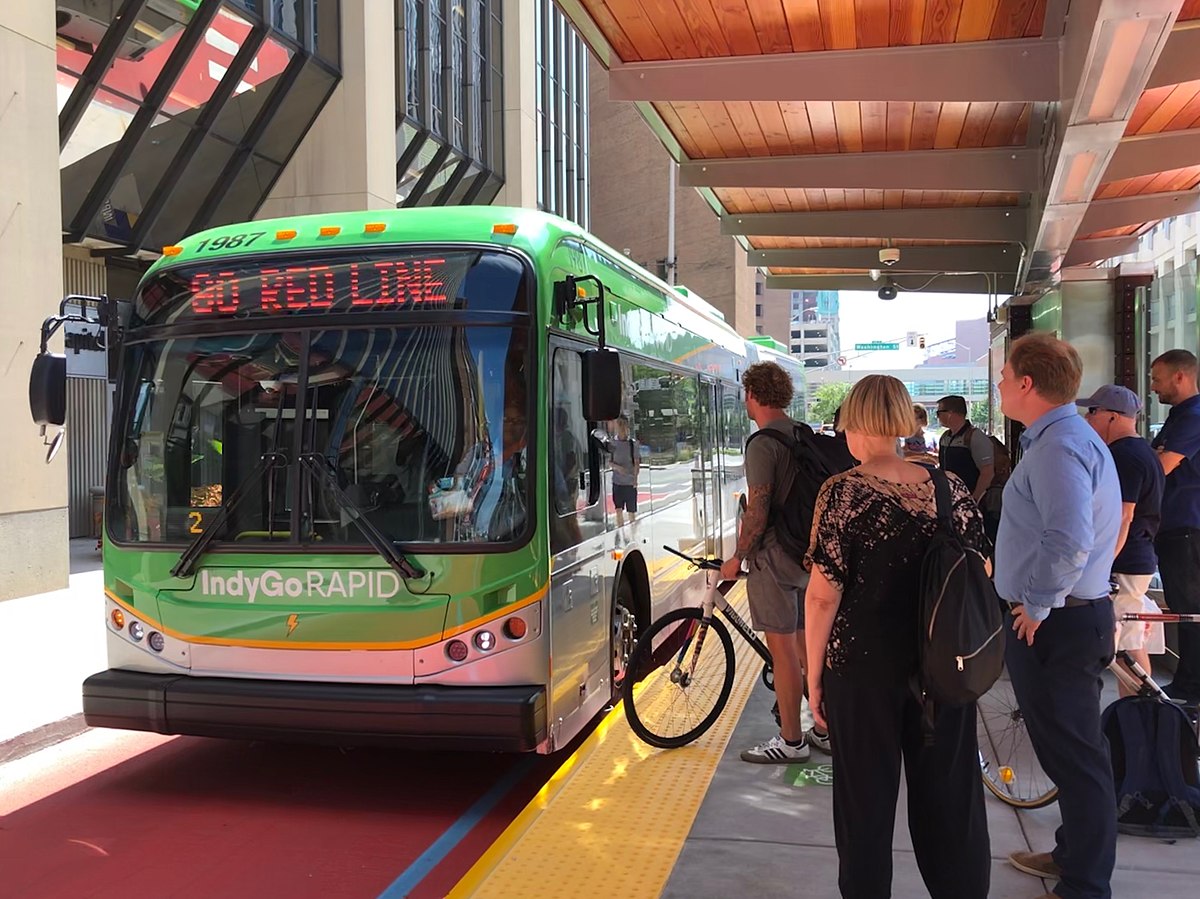
Limitations and opportunities with public transit for an aging population in Central Indiana
Matt Dietrich
Access to transportation is important because it empowers older adults to maintain their independence. Transportation opportunities for older adults may take different forms, including driving, public transportation, ride-share service, or shuttle buses. This report discusses public transportation access and perceived transportation barriers. Key findings include in Indianapolis, approximately 76,000 people age 65 or older live too far away from an IndyGo stop to likely use transit. That represents nearly two thirds of people age 65 or older in Indianapolis. The report addresses public transit accessibility for the older population in Central Indiana and the state. This partnership includes The Polis Center, and the Central Indiana Senior Fund, a fund of the Central Indiana Community Foundation.

How Is Indianapolis Doing
Aaron Olson, Ally Scott
This initiative features monthly updates on how the Indianapolis metro area is recovering and emerging from the COVID-19 pandemic on some of the most pressing and challenging issues in our community.

Domestic Violence in Marion County Criminal Justice System – 2022
Jay Colbert and Matt Nowlin
This is an update to our 2018 report. By combining data from different elements of the criminal justice system, we reveal basic statistics about domestic violence in Marion County. Some key findings include 1) In 2020, there were an estimated 10,105 victims of domestic violence (one percent of the population) and 5,880 perpetrators reported in the legal system. 2) Victims’ gender is predominantly recorded as female (71 percent in 2020), with the largest group aged 25-29. Victims of male gender make up a higher proportion in 2020 (23 percent) than in 2016 (17 percent). 3) Perpetrators’ gender is predominantly reported as male (81 percent in 2020), with the largest group aged 30-34. 4) Forty-five percent of victims are Black and 40 percent are White. Domestic violence victims are disproportionately Black. Comparatively, 27 percent of the population is Black and 51 percent is white.
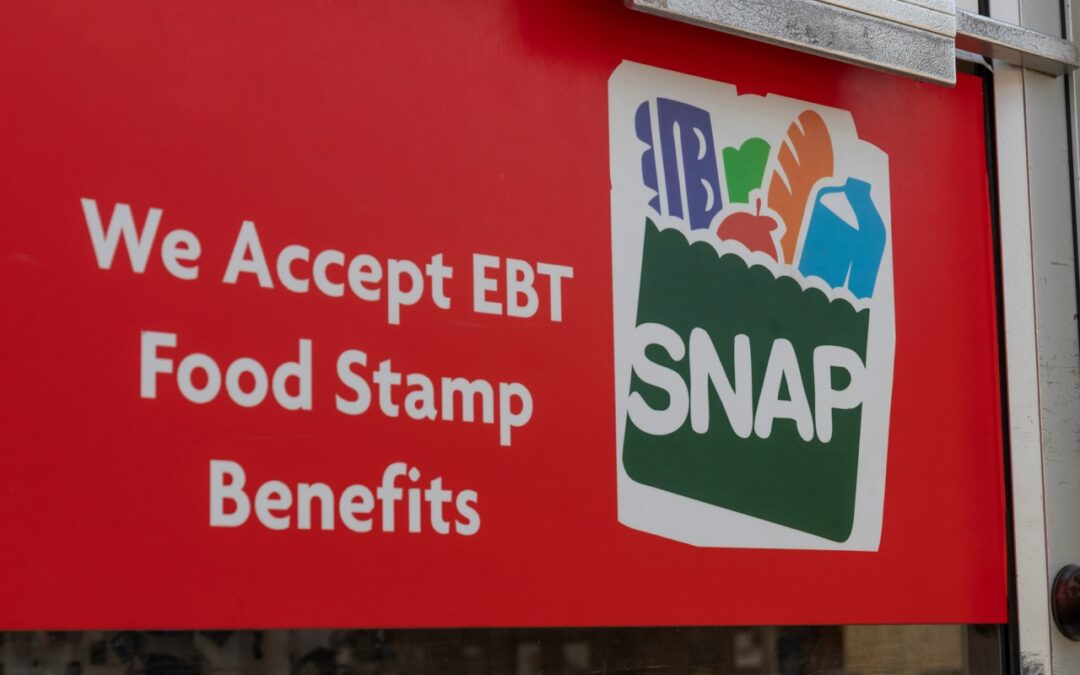
SNAP Policy and Usage by Older Adults During the COVID-19 Pandemic
Matt Nowlin, Unai Miguel Andres, and Karen Comer
The COVID-19 pandemic increased economic need and prompted the expansion of food assistance programs to address that need. Supplemental Nutrition Assistance Program (SNAP) benefits were extended to more families, the amount of available assistance was increased, and online purchases were allowed. In Central Indiana, and Indiana as a whole, the number of households using SNAP, purchases, and spending increased substantially compared to pre-pandemic levels. In addition, online SNAP purchasing grew steadily among all population groups, although uptake among older adults of color remained significantly lower than White older adults.
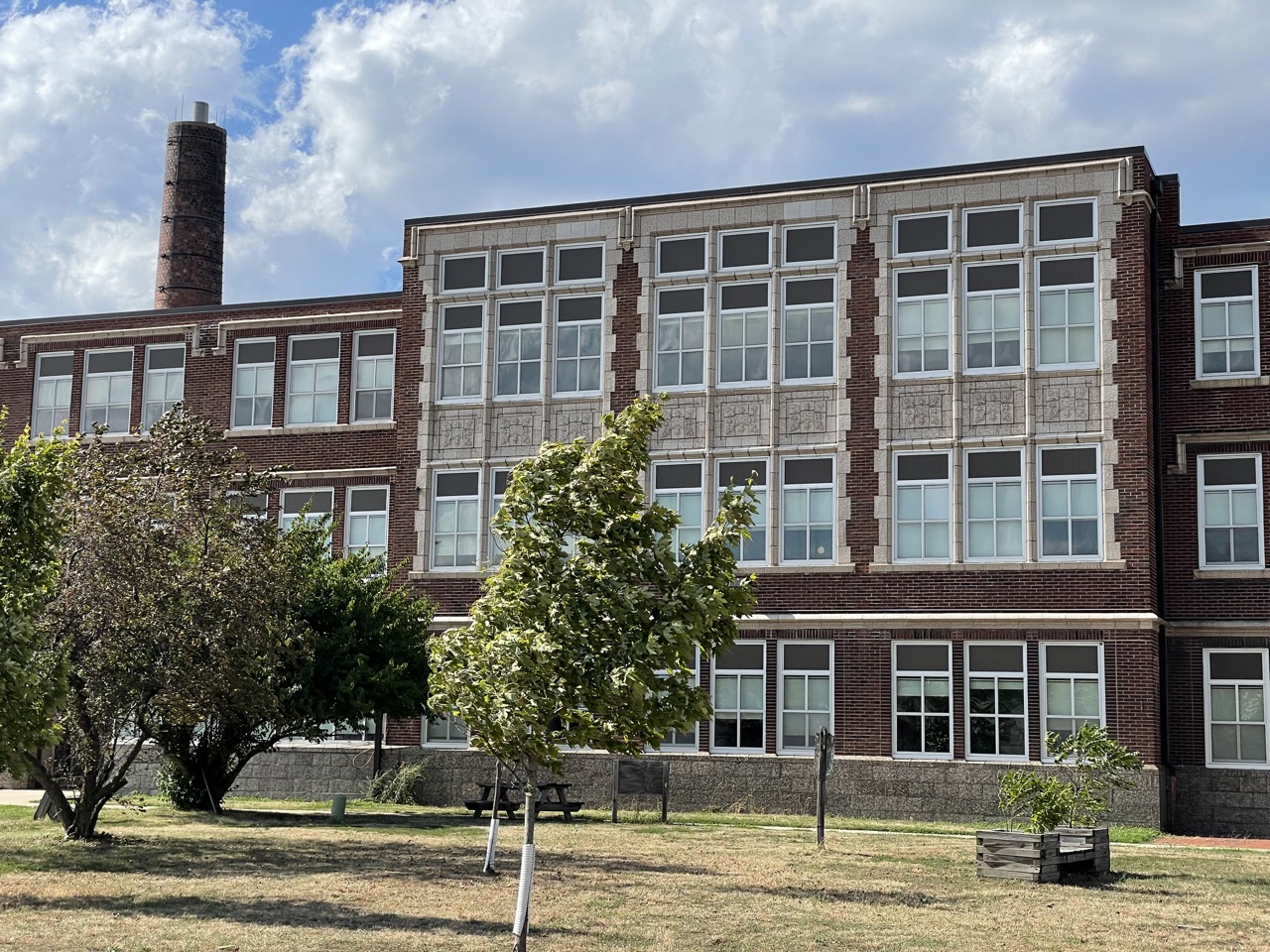
A Decade of Decline: College-Going Rates in Central Indiana
Aaron Olson
The value of a traditional college degree has become a national conversation in recent years, partially due to ballooning costs and ever-increasing student debt burdens. Despite the increase in scrutiny, the numbers show that the lifetime value of a college degree is unquestionable in terms of both earning potential and wealth building.
Our analysis of Central Indiana high schools shows that declines in college-going rates impact everyone, from affluent suburban communities to economically disadvantaged neighborhoods.

Who is in the Marion County Jail? Exploring Length of Stay through an Equity Lens
Rebecca Nannery, Jay Colbert, Erik Steiner and Matt Nowlin
To better understand the Marion County Jail population, some of the challenges it faces, and how longer-term stays relate to these, we examine inmate and booking data obtained from the Marion County Sheriff’s Office. Our analysis explores length of stay and the presence of mental health and substance use among Marion County Jail inmates, drawing attention to the characteristics of those with longer lengths of stay or charges that might merit alternative responses in the community or reduced jail time. We also examine racial disproportionalities within the jail, as half of inmate bookings in recent years are from the Black community, in comparison to the racial composition of Marion County, which is only 30% Black.
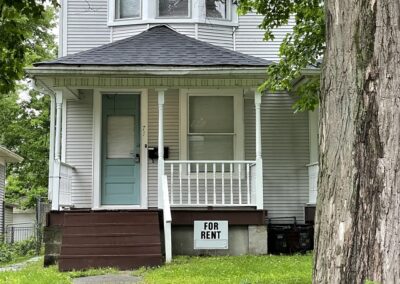
The State of Tenants in Central Indiana
Matt Nowlin, Sarah Smith, and Alankrit Gupta
Indiana Senate Bill 230 would have required landlords to make necessary repairs to their properties. We examine the renters impacted by the bill’s failure.
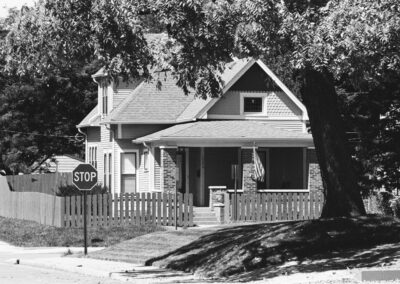
Modern Redlining in Indianapolis?
Erik Steiner and Matt Nowlin
Our analysis of one million loan applications since 2007 shows that, even when income and debt are the same, having a Black applicant on the loan increases the odds of being denied by 2-3X, and applying for a loan in a historically redlined neighborhood increases the odds of denial by 50 percent.

A Deep Dive into Affordable Rental Housing
Matt Nowlin
New data shows the number of subsidized rental homes in Marion County is stagnant, while the need for units affordable to extremely low-income households is large.
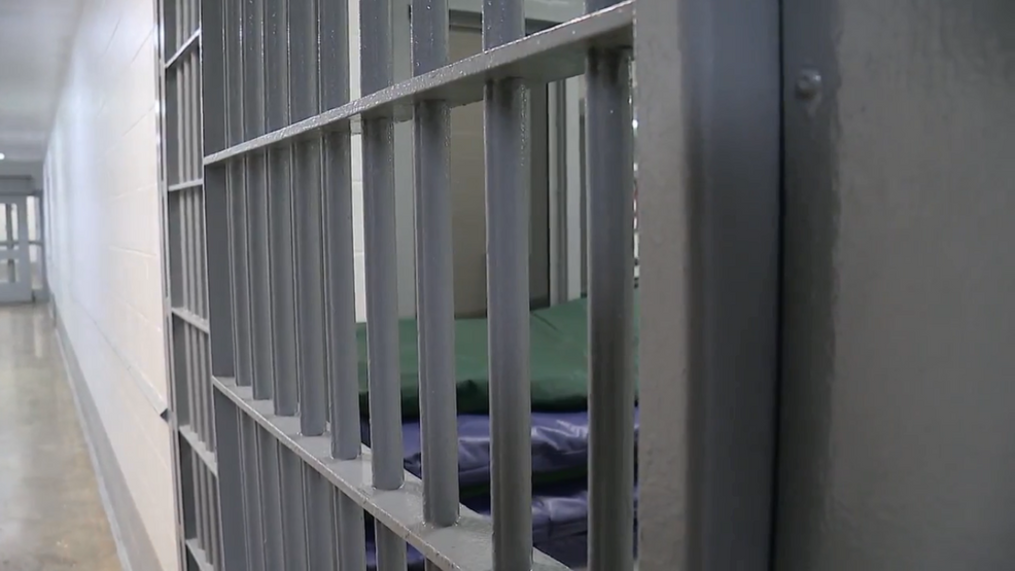
2022 Community Trends: Who is in the Marion County Jail? Exploring Length of Stay through an Equity Lens
Rebecca Nannery, Jay Colbert, Erik Steiner, and Matt Nowlin
We analyzed more than 283,000 bookings into Marion County’s jails between 2013 and 2021. We used this data to discover how many people are in jail, the characteristics of those in jail, and how long people remain in jail.

The State of Aging in Central Indiana Report
This report is a tool to help generate transformative ideas that address the unique and diverse needs of older adults in Central Indiana. It aims to provide actionable information and inspire community leaders, decision-makers, senior-serving organizations, and philanthropic organizations to envision potential programs, funding, and policies that will help Central Indiana seniors have equal opportunity for a healthy, dignified, and enjoyable life.

Living in the Community with Dementia
This research brief discusses the many challenges faced by the growing number of older people living with dementia (PLWD) in the community; and several promising initiatives that aim to better support PLWD and their caregivers.
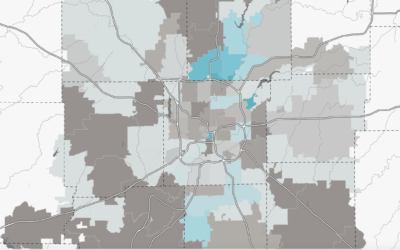
Financial Stability and Housing
Many older adults in Central Indiana face financial instability, particularly those of retirement age that live on a fixed income. Big ticket monthly budget costs such as housing and health care can place great financial pressure on older adult households.
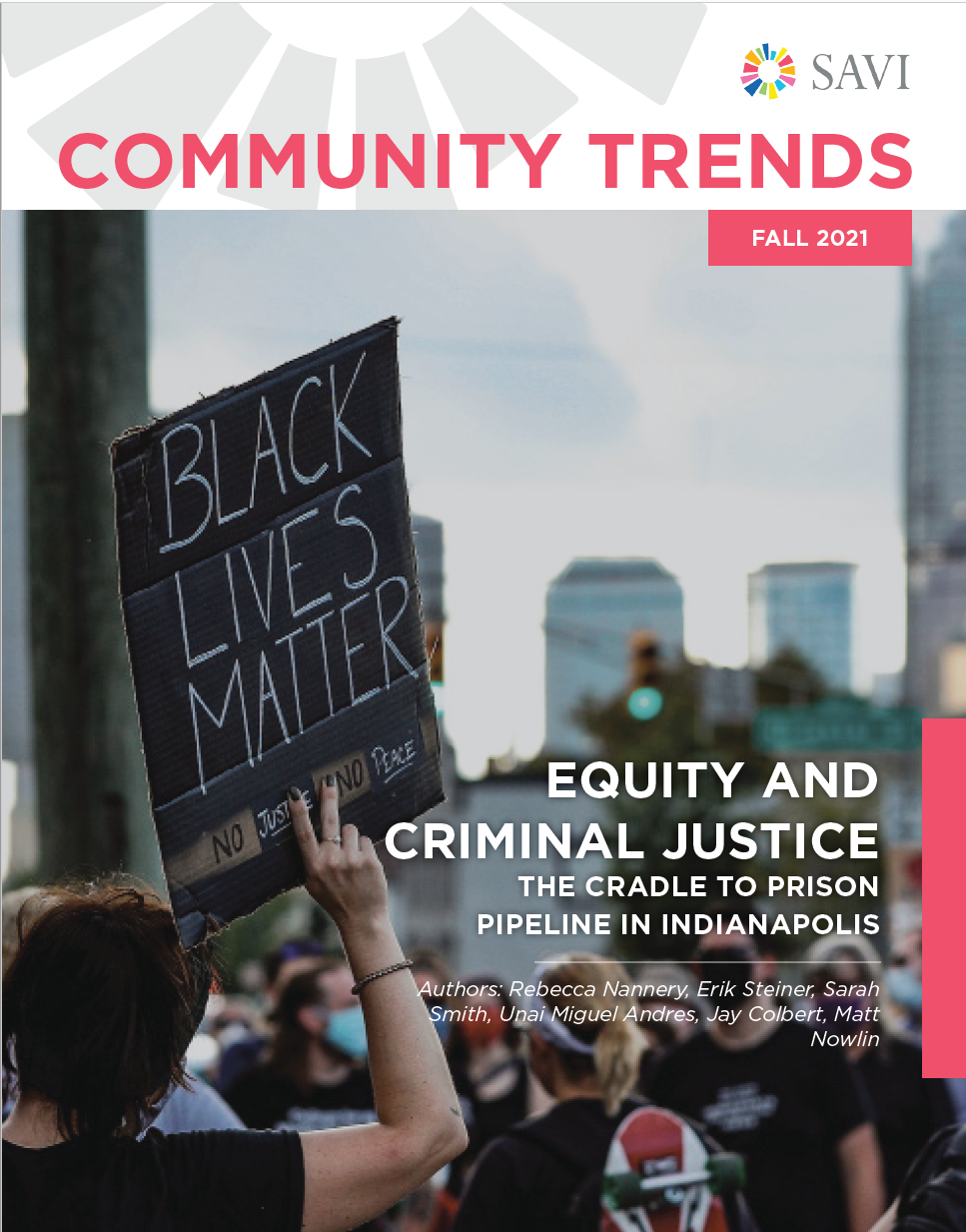
Equity and Criminal Justice: The Cradle to Prison Pipeline in Indianapolis
Rebecca Nannery, Erik Steiner, Sarah Smith, Unai Miguel Andres, Jay Colbert and Matt Nowlin
Addressing inequities present in our modern-day justice system is an important priority for reducing systemic inequality. Imprisonment of its residents impacts our entire community. A child who grows up in a neighborhood where many residents are imprisoned is more likely to become imprisoned themselves and earn less income in adulthood. Their children, in turn, are more likely to grow up in a single-parent household and become imprisoned.
It is well known that racial disparities exist within policing and the jail and prison systems. Black Hoosiers are twice as likely to be jailed and 4.5 times as likely to be imprisoned as their white peers. However, these disparities exist long before an individual is imprisoned. From the place and situation into which a child is born, to the discipline and juvenile justice policies in their school and community, a person’s childhood experience influences their likelihood of being involved in the criminal justice system.
This report examines a concept called the “cradle to prison pipeline.” It is a review of some of the basic statistics at each stage of this pipeline: childhood, school, juvenile justice, early adulthood, and imprisonment. For each stage, we present basic trends and disparities across race, place, gender, and other demographic variables.
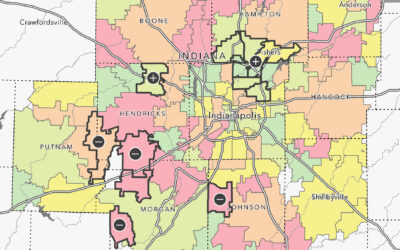
Gaps in Life Expectancy Across the Lifespan
Low life expectancy is concentrated in the core of Indianapolis from birth to age 45. But at age 75, most concentrated areas of low life expectancy are rural.
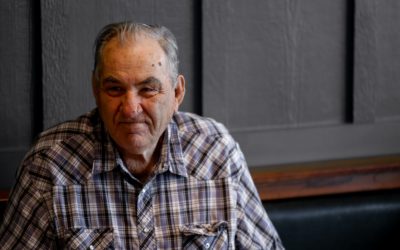
Worlds Further Apart
This report discusses the risk in older adults for severe illness from COVID-19, hospitalization and mortality rates, and the disproportionate impact of COVID-19 on residents of long-term care facilities and people of color.
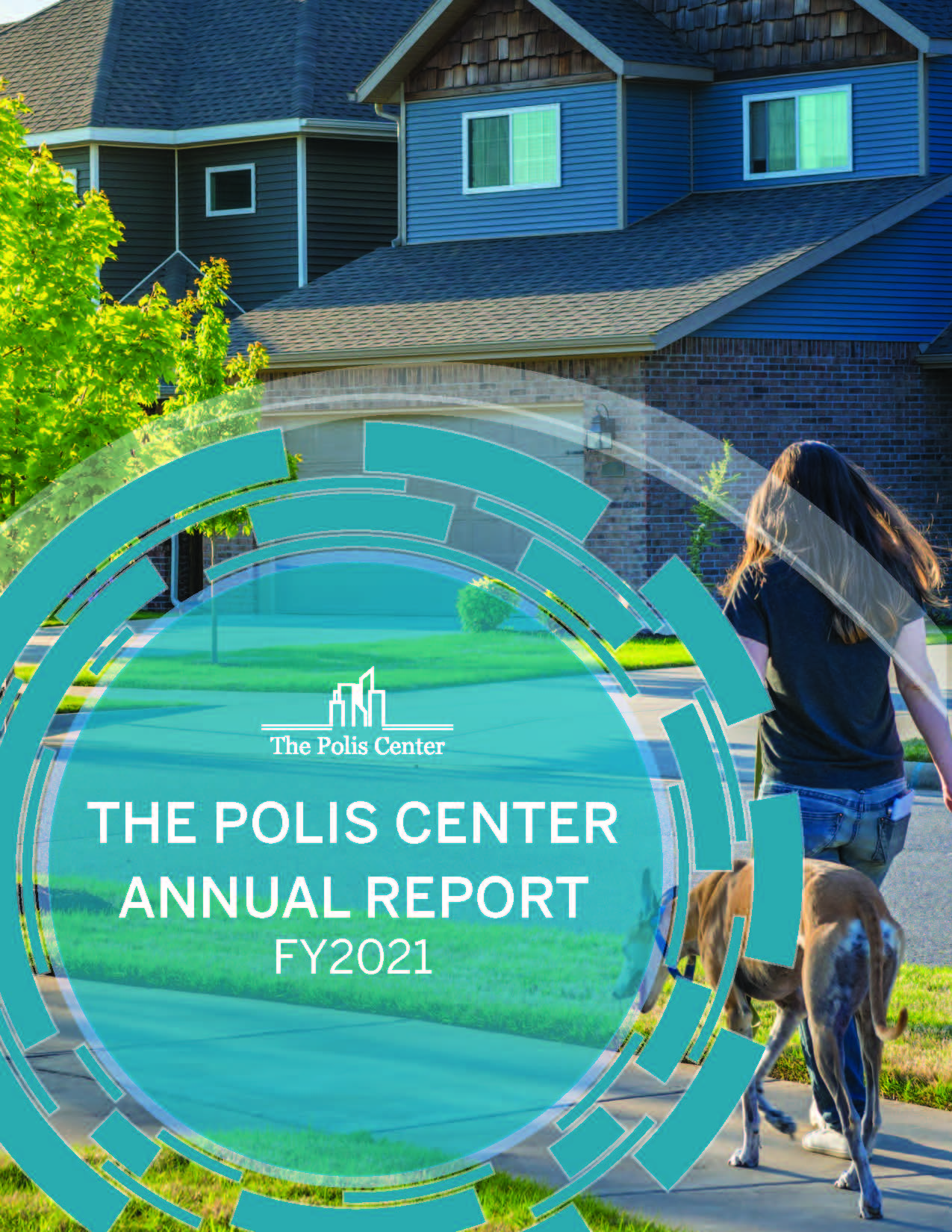
FY2021 Polis Center Annual Report
The Polis Center had another productive year in FY2021, the global pandemic notwithstanding. Not only did the staff continue to meet existing project milestones while working remotely, but the Center received new grants and contracts for a total of $3,395,141. The Center’s place-based information and its analytical capabilities proved exceptionally useful to our partners, as well as to our various constituencies, as seen most clearly in two information resources—the SAVI COVID-19 Data and Information Hub and the SAVI Equity Data and Information Hub. Both hubs were created in response to the national and local health and racial equity crises. We provided a data-informed response to current issues with these data hubs and developed an equitable funding allocation model for the Indianapolis City-County Council.
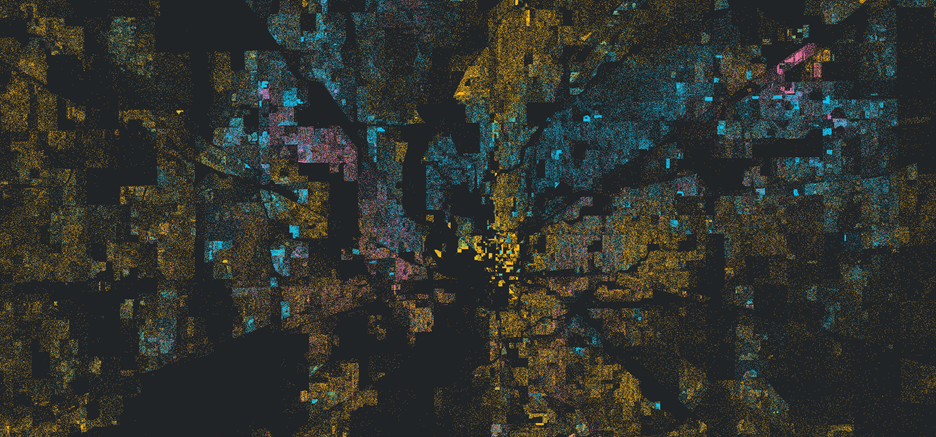
Our Changing City, Block by Block
Matt Nowlin
New data from the 2020 census several demographic trends in Indiana. The region is growing, driven by rapid development in suburban counties and increased Latino, Black, and Asian populations in Marion County. Downtown Indianapolis has also experienced a resurgence, increasing in population for the first time in six decades. Small-scale data illustrate exactly how these trends have taken shape. Data about the people living in each block tell us which new subdivisions contributed to suburban population growth, how many people were added to the downtown population with the construction of a new apartment block, or how the racial composition of a block changed over the decade.
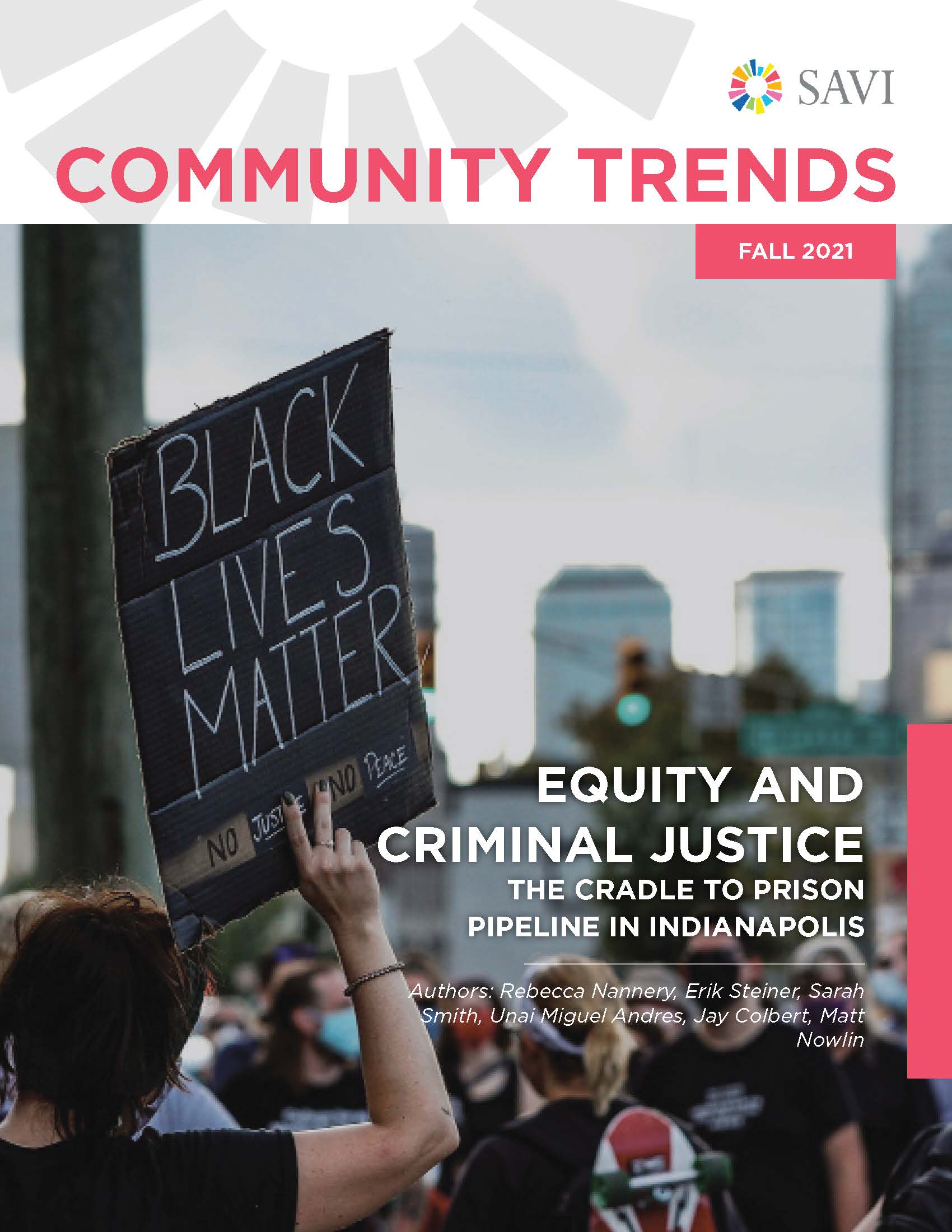
2021 Community Trends: Equity and Criminal Justice, The Cradle to Prison Pipeline in Indianapolis
Rebecca Nannery, Erik Steiner, Sarah Smith, Unai Miguel Andres, Jay Colbert, Matt Nowlin
This report examines a concept called the “cradle to prison pipeline.” It is a review of some of the basic statistics at each stage of this pipeline: childhood, school, juvenile justice, early adulthood, and imprisonment. For each stage, we present basic trends and disparities across race, place, gender, and other demographic variables in Indianapolis.
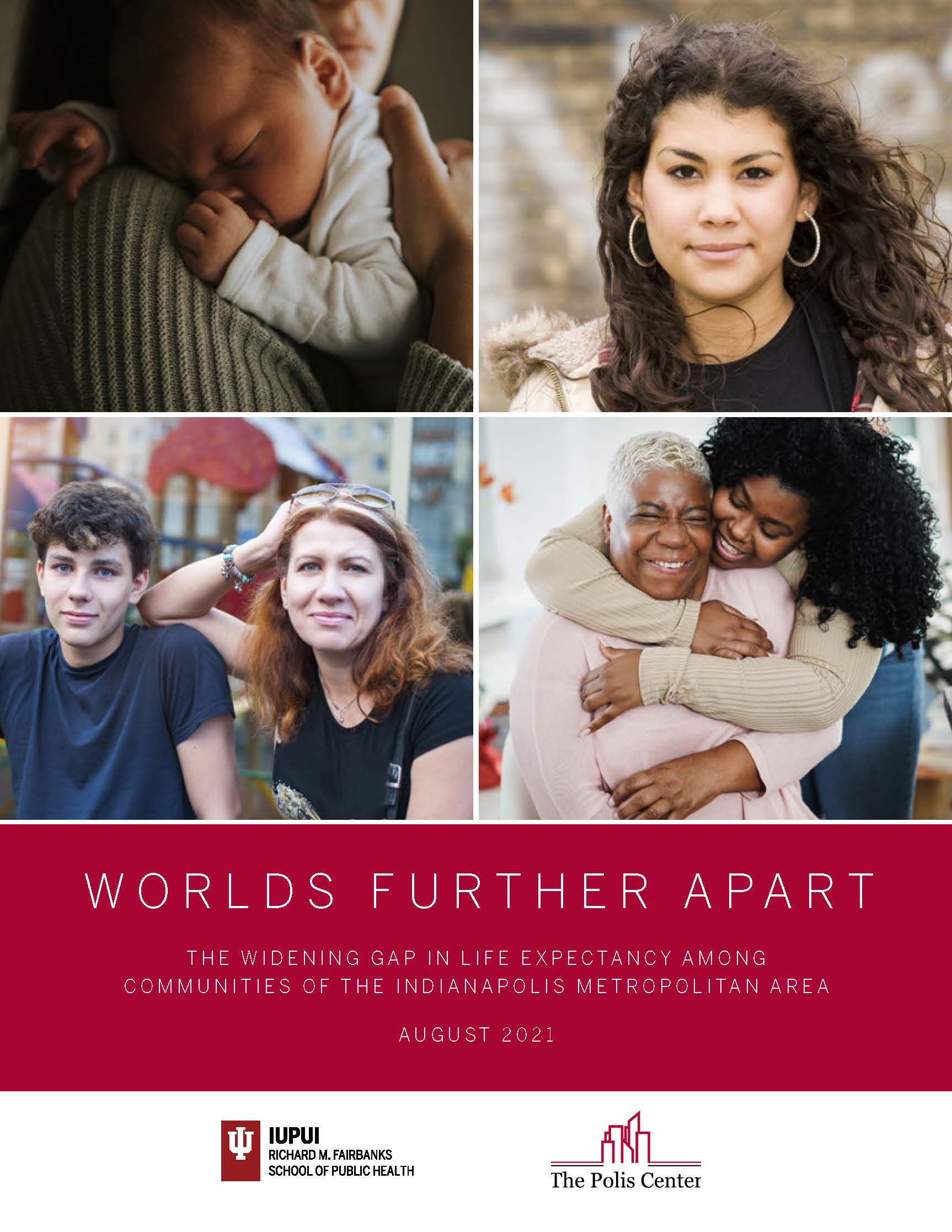
2021 Community Trends: Worlds Further Apart
Tess Weathers, NT Keihl, Jay Colbert, Matt Nowlin, Karen Comer and LK Staten
In our updated analysis of 104 ZIP Codes in the metro area (2014-2018), we identified the northern suburb of Fishers as our longest living community and just 17 miles away, within the Indianapolis city limits, is the shortest living community within the metro area. Though only 17 miles of distance separate them, their life expectancy is worlds apart.
There was a clear widening of the gap between the longest- and shortest-living ZIP Codes of the metro from 13.6 years to 16.8 years – an increase of 3.2 years (23.5%) in the gap over the 2013 level.
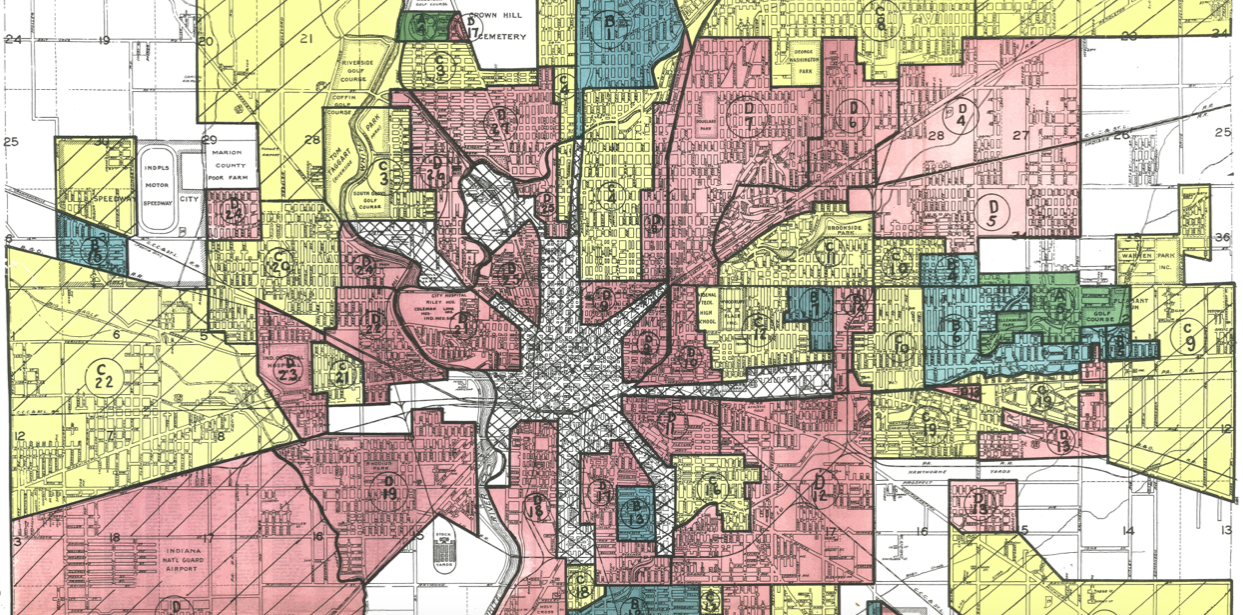
The Lasting Impacts of Segregation and Redlining
Jeramy Townsley, Unai Miguel Andres and Matt Nowlin
Although the Civil Rights Movement began to reshape race relations, especially by making segregation illegal, the policies and practices of a segregated society continue to influence American society. Residential housing is one area in which the impacts of housing discrimination are destructive and long-lasting. What is not so apparent to many citizens is the relationship between these discriminatory policies and current economic, health, and environmental outcomes. This article describes the long-term impact of segregation and redlining on economic opportunity, health outcomes, and the environment.
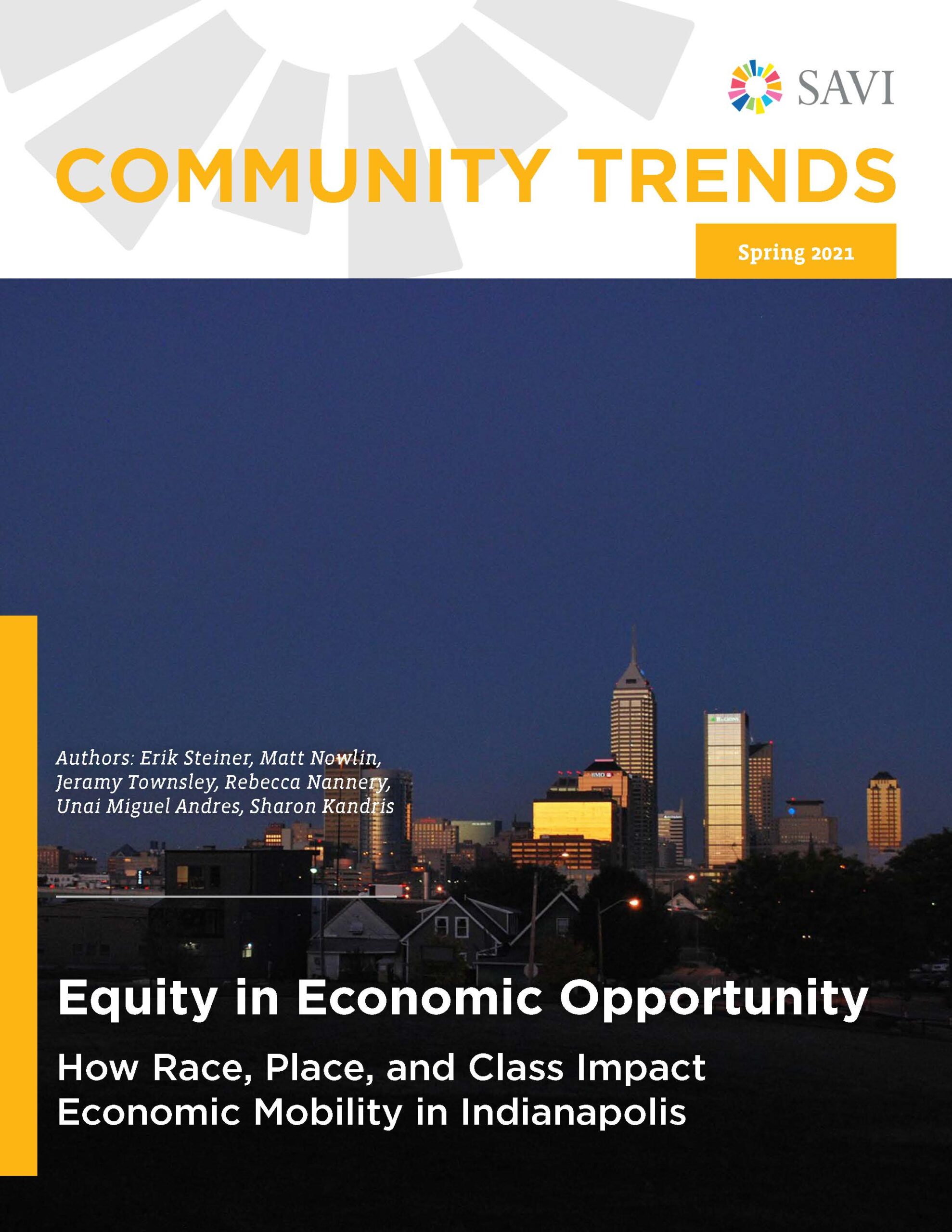
2021 Community Trends: Equity in Economic Opportunity: How Race, Place, and Class Impact Economic Mobility in Indianapolis
Erik Steiner, Matt Nowlin, Jeramy Townsley, Rebecca Nannery, Unai Miguel Andres, Sharon Kandris
Children born to low-income families in Indianapolis in the 1980s grew up to earn less than their peers in almost any other large city. The ability of children to move above the economic status of their parents is influenced by the parents’ income, demographics, and neighborhood conditions.
Research from Harvard Economist Raj Chetty examines how the conditions in which children grew up relate to their earnings in adulthood.1 While this study was nationwide, we focus on highlighting the results in Indianapolis, putting that information in local context, and deepening the research based on local conditions. We also recommend further research and policy implications
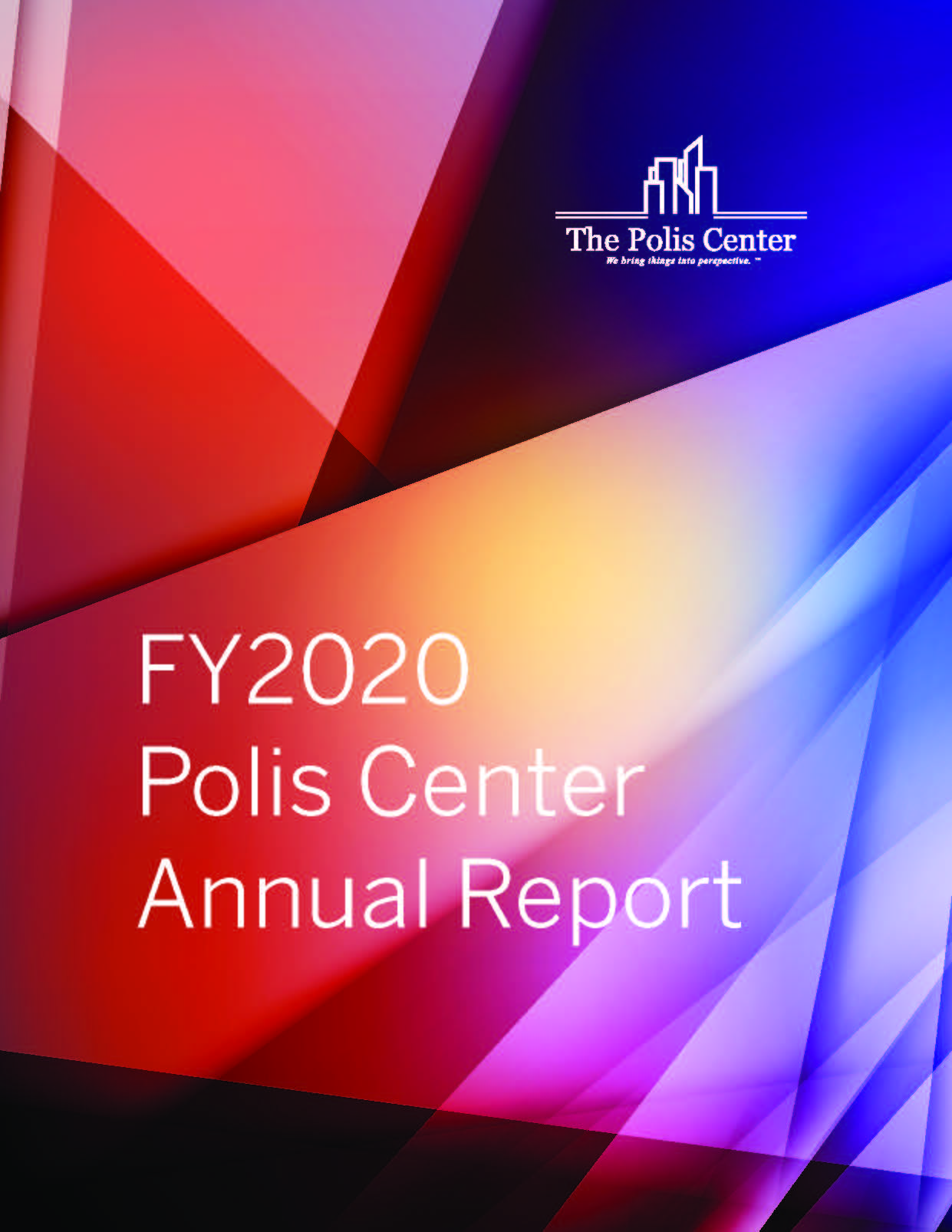
FY2020 Polis Center Annual Report
The global pandemic dominated our attention in FY2020, at least since its arrival in the U.S. in early spring. In concert with the university and community, we responded with initiatives that addressed the challenges it posed, including the problems of racial, social, and economic inequalities that it revealed. This work, although spurred by the pandemic, was not new to us. Rather, it allowed Polis to use its information and analytical capabilities to new ends. Learn more!
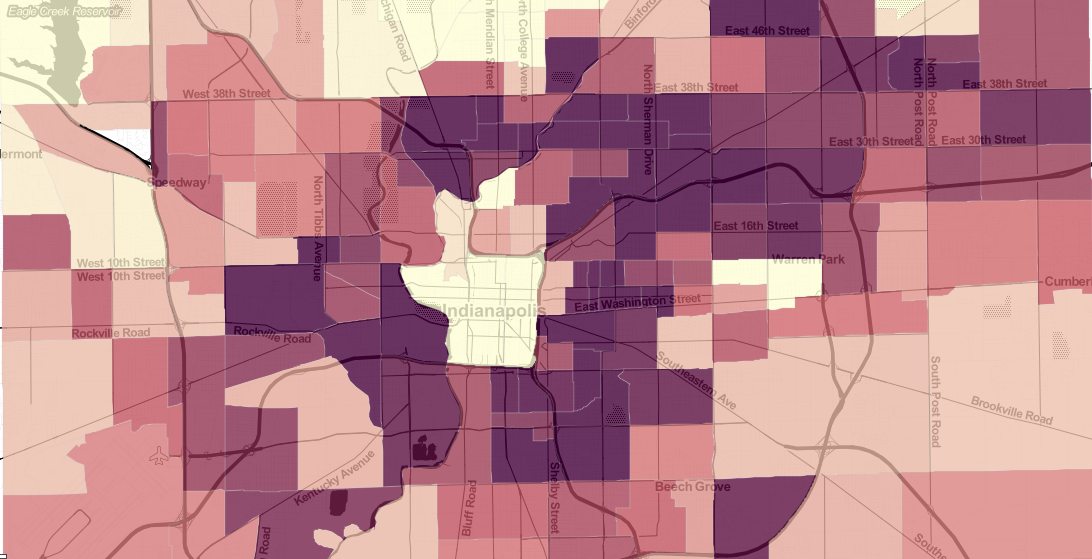
Indy Evictions May Reach 34,000 or More in 2020
Jeramy Townsley and Matt Nowlin
Indiana lost 436,000 jobs between February and April, driving the unemployment rate from 3.1% to 17.5%. While the state gained back 217,000 jobs by June, unemployment remained extremely high at 11.2%. (Bureau of Labor Statistics) Additional unemployment insurance payments and moratoriums on evictions have softened the impact of this economic crisis, but those supports and protections have since expired.
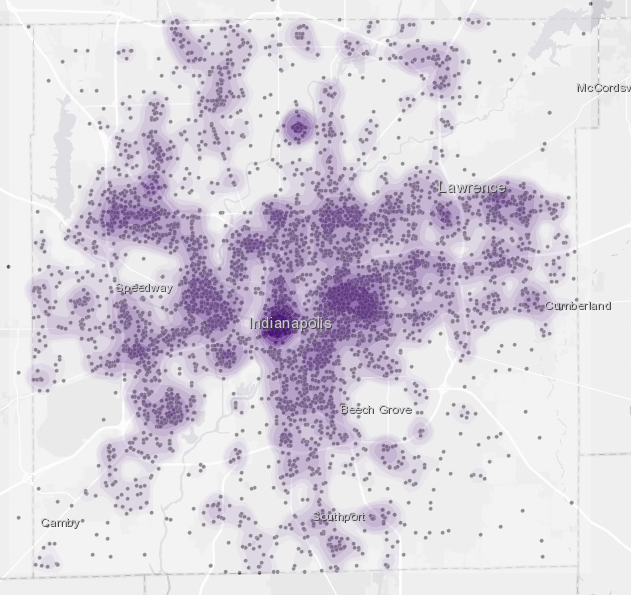
Police Used Force on 1.3 Percent of Black Residents Since 2015
Matt Nowlin, Unai Miguel Andres and Jeramy Townsley
olice have used force on 13 out of every 1,000 black residents since 2015, compared to only 5 out of every 1,000 white residents. Police use force on black residents at over 2.5 times the rate of white residents. Police use force more often in neighborhoods with high crime rates. However, use of force is also associated with neighborhoods that have higher poverty rates, lower educational attainment, and more young black men, even when controlling for the crime rate.

2020 Community Trends: Health and Economic Impact of COVID-19 on Neighborhoods
Karen Comer
In this report, we identify the areas in Indianapolis most affected by COVID-19, particularly those already disproportionately affected by poverty; define some of the challenges families in these areas are facing; and explore ways inequity plays a role in the risk, outcomes, and impact. We highlight trends across Indianapolis and focus on two areas in the county experiencing growing poverty and a disproportionate impact of COVID-19 – the Northeast and Northwest areas. First, we take a look at the timeline for COVID-19 in Indianapolis.
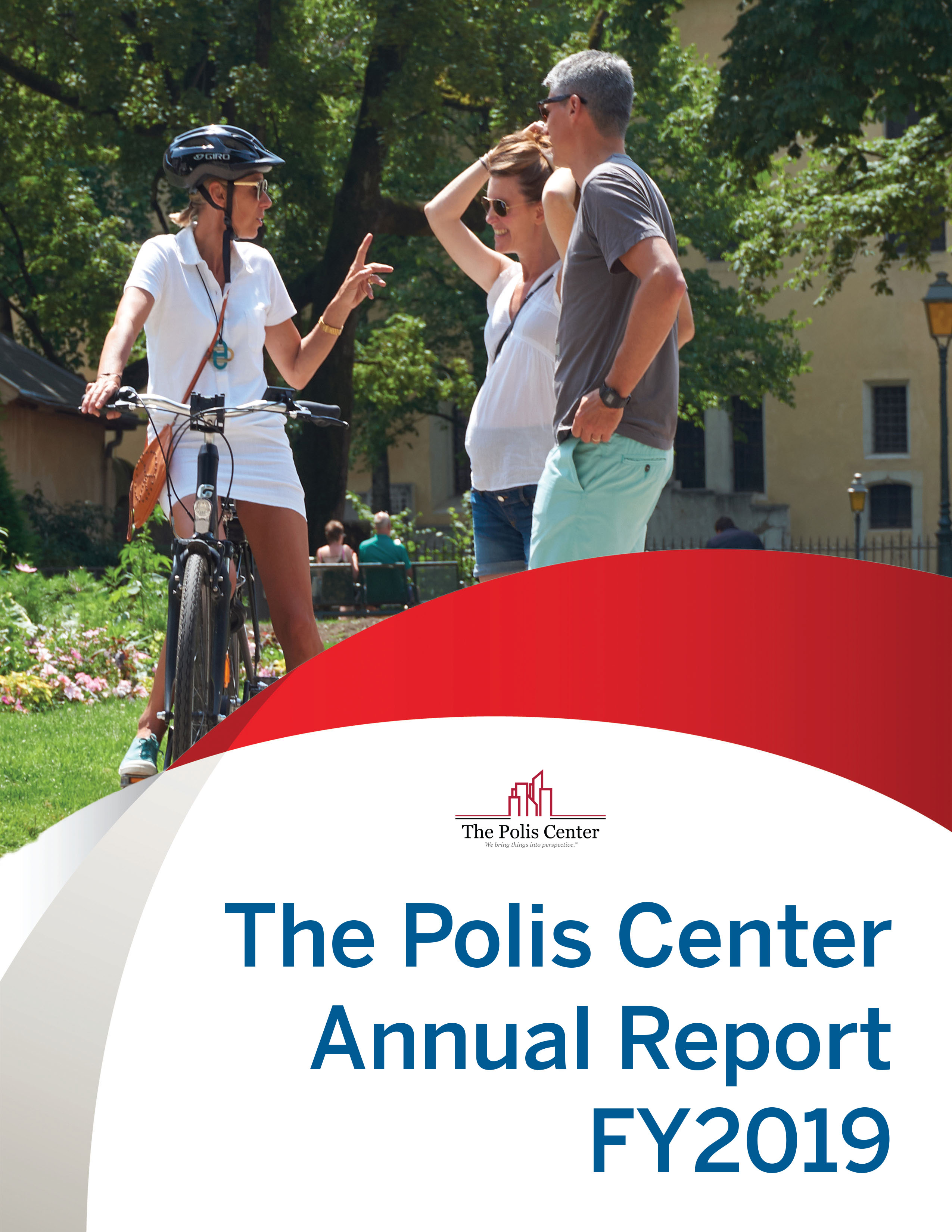
FY2019 Polis Center Annual Report
We are engaged in ground-breaking work in a variety of activities important to Indiana communities and beyond. We managed more than 93 projects in FY2019; 35 percent of these projects were new grants or contracts. The following descriptions highlight our major accomplishments in each sphere of collaboration and in a major civic enterprise, the Spirit & Place Festival, which we launched in 1995 and direct on behalf of IUPUI and the IU School of Liberal Arts.
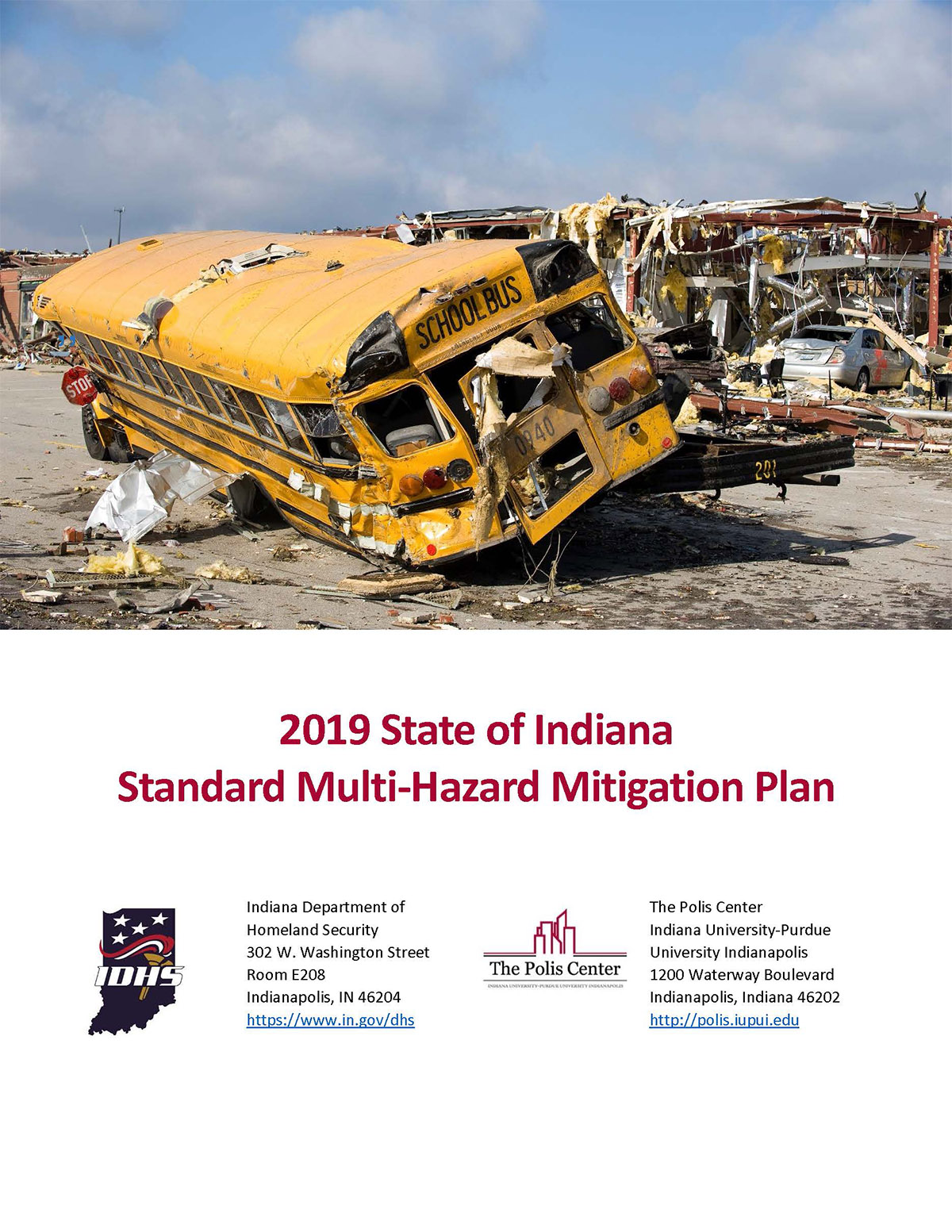
2019 State of Indiana Standard Multi-Hazard Mitigation Plan
The Indiana Multi-Hazard Mitigation Plan was developed in collaboration with government, academic, and other private partners for the purpose of preventing, protecting against, responding to, and recovering from natural disasters that may threaten the State’s citizens, infrastructure, and economy. The federal Disaster Mitigation Act of 2000 provides the legal basis for FEMA mitigation planning requirements for State, local, and tribal governments as a condition of federal grant assistance. Indiana must have a FEMA approved State Multi-Hazard Mitigation Plan to remain eligible to receive federal assistance through the following programs: Public Assistance (Categories C-G), Hazard Mitigation Grant Program (HMGP), Pre-Disaster Mitigation Grant Program (PDM), Flood Mitigation Assistance Grant Program (FMA), and Fire Management Assistance Grants (FMAG). Since 2008, Indiana has received almost $50,000,000 in Mitigation grant funding through these programs. The 2019 Indiana Multi-Hazard Mitigation Plan lays the framework for accomplishing one of the Indiana Department of Homeland Security’s top 2019-2020 strategic priorities of expanding mitigation and resiliency in the State of Indiana. This includes expanding statewide collaboration and planning, promoting safety, implementing a statewide mitigation strategy, and strengthening partnerships that impact resiliency.
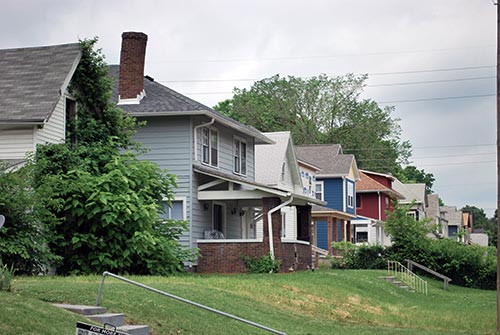
2019 Community Trends: The Changing Landscape of Poverty
Matt Nowlin, MURP; Unai Miguel Andres, MURP; and Kelly Davila, MS
Neighborhoods or Concentrated Poverty Poverty has been increasing in the Indianapolis region, as it has in many Midwestern metropolitan areas. In 2017, 14 percent of Central Indiana residents lived below the poverty threshold, compared to 9 percent in 1970. In many Indianapolis neighborhoods, the poverty rate is much higher. One fifth of the region’s residents live in low-income neighborhoods—census tracts with poverty rates of 20 to 39 percent. 80,000 residents live in areas of concentrated poverty, with poverty rates of at least 40 percent.
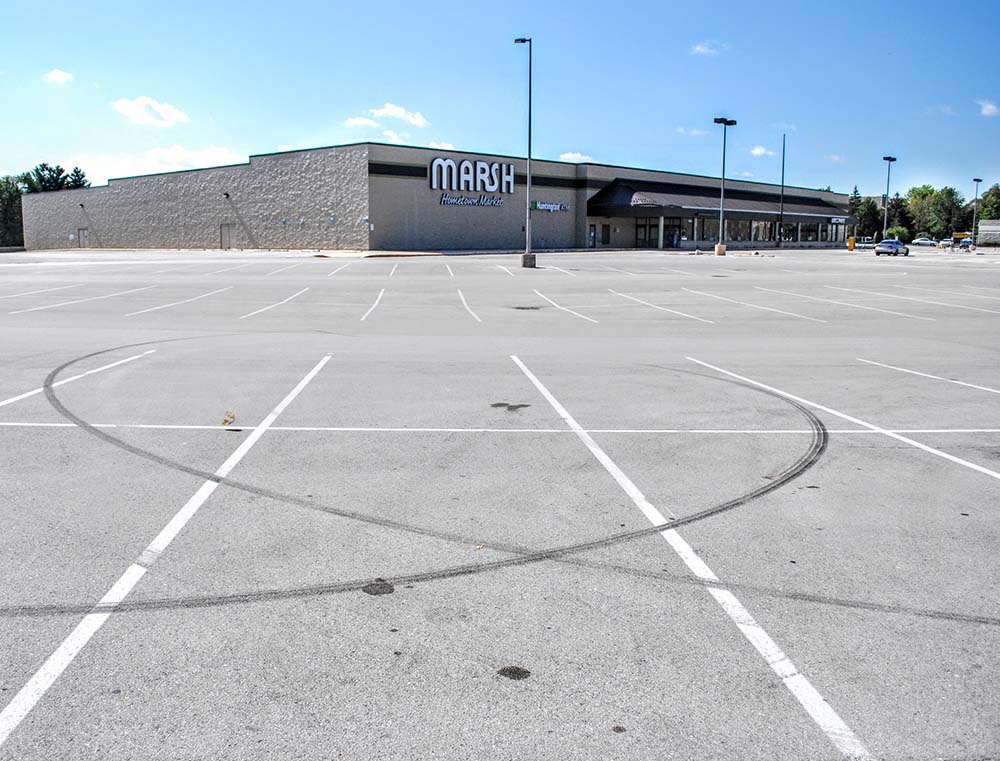
2019 Community Trends: Getting Groceries: Food Access Across Groups, Neighborhoods, and Time
Unai Miguel Andres MURP; Matt Nowlin, MURP; and Ross Tepe
When people do not have access to healthy food, this can impact their diet, their health, and their quality of life. Food deserts are a way of defining communities that lack healthy food access. These are neighborhoods with both low healthy food access and low income.
There are 208,000 people living in food deserts in Indianapolis. Importantly, 10,500 households without a car live in a “transit food desert,” with no grocery easily accessible by bus. The number of people in food deserts has risen by 10 percent since 2016, mostly driven by the closure of Marsh Supermarkets, one of Central Indiana’s major grocery chains.
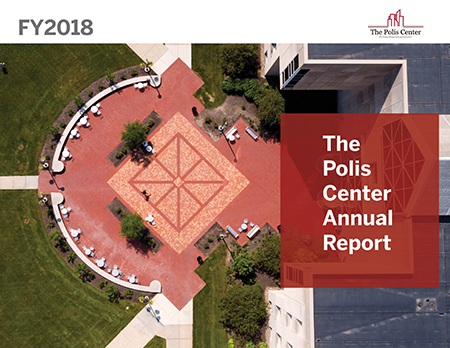
FY2018 Polis Center Annual Report
The Polis Center is engaged in ground-breaking work in a variety of activities important to Indiana communities and beyond. We managed more than 89 projects in FY2018 within our areas of emphasis; 54 percent of these projects were new grants or contracts. The following descriptions highlight our major accomplishments in each sphere of collaboration and in a major civic enterprise, the Spirit & Place Festival, which we launched in 1995 and now direct on behalf of IUPUI and the IU School of Liberal Arts.
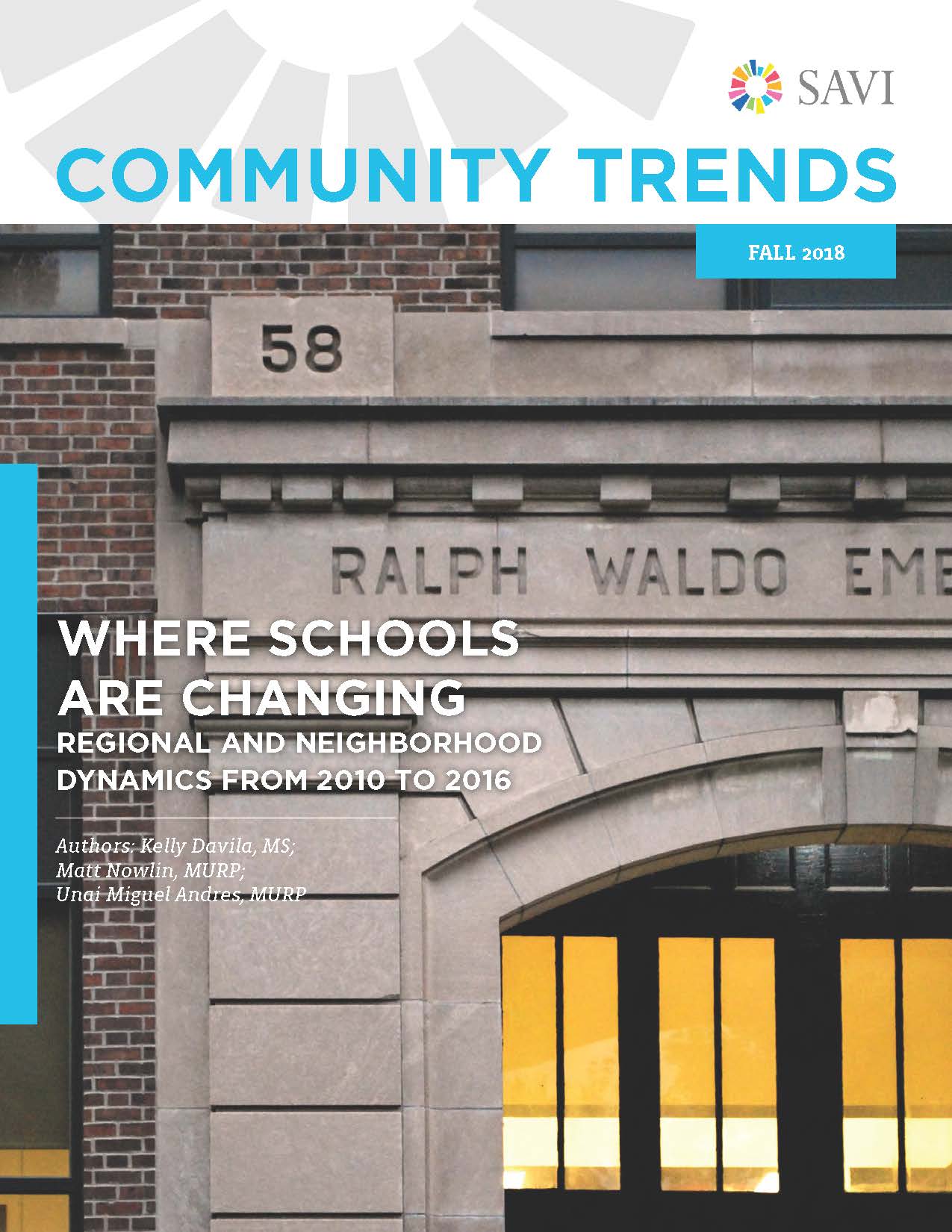
2018 SAVI Community Trends–Where Schools are Changing: Regional and Neighborhood Dynamics from 2010-2016
Kelly Davila, MS; Matt Nowlin, MURP; Unai Miguel Andres, MURP
Families often choose where to live based on neighborhood characteristics, especially the quality and reputation of nearby schools. But we live in a highly mobile society, in a rapidly changing region, and many of Central Indiana’s neighborhoods have seen significant change in their residents and their schools. A generalized understanding of school characteristics and how they change over time is complicated by the numerous metrics used to describe school quality and performance, as well as shifting policies governing school assessment and ratings. This report analyzes publicly available data at the school level to summarize key indicators of change and how that change can be understood at the community and regional levels. We used state-reported data from the 2009-2010 and 2015-2016 academic years to interpret these trends in the Indianapolis region. We performed analyses from three perspectives, 1) finding demographic changes at the school level that are indicative of neighborhood changes, 2) viewing regional trends that cut across district lines, and 3) analyzing the spatial characteristics of school change.
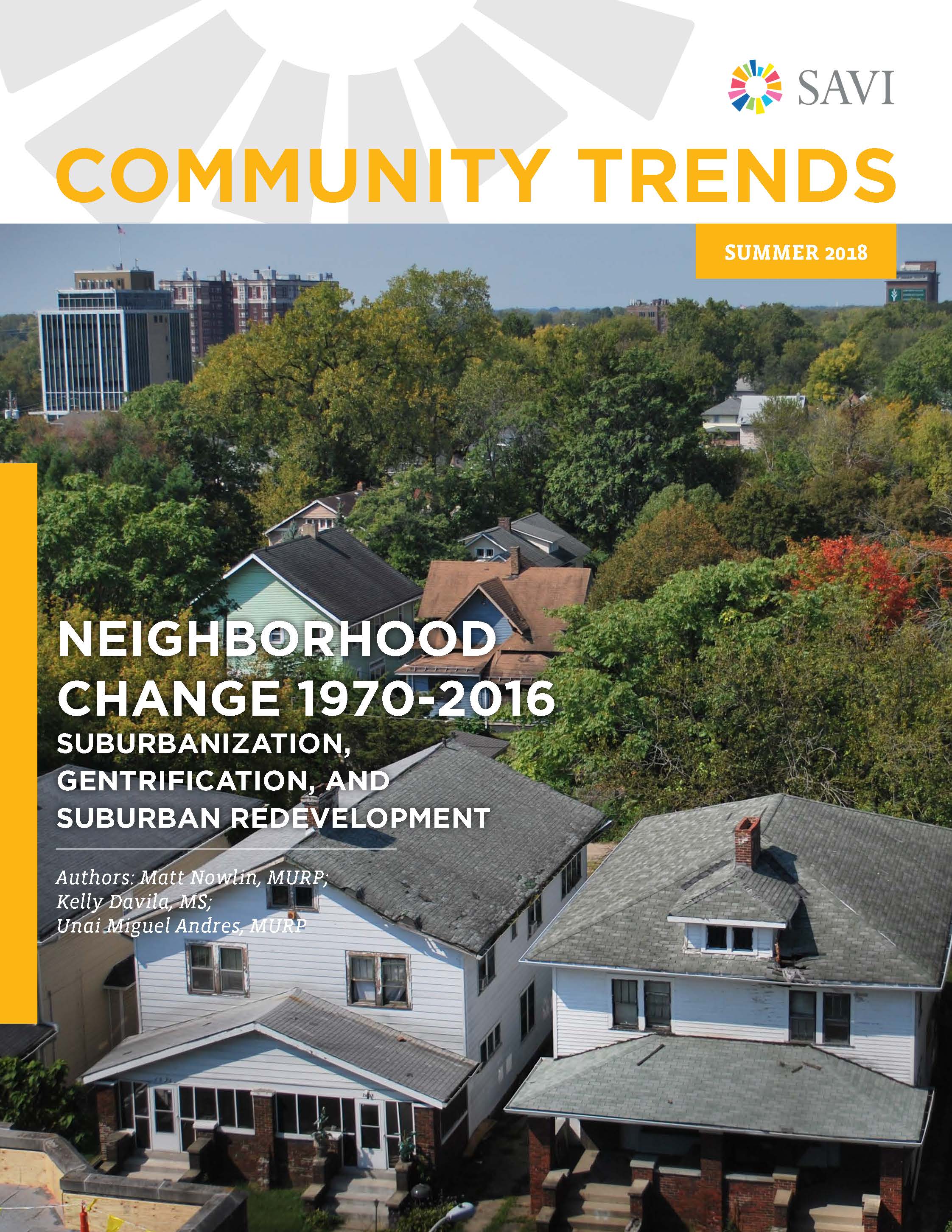
2018 SAVI Community Trends–Neighborhood Change 1970-2016: Suburbanization, Gentrification, and Redevelopment
Matt Nowlin, MURP; Kelly Davila, MS; Unai Miguel Andres, MURP
From 1970 to 2016, the forces of suburbanization and white flight, and the ensuing forces of urbanization, significantly changed neighborhoods across the Indianapolis region. White, educated, and middle- to upper-income households left the core of Indianapolis in the 1970s. They moved to the outskirts of Marion County and to other counties, enabled by the construction of Interstates 65 and 70 (fully complete by 1974), which made it easier to commute to Indianapolis from suburban areas. Racially discriminatory real estate practices like blockbusting, and lending practices like red-lining, encouraged white households to leave Indianapolis and prevented Black households from moving to new, suburban communities. Today, demand for communities with a mix of housing, shopping, and other uses3 has impacted urban and suburban communities differently. In some urban neighborhoods, this demand has translated to increases in the populations that can afford to move there: white, educated, and middle- to upper-income. In some suburban neighborhoods, demand for urbanization has led to the build-out of dense city centers.
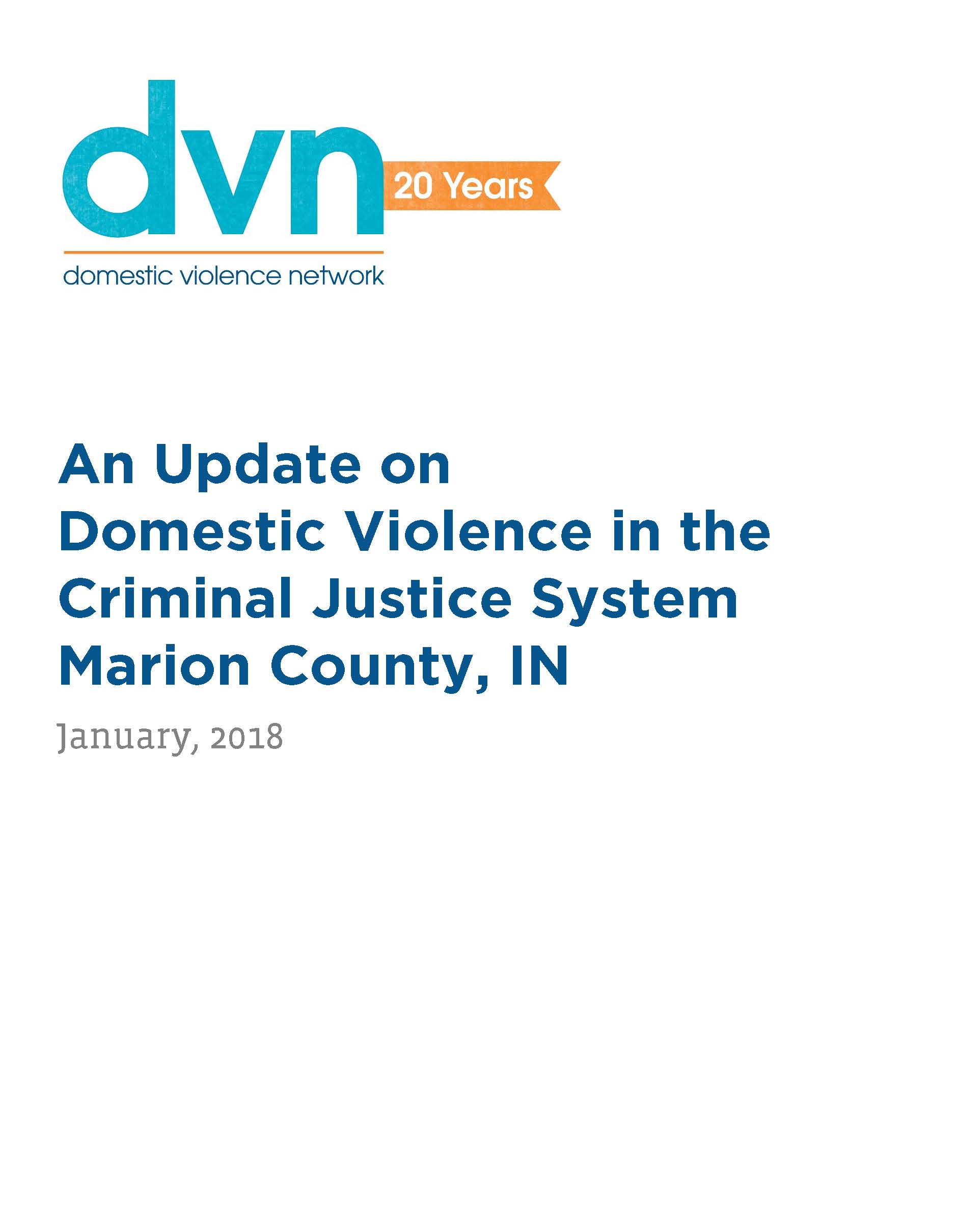
2018 Report–An Update on Domestic Violence in Marion County
The Polis Center produced this report as a part of a data integration, assessment, and analysis project for the Domestic Violence Network. The purpose of the project was to update and expand findings released in the November 2014 report to gain a better understanding of the state of domestic violence in Marion County. This project also builds the foundation for developing a public-facing web tool to summarize the findings of this report.
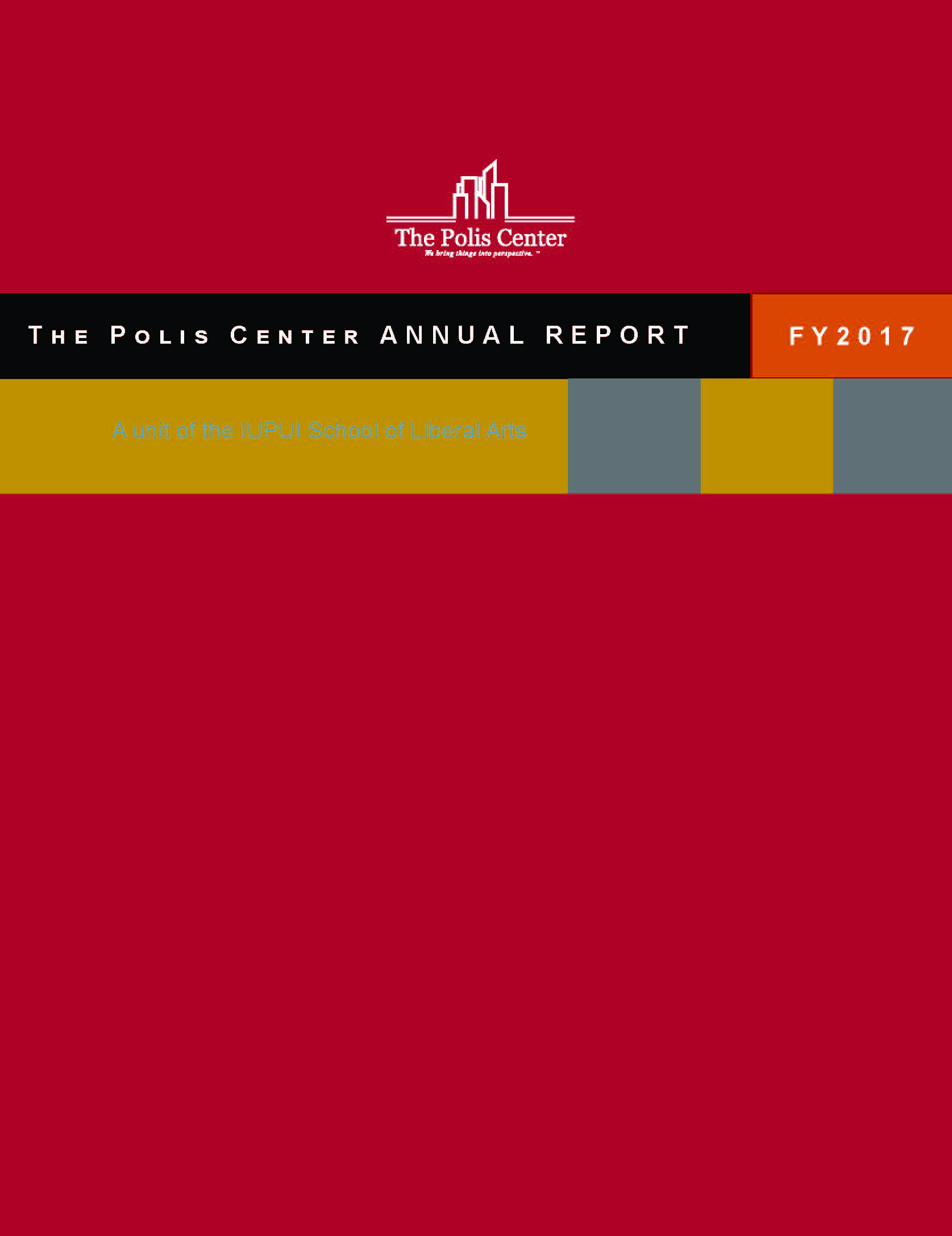
2017 Polis Center Annual Report
The Polis Center is engaged in innovative work in a variety of activities important to Indiana communities and beyond. We managed more than 65 projects in FY2017 within our areas of emphasis; 40 percent of these projects were new grants or contracts. The following descriptions highlights our major accomplishments in each area of emphasis and in the major civic enterprise, the Spirit & Place Festival, which we direct on behalf of IUPUI and the IU School of Liberal Arts.
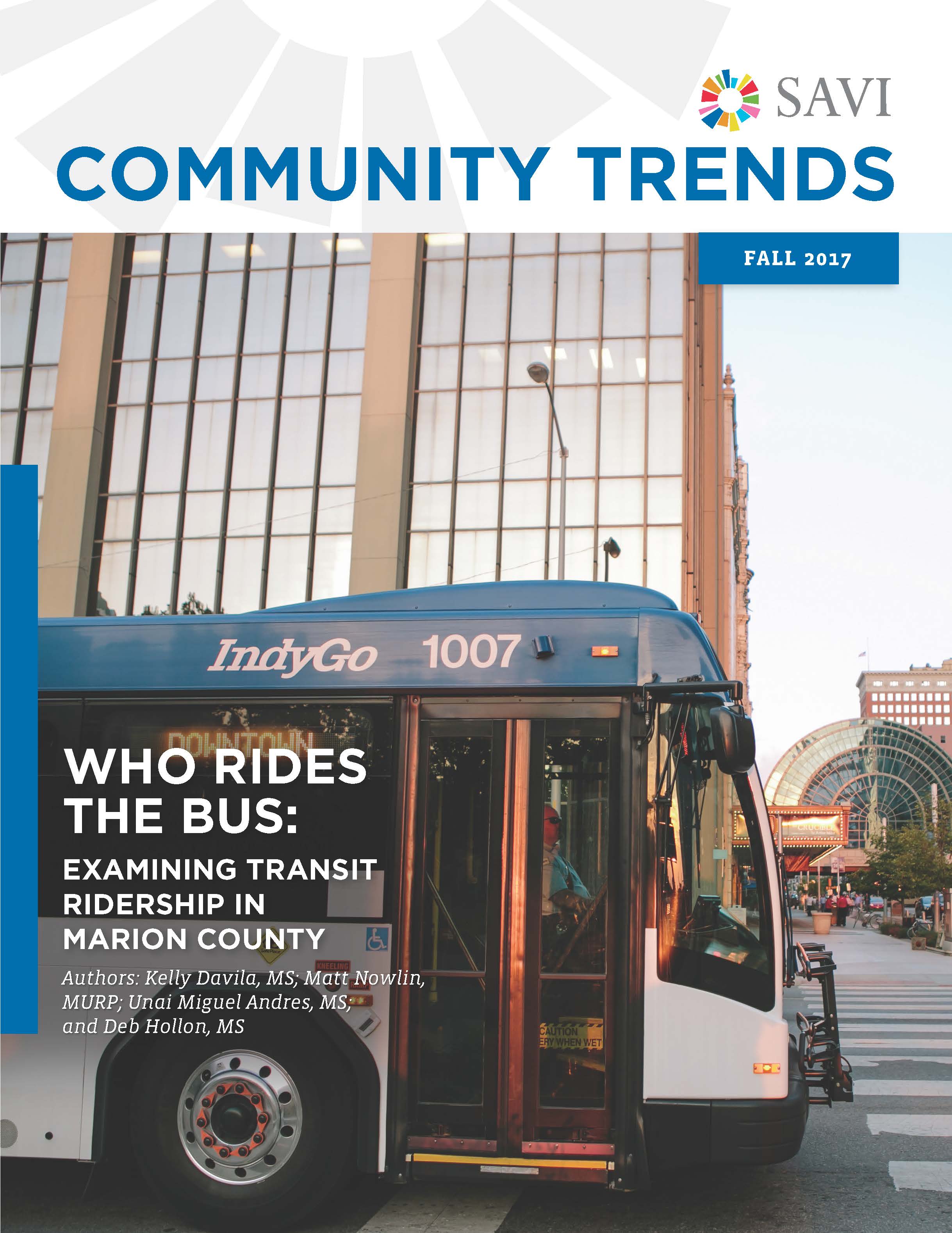
2017 SAVI Community Trends–Who Rides the Bus: Examining Transit Ridership in Marion County
Kelly Davila, MS; Matt Nowlin, MURP; Unai Miguel Andres, MS; and Deb Hollon, MS
Transportation is not limited to one’s ability to move from place to place; it is often essential for an individual or family’s economic and social mobility. Transit advances opportunity for economic mobility by providing affordable transportation to better jobs, more jobs, and reliable transportation to the jobs riders already have. It also promotes social mobility by providing transportation options for people without vehicles, youth under the driving age, seniors, and those who cannot or choose not to drive themselves. Moreover, public transit also reduces traffic congestion and the negative environmental impacts of single-occupancy automobile use, promotes smarter regional growth, and creates an affordable choice for making daily trips. This analysis clusters transit ridership into five groups (A-E) based on data from a recent ridership survey. Data from surveys are combined with neighborhood statistics, allowing us to consider the role of transit and the service it provides to our community’s diverse ridership. Approximately every five years, transit agencies conduct onboard surveys which typically include questions about riders’ transit behavior and other information about themselves. The responses are used to plan improvements to service and operations. The Indianapolis Metropolitan Planning Organization, in partnership with the Indianapolis Public Transit Corporation (IndyGo), most recently completed one of these surveys in October 2016.
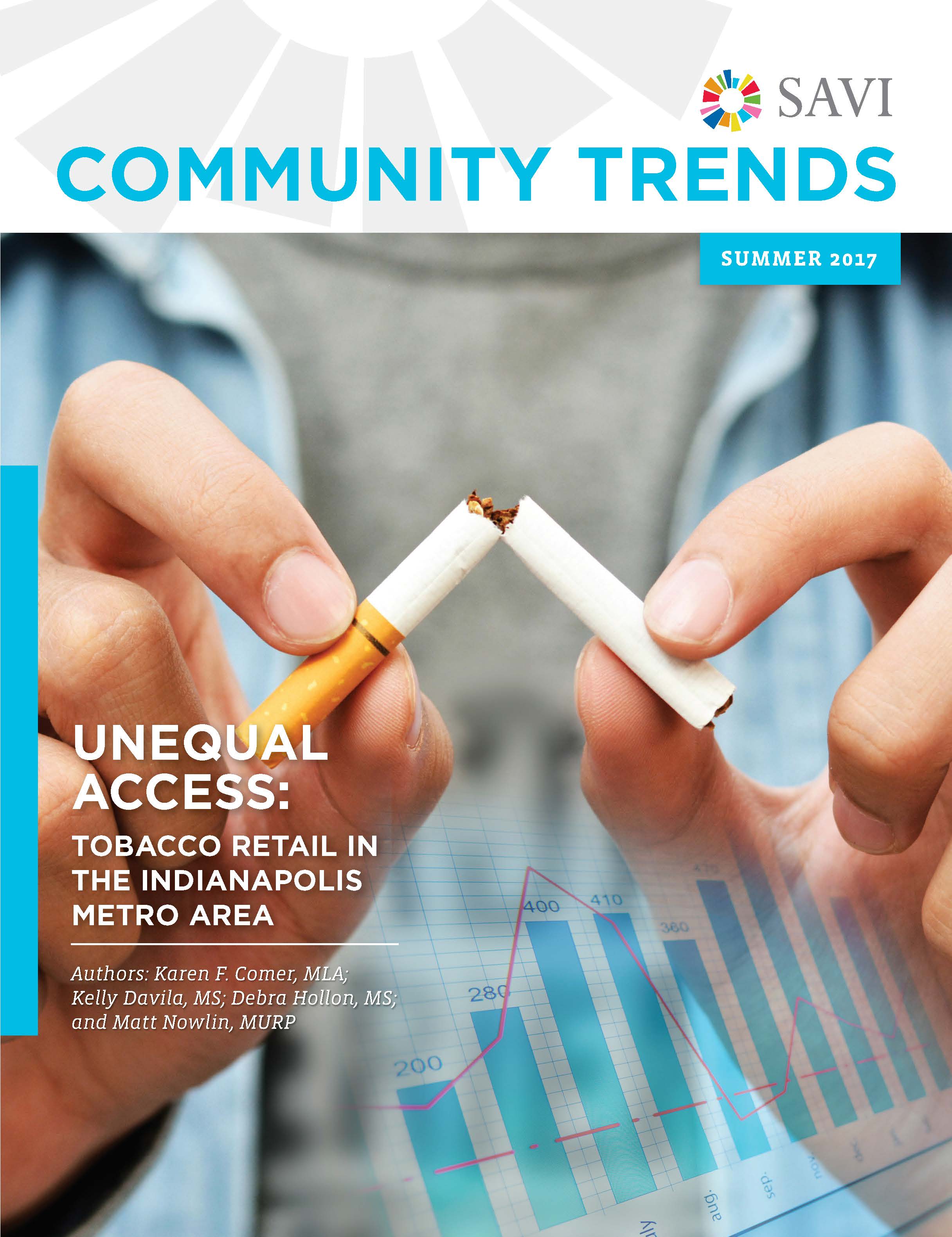
2017 Community Trends–Unequal Access: Tobacco Retail in the Indianapolis Metro Area
Karen Comer, Kelly Davila, Deb Hollon and Matt Nowlin
Retail access to various smoking products is an important consideration when discussing community action to improve a community’s health. Studies show that tobacco outlet density and proximity are linked to tobacco use–particularly in poor areas. We used socioeconomic data culled from the SAVI community information system to examine the density and proximity of tobacco outlets relative to vulnerable communities in Marion County. The report serves as a companion piece to the IU Richard M. Fairbanks School of Public Health’s September 2016 Report on the Tobacco Epidemic in Marion County and Indiana.
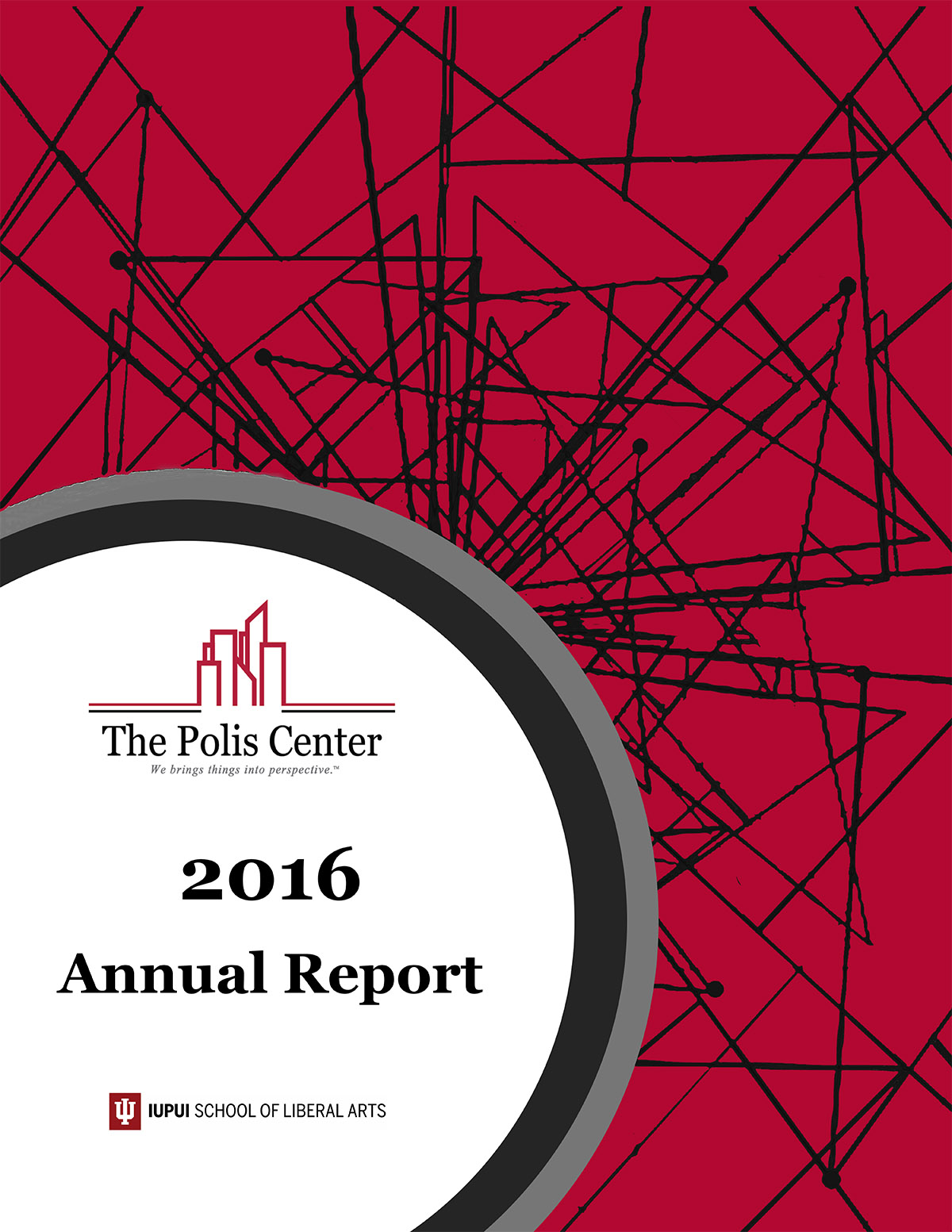
2016 Polis Center Annual Report
We managed more than 60 projects in FY2016 within our areas of emphasis; 50 percent of these projects were new grants or contracts. The following description highlights our major accomplishments in each area of emphasis and in the major civic enterprise, the Spirit & Place Festival, which we direct on behalf of IUPUI and the IU School of Liberal Arts.

2016 Community Trends–The Affordable Housing Market and Why It Matters
John Marron, Timothy Gondola, Kirstin Oaldon and Matt Nowlin
Financial stability for individuals and families is critical on many levels, providing a sense that one can, at minimum, consistently provide shelter and food. A living wage is a determining factor of economic stability; it is a path to quality education that provides marketable skills. Owning a home is often considered a reflection of a family’s financial health. This magazine’s feature story, “A Better Foundation: Building Economic Prosperity with Truly Affordable Housing,” highlights a central theme of the report, The Affordable Housing Market and Why It Matters: that affordable housing encompasses a broader range of economic issues than the price of a home. In addition, we share stories from area nonprofits that used SAVI data to help obtain funding for job training programs, and feature a new web tool, the community assessment and planning tool which allows users to develop custom and updatable research reports.
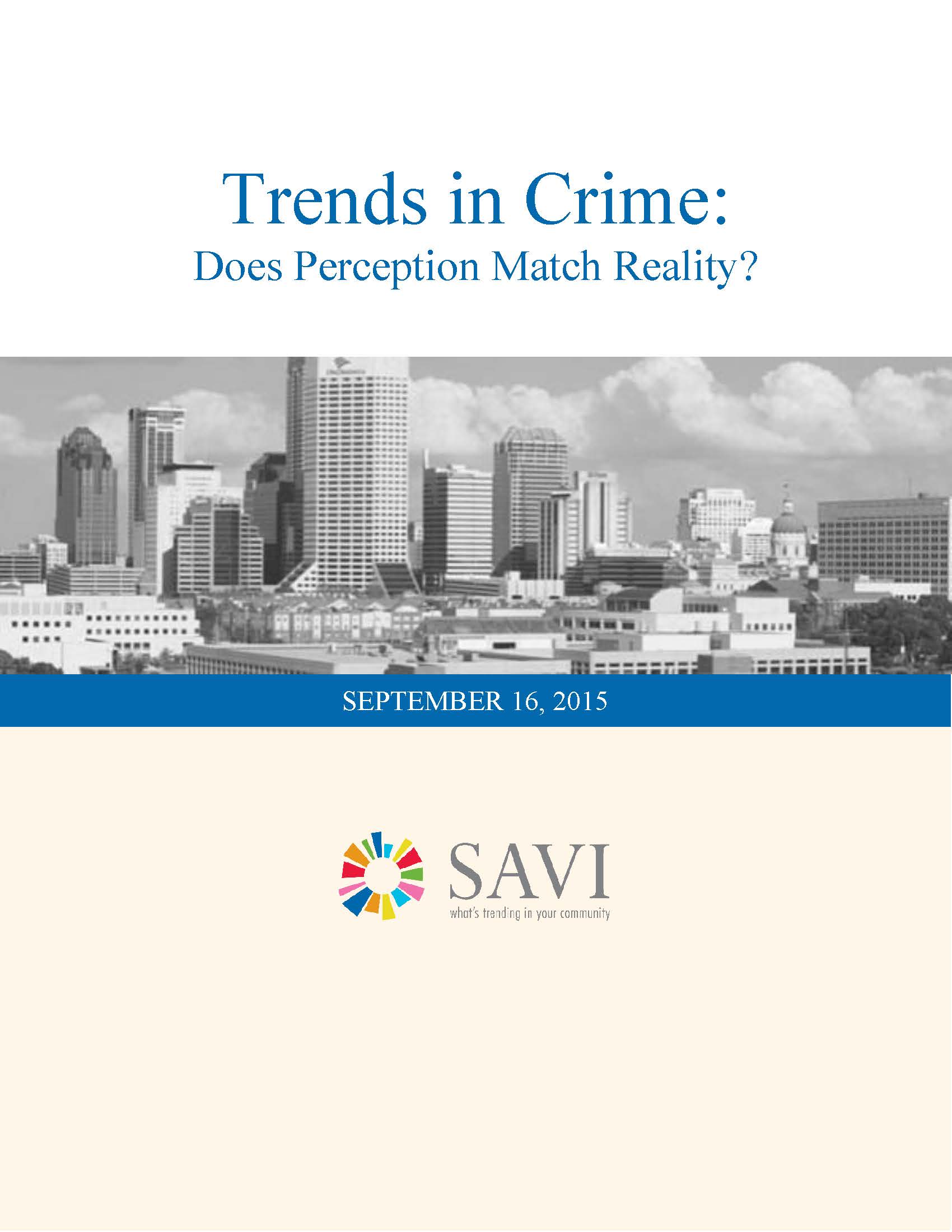
2015 SAVI Community Trends–Trends in Crime: Do Perceptions Match Reality?
Dr. Max Felker-Kantor and Sharon Kandris
Crime and public safety are important social and political issues faced by cities and communities across the country. Contrary to public perception, over the past two decades crime rates across the United States have decreased dramatically (Wolfers, 2014; McCarthy, 2015; Lopez, 2015). In 1994 the national Part I crime rate (the combination of property and violent crime) was 53 crimes per 1,000 people. In 2013, the rate was 31 crimes per 1,000 people, a decline of 41.5 percent. Yet, the story has not been the same across the country. When examining trends in crime at different geographic areas, such as counties, cities, or neighborhood the story becomes more complicated.
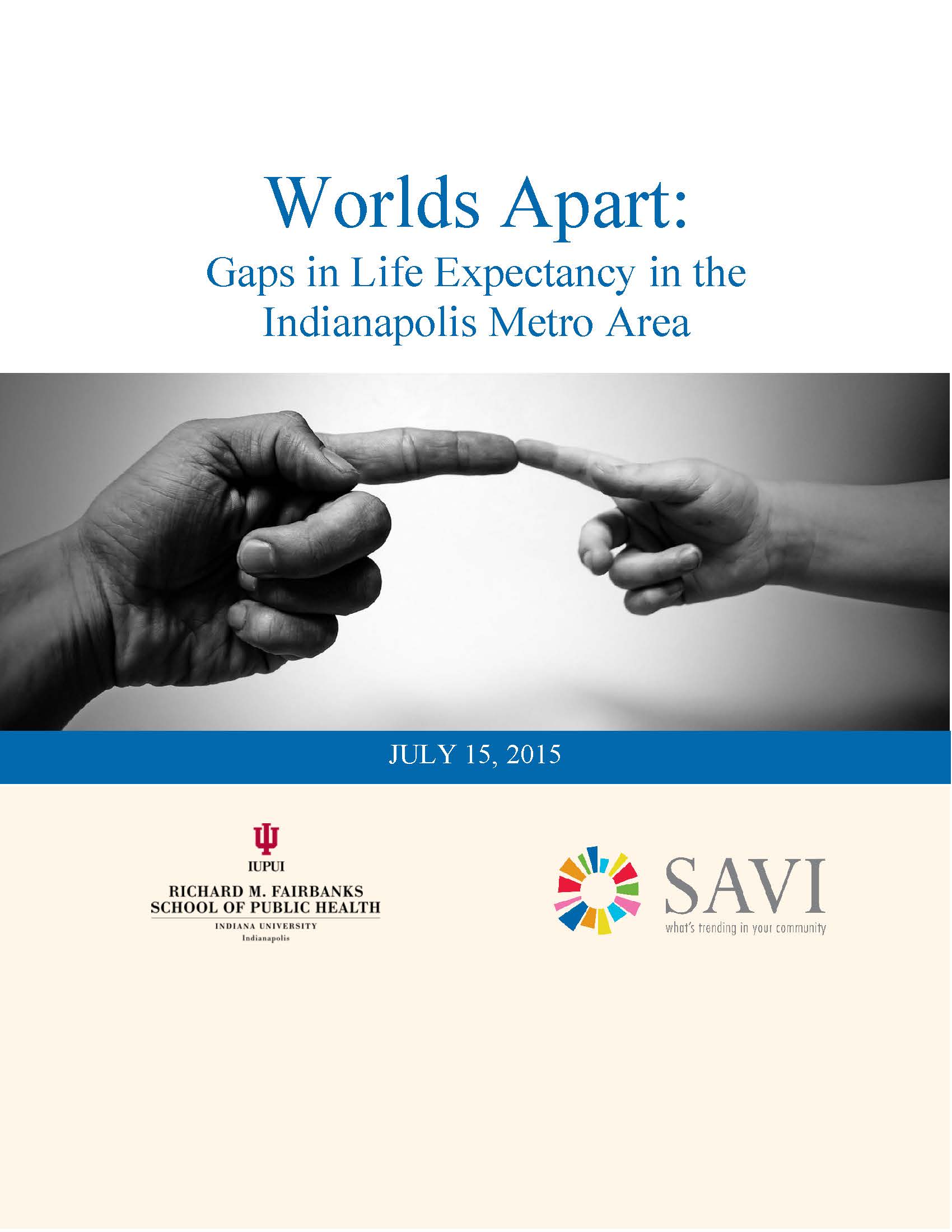
2015 SAVI Community Trends–Worlds Apart: Gaps in Life Expectancy in the Indianapolis Metro Area
TD Weathers, TGJ Leech, LK Staten, EA Adams, Jay Colbert and Karen Comer
Two communities that are both situated within the Indianapolis metropolitan area and separated by only 28 miles are in reality worlds apart. One sits in a northeastern suburb of Indianapolis. Its residents have a life expectancy of 83.7 years, rivaling the top-ranking countries of the world, Switzerland (83 years) and Japan (84 years). Taking a drive from that community along I-465 and I-70 into the city, life expectancy drops off – to 78.9 years, then to 74.2 years – until you arrive in the second community, situated within the urban core directly south of Monument Circle. Its residents have a life expectancy of 69.4 years, similar to countries like Uzbekistan (69 years), Bangladesh (70 years), and Iraq (70 years). In this analysis, we explore why and share results of our analysis of life expectancy across the 11 counties and more than 100 ZIP codes in the Indianapolis metro area.
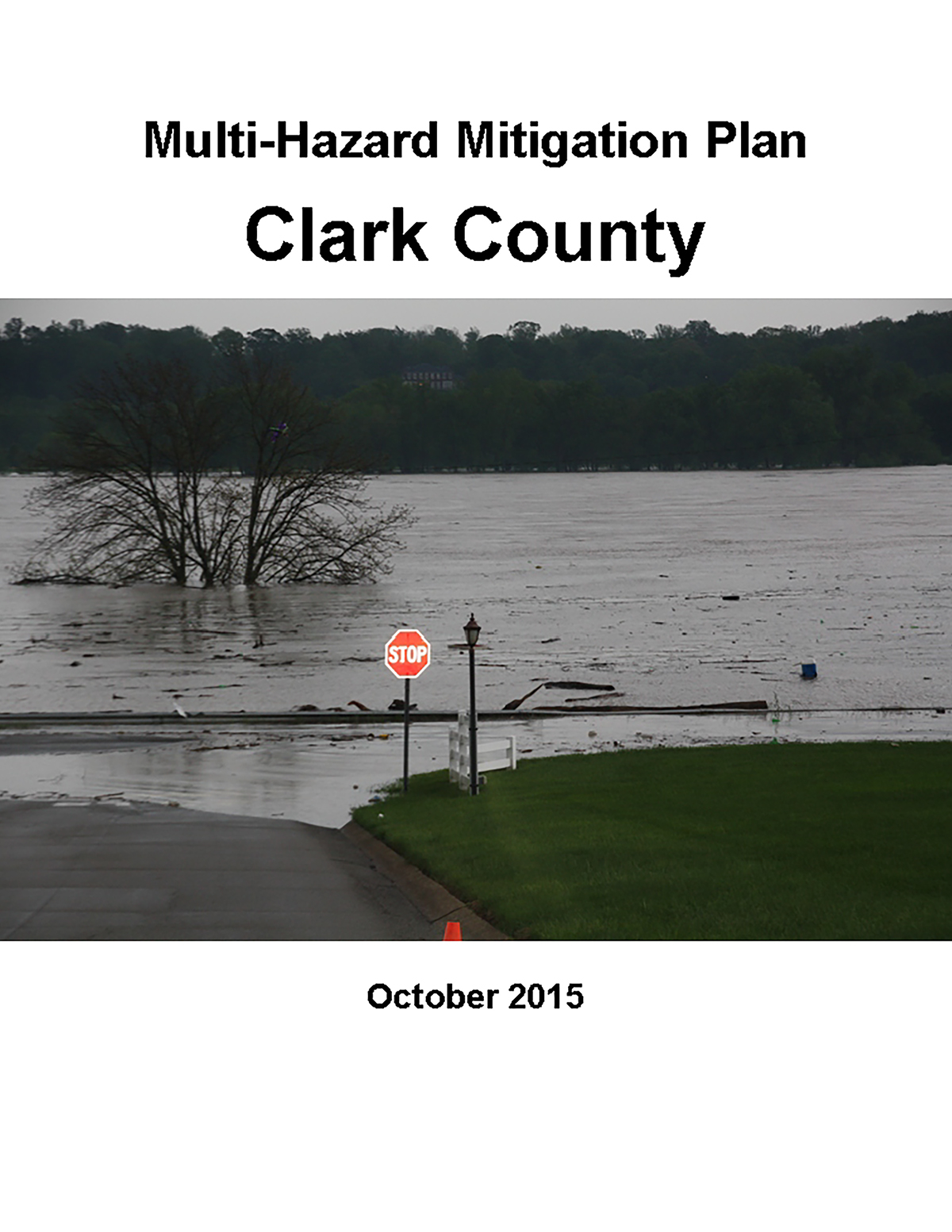
2015 Clark County Multihazard Mitigation Plan
Clark County’s multi-hazard mitigation plan was developed in 2008 and updated in 2015 by The Polis Center at Indiana University Purdue University-Indianapolis (IUPUI). The Clark County Emergency Management Agency would like to thank The Polis Center, River Hills Economic Development District and Regional Planning Commission (River Hills EDD & RPC), and the Clark County Multi-Hazard Mitigation planning team for their contributions and assistance in development of the 2015 Clark County multihazard mitigation plan update. Through the combined efforts, input and support of these organizations, Clark County continues to build its capacity to prevent, protect against, respond to, and recover from disasters.
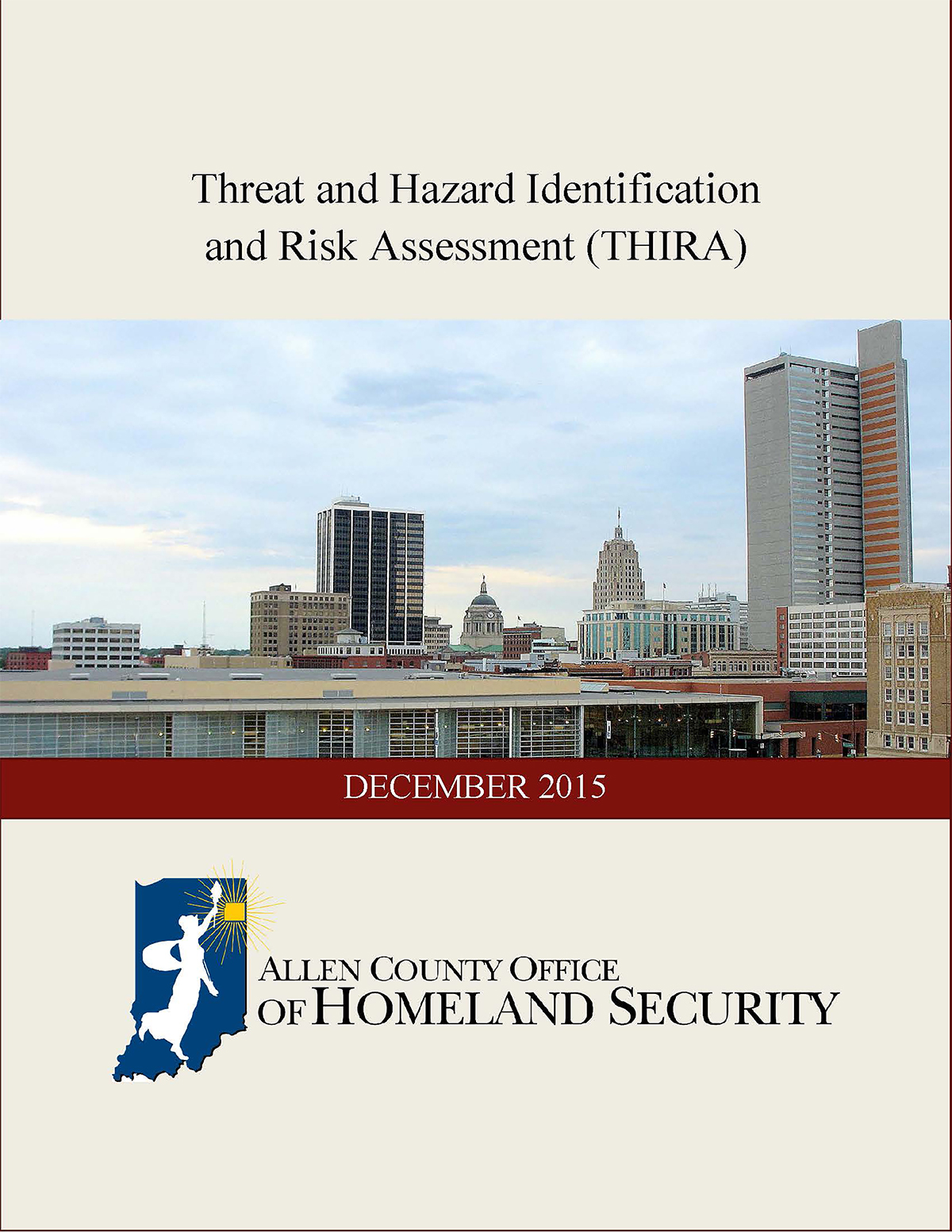
2015 Allen County, Indiana Threat and Hazard Identification Risk Assessment Report
The Allen County Threat and Hazard Identification and Risk Assessment (THIRA) is an all-hazards planning tool designed to help the county understand the full-range of its risks and estimate
capability requirements for the whole community including individuals, businesses, faith-based organizations, nonprofit organizations, schools and academia, and all levels of government.
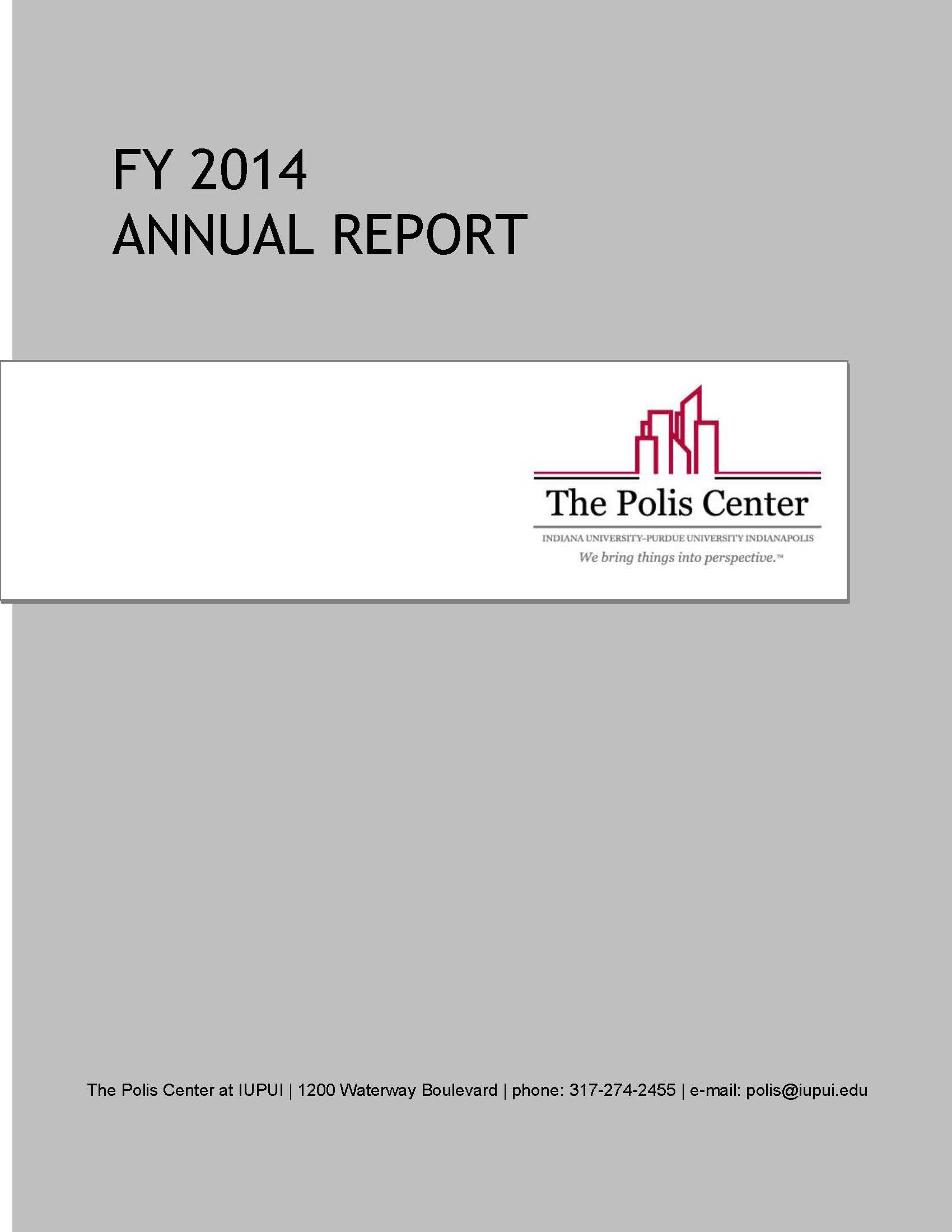
2014 Annual Report
We managed more than 95 projects in FY 2014 within our areas of emphasis; 48 percent of these projects were new grants or contracts. The following description highlights our major accomplishments in each area of emphasis and in a major civic enterprise, the Spirit &Place Festival, which we direct on behalf of IUPUI and the IU School of Liberal Arts.
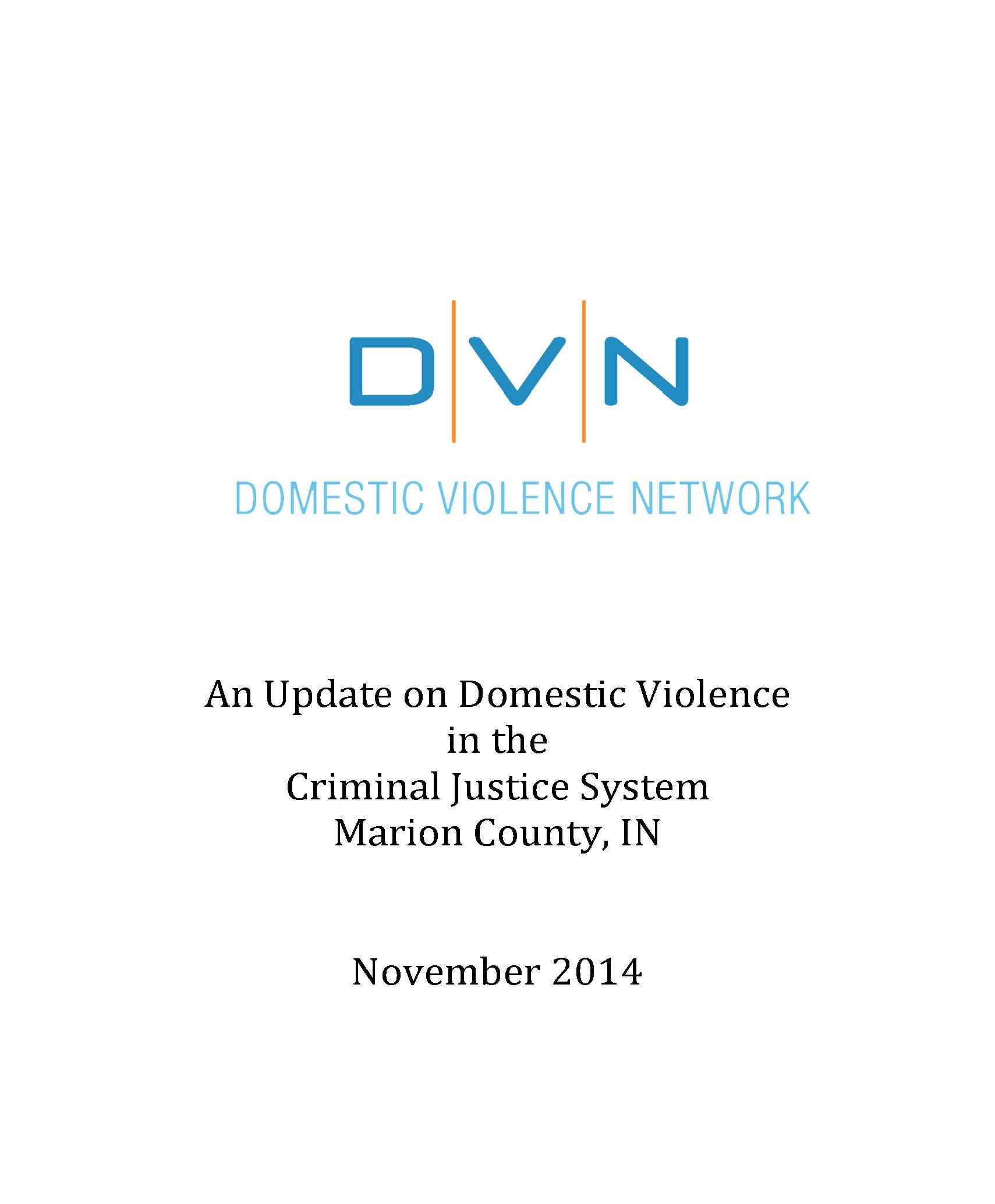
2014 Report–Update on Domestic Violence in the Criminal Justice System, Marion County, IN
Up to now, it has been very difficult to generate statistics describing the state of domestic violence in Marion County. This report presents the findings of a feasibility study conducted by The Polis Center at IUPUI for the Domestic Violence Network to link data from four sources that collect information on victims and perpetrators of domestic violence in the legal system, including The Julian Center, Indianapolis Metropolitan Police Department (IMPD), Marion County Prosecutor’s Office, Indiana Supreme Court. The purpose of the project was to demonstrate the feasibility of integrating the domestic violence data, given the quality and incompleteness of some of the required data sets, and to determine what analysis and reporting are possible given these limitations. Data had to be cleaned and standardized to ensure comparability across the data sets, and an algorithm was developed to identify unique individuals across all data sets. The result is a report of statistics representing the picture of domestic violence for incidents where the legal system is involved. This does not count all of the incidents that go un-reported.
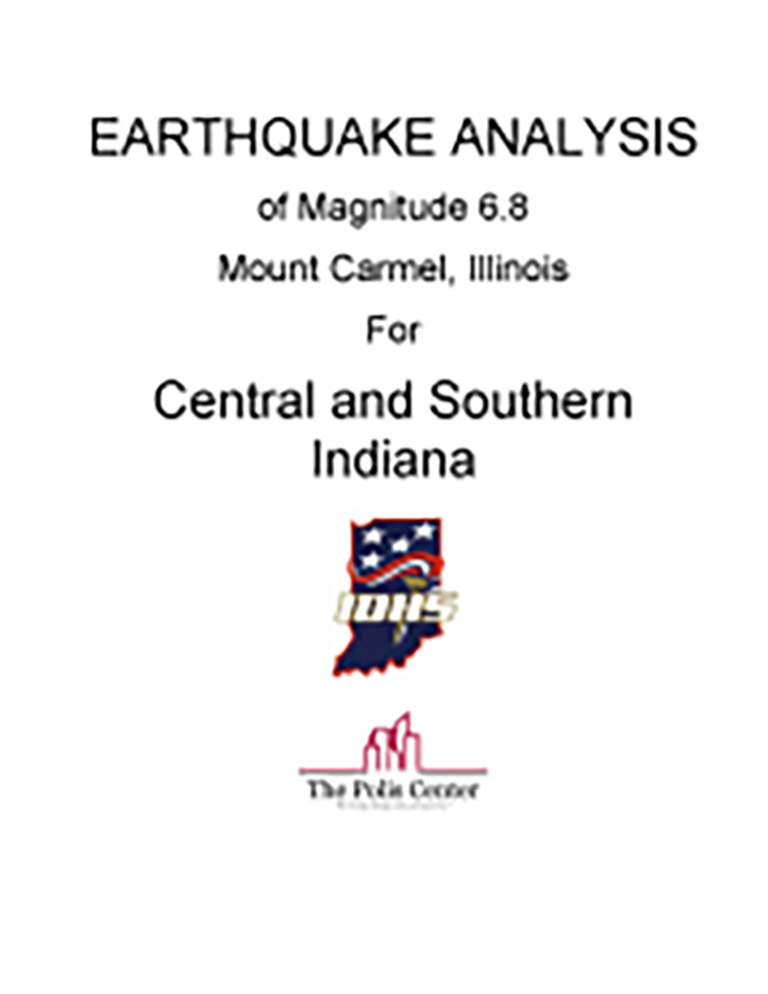
2014 Earthquake Analysis of Magnitude 6.8 Mount Carmel Illinois for Central and Southern Indiana Action Discovery Report
At the request of Indiana Department of Homeland Security (IDHS) Planning Division, The Polis Center performed an enhanced (Hazus Level 2) earthquake analysis for IDHS Regions 5, 7, 8, and 10 comprising 35 counties in southern and central Indiana. For the purposes of this study, the Indiana Geological Survey (IGS) provided geological information and recommendations for
modeling a 6.8 moment magnitude scenario with an epicenter at Latitude 38.41088, Longitude -87.761417, which is located in Mt. Carmel, Illinois. This scenario was chosen by the Indiana
Geological Survey to simulate a Wabash Valley earthquake. The epicenter is also the location of the recent May 2010 earthquake.
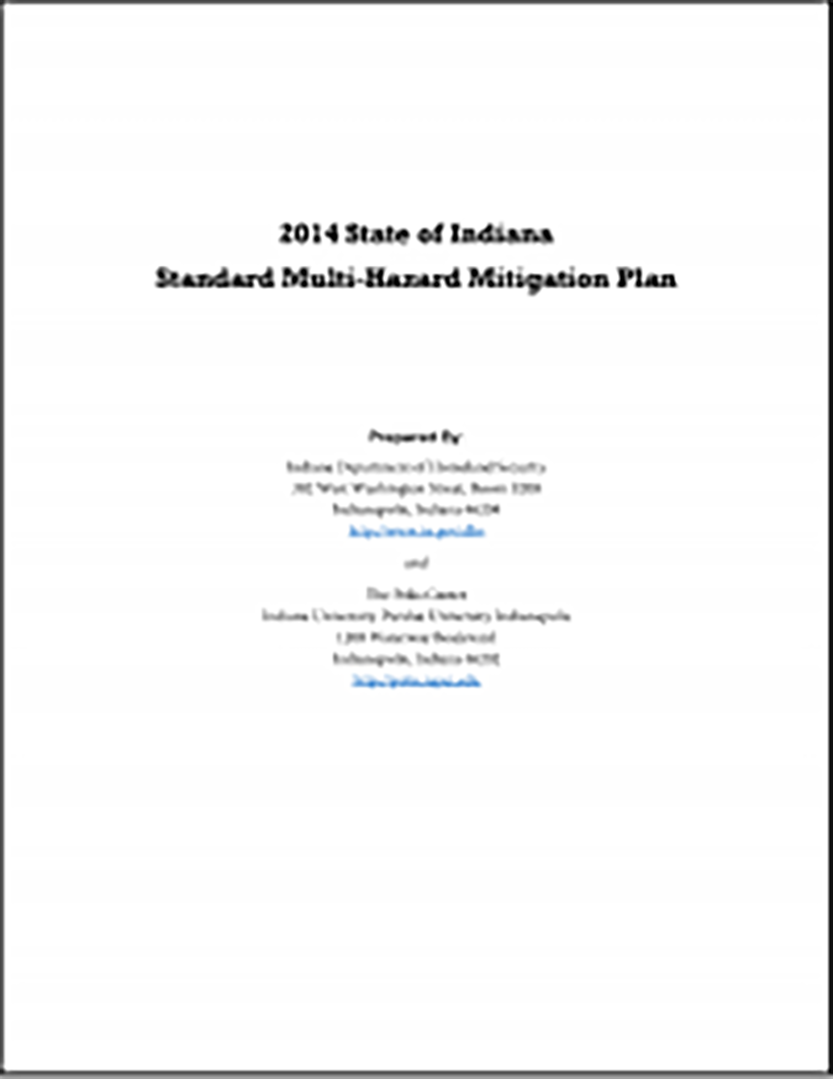
2014 Indiana Multi-Hazard Mitigation Plan
The Indiana Standard Hazard Mitigation Plan was developed in collaboration with government, academic, and private entities for the purpose of preventing, protecting against, responding to, and recovering from disasters that may threaten the state’s citizens, infrastructure, and economy. Following the adoption of the last version of this plan in 2011, the Indiana Department of Homeland Security (IDHS) partnered with The Polis Center (Polis) at Indiana University-Purdue University Indianapolis to overhaul the plan and develop a more comprehensive, risk-based approach for assessing the vulnerabilities of the state and its communities. Every section of the plan has been revised with the most current available data.
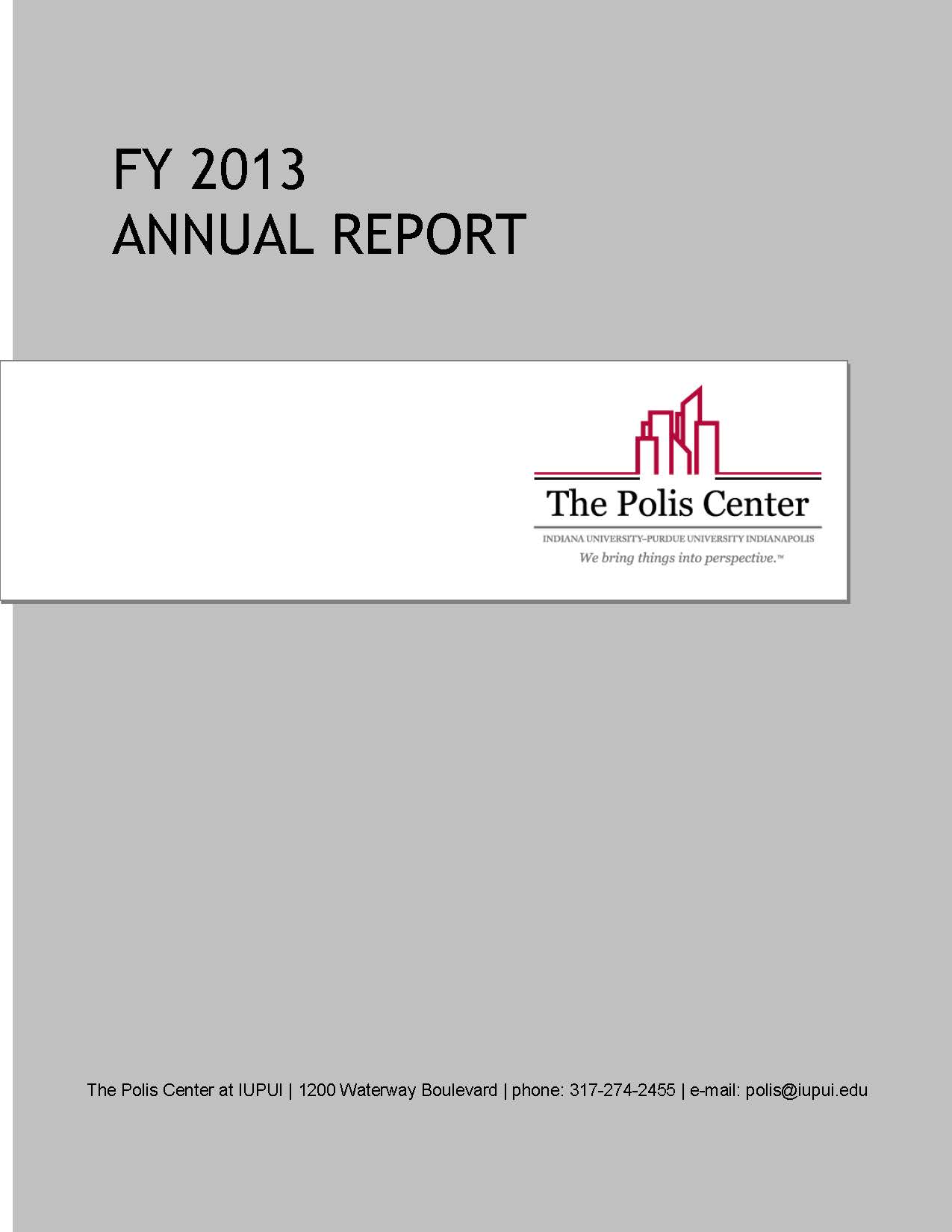
2013 Polis Center Annual Report
We managed more than 79 projects in FY 2013 within our areas of emphasis; 50 percent of these projects were new grants or contracts. The following description highlights our major accomplishments in each area of emphasis and in a major civic enterprise, the Spirit &Place Festival, which we direct on behalf of IUPUI and the IU School of Liberal Arts.

2013 NSDI Cooperative Agreements Program: Geospatial Platform Cloud Service Test Bed
The primary objective of this project is to evaluate the technical issues, opportunities, and costs associated with deployment and geoprocessing of IndianaMap Cadastral data in Amazon Cloud Platforms. The IndianaMap portals were developed to provide a central single-source repository of data to support transportation planning, economic development, environmental assessment, and emergency response. The Indiana Office of Technology (IOT) working with the Indiana Department of Homeland Security (IDHS), and the Indiana Geographic Information Council (IGIC) have developed a strategy for creating a seamless parcel map for Indiana. Indiana IOT harvests parcel data from county web feature services monthly. The process includes integrated Spatial ETL (Extract, Transform, and Load) tools to build a seamless state-wide parcel feature class. Currently 85 of 92 counties containing 3,225,000 parcels are included in the statewide layer.
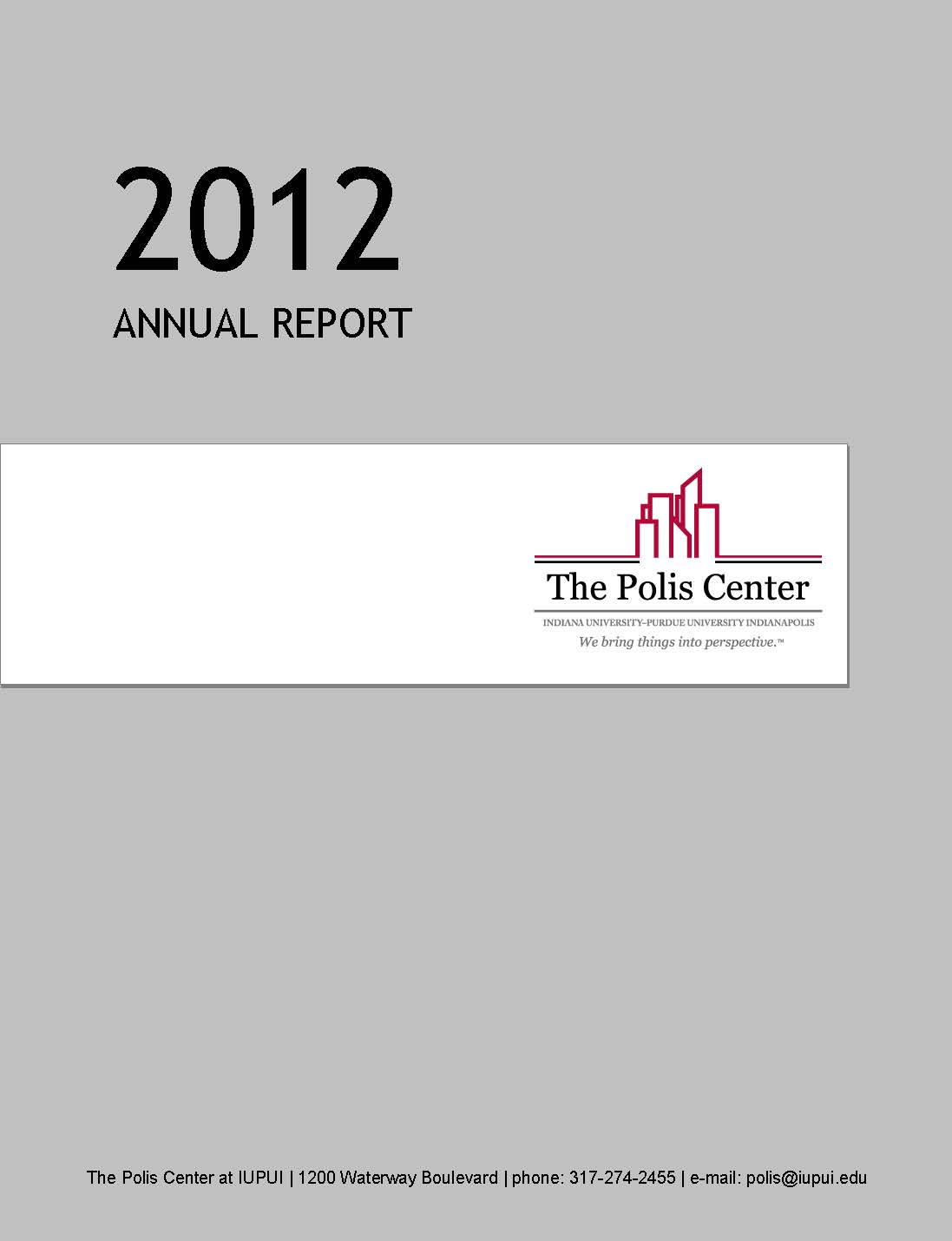
2012 Polis Center Annual Report
We managed more than 60 projects in FY2012 within our areas of emphasis; 63 percent of these projects were new grants or contracts. The following description highlights our major accomplishments in each area of emphasis and in a major civic enterprise, the Spirit &Place Festival, which we direct on behalf of IUPUI and the IU School of Liberal Arts.
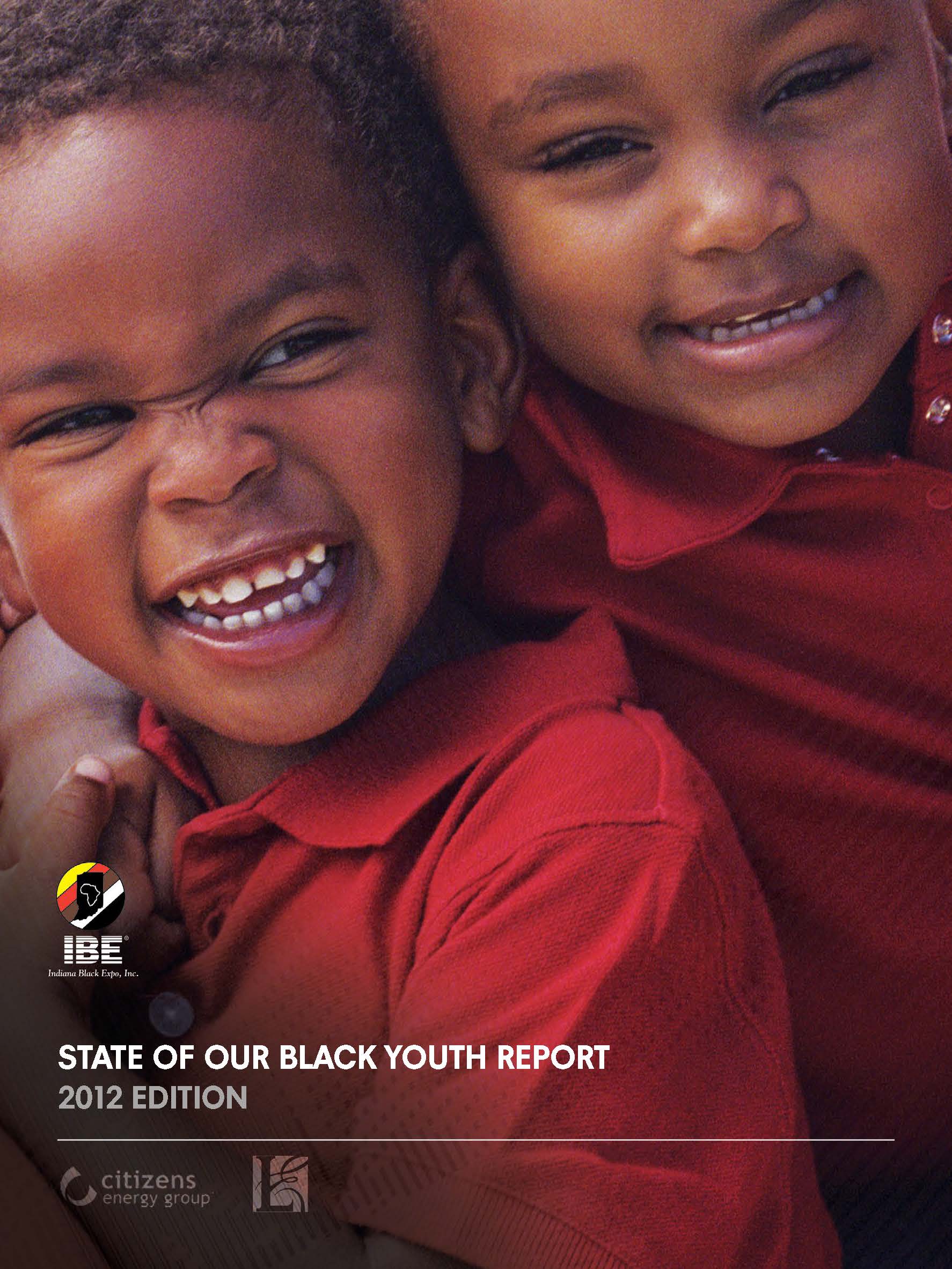
2012 Report–State of Our Black Youth
Indiana Black Expo, Inc.’s 2012 State of Our Black Youth Report (SOBY) presents statewide data on the health and well-being of Indiana’s Black youth, as well as local data for the following 16 communities: Anderson, East Chicago, Elkhart, Evansville, Fort Wayne, Gary, Hammond, Indianapolis, Jeffersonville, Kokomo, Lafayette, Marion, Michigan City, Muncie, South Bend and Terre Haute. The 2012 report, third in the series, provides updates for data contained in the 2005 and 2007 reports, as well as data for new indicators. Additionally, the report offers recommended strategies and promising practices to consider when addressing challenges and enhancing strengths identified by the data.
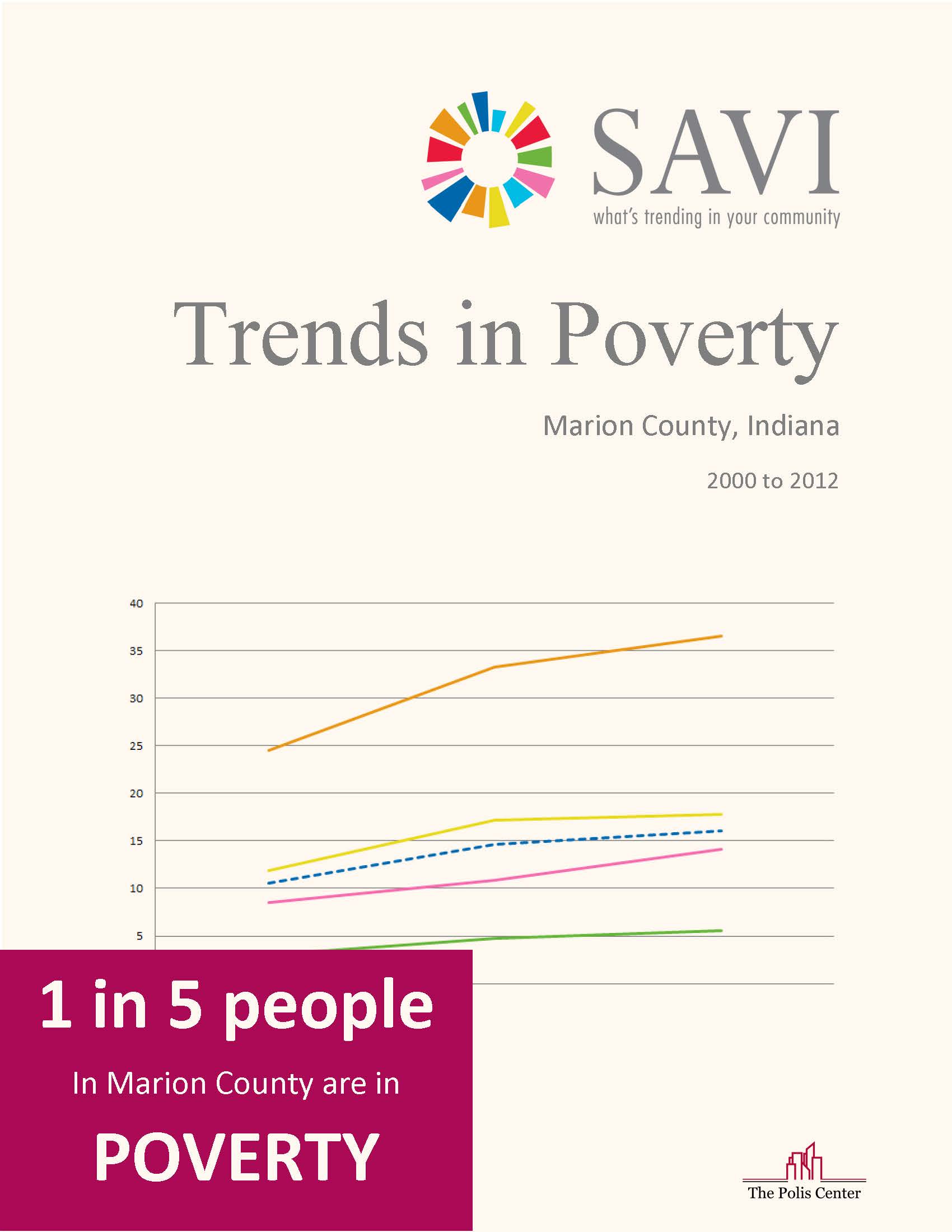
2000-2012 SAVI Report–Trends in Poverty, Marion County
Poverty is on the rise across the board, but some segments of the population are disproportionately affected. This report looks at the disparities in poverty by age, race, gender, education levels, and geography.
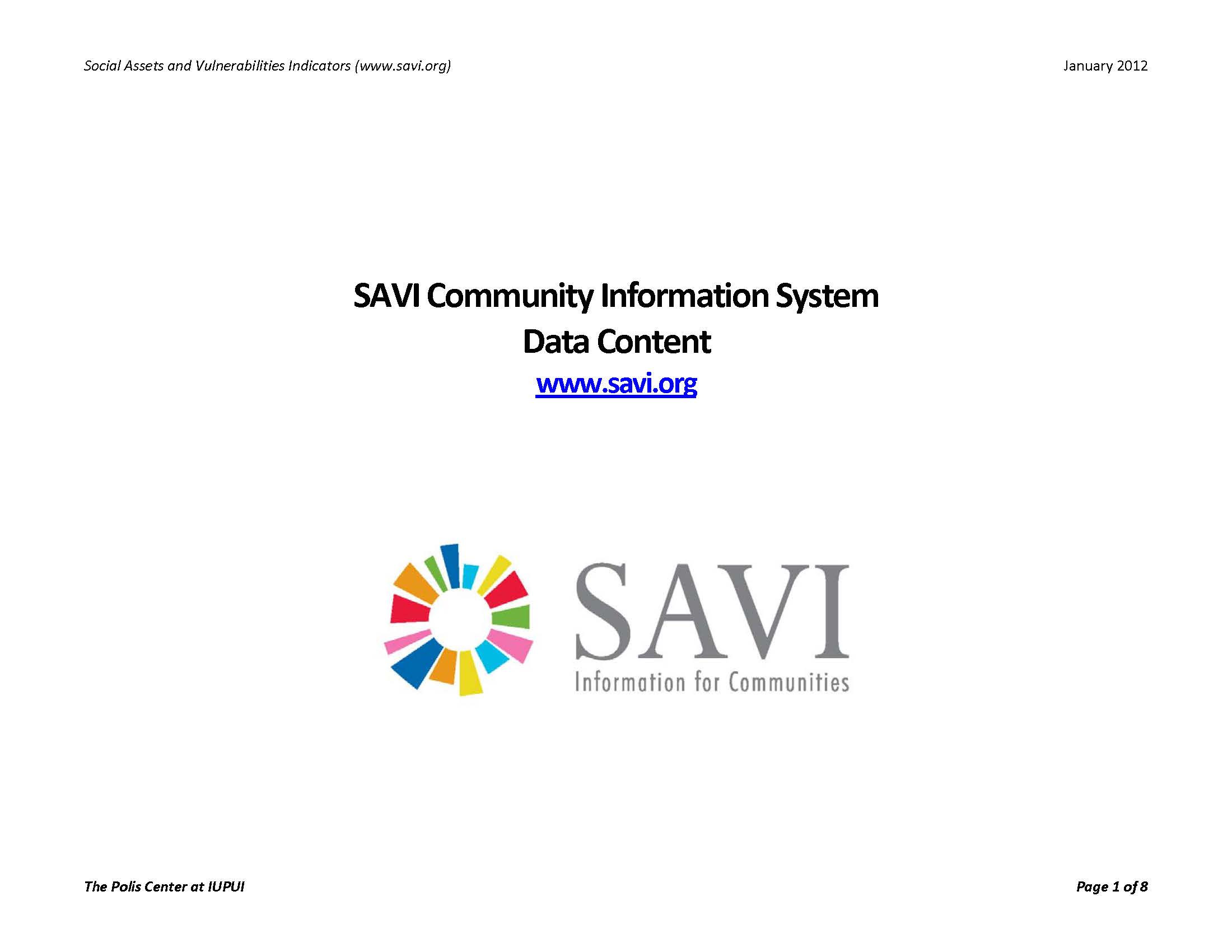
2012 SAVI Community Information System Data Content
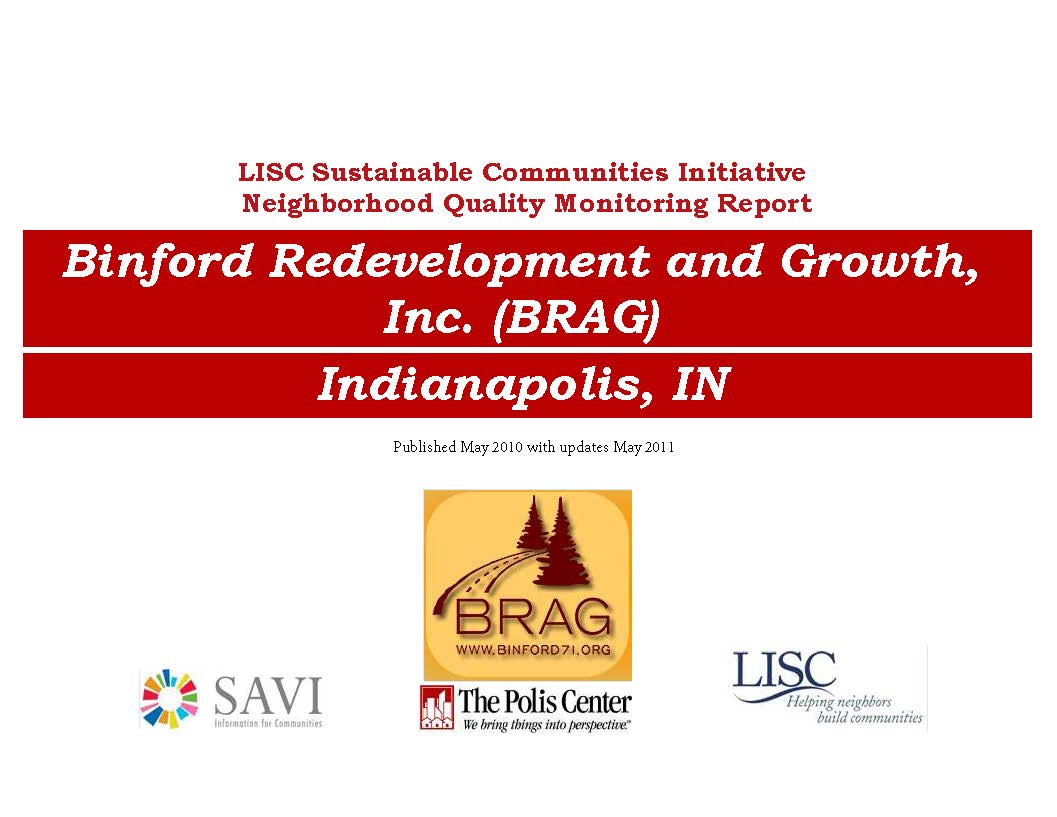
SAVI Report–2011 LISC Sustainable Communities Initiative Neighborhood Quality Monitoring Report: Binford Redevelopment and Growth, Inc.
The Local Initiatives Support Corporation (LISC) Sustainable Communities Initiatives supports community-driven efforts to revitalize neighborhoods through comprehensive
community development. In 2006, Indianapolis launched the Great Indy Neighborhoods Initiative (GINI) to promote healthy communities through comprehensive quality of life
planning and development. This effort has resulted in several programs and targeted investments in six demonstration sites throughout the city. This report is intended to help local
funders, civic and neighborhood leaders, and LISC staff monitor change in these areas of concentrated investment by providing local data and indicators of quality of life in one of the
six target neighborhoods, Binford Redevelopment and Growth, Inc. (BRAG).
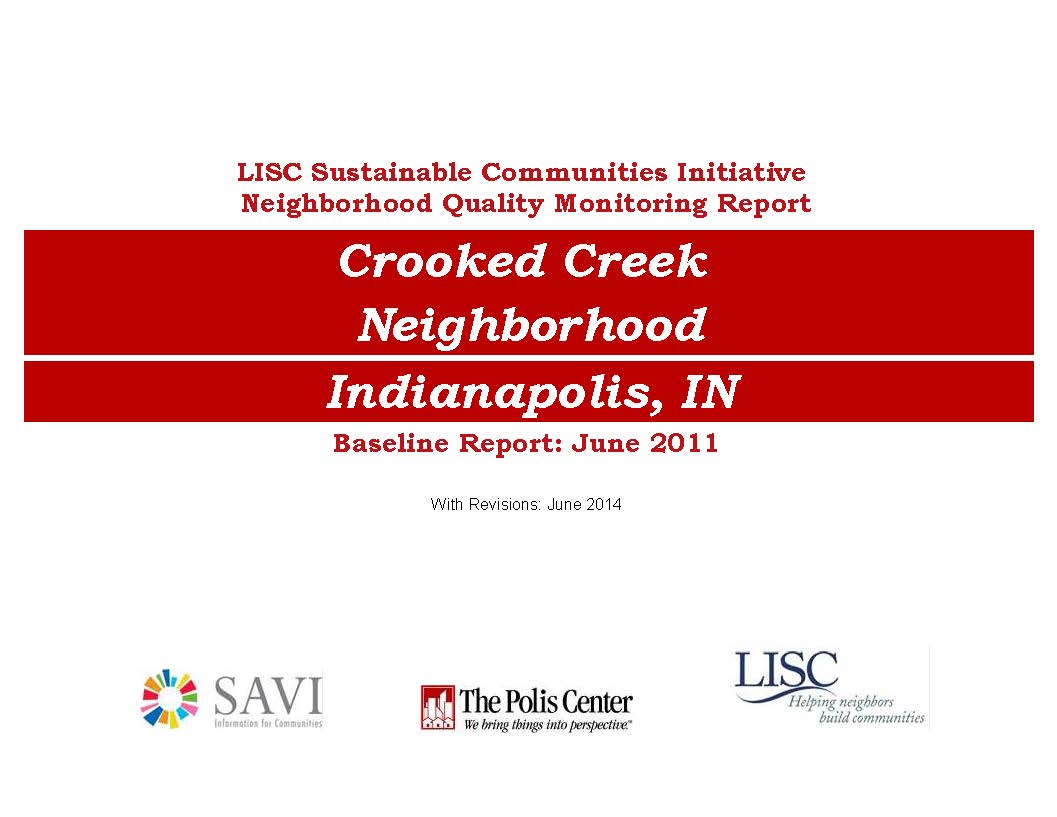
SAVI Report–2011 LISC Sustainable Communities Initiative Neighborhood Quality Monitoring Report: Crooked Creek
The Local Initiatives Support Corporation (LISC) Sustainable Communities Initiative supports community-driven efforts to revitalize neighborhoods through comprehensive community
development. In 2006, Indianapolis launched the Great Indy Neighborhoods Initiative (GINI) to promote healthy communities through comprehensive quality of life planning and
development. This effort has resulted in several programs and targeted investments in six demonstration sites throughout the city. This report is intended to help local funders, civic
and neighborhood leaders, and LISC staff monitors change in these areas of concentrated investment by providing local data and indicators about the quality of life in one of the six
demonstration neighborhoods, Crooked Creek.
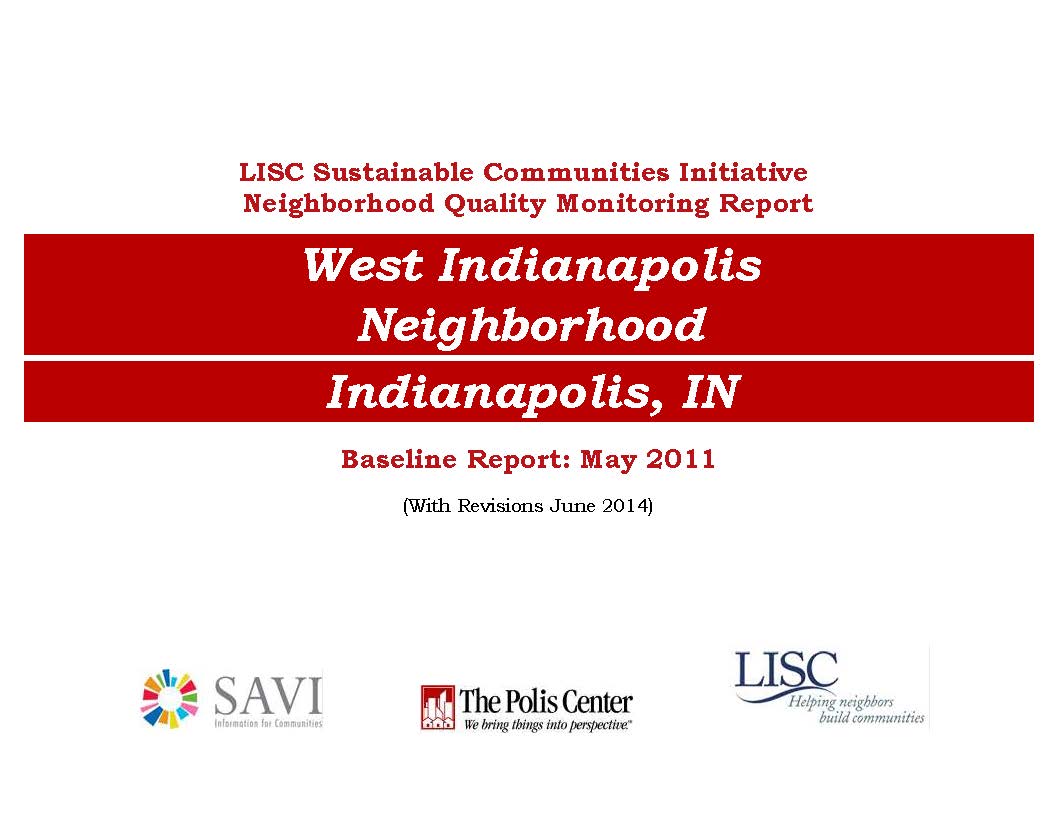
SAVI Report– 2011 LISC Sustainable Communities Initiative Neighborhood Quality Monitoring Report: West Indianapolis
The Local Initiatives Support Corporation (LISC) Sustainable Communities Initiatives supports community-driven efforts to revitalize neighborhoods through comprehensive
community development. In 2006, Indianapolis launched the Great Indy Neighborhoods Initiative (GINI) to promote healthy communities through comprehensive quality-of-life
planning and development. This effort has resulted in several programs and targeted investments in six demonstration sites throughout the city. This report is intended to help local
funders, civic and neighborhood leaders, and LISC staff monitor change in these areas of concentrated investment by providing local data and indicators of quality-of-life in one of the
six target neighborhoods, West Indianapolis
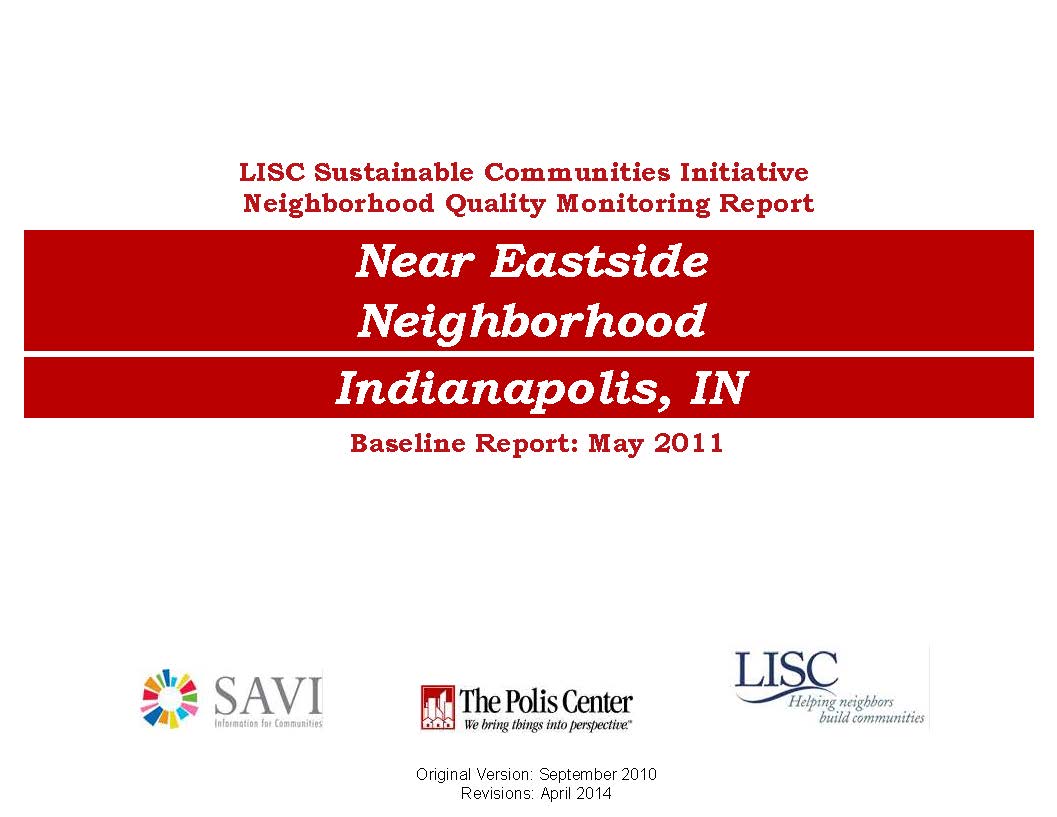
SAVI Report–2011 LISC Sustainable Communities Initiative Neighborhood Quality Monitoring Report: Near Eastside
The Local Initiatives Support Corporation (LISC) Sustainable Communities Initiatives supports community-driven efforts to revitalize neighborhoods through comprehensive community
development. In 2006, Indianapolis launched the Great Indy Neighborhoods Initiative (GINI) to promote healthy communities through comprehensive quality of life planning and
development. This effort has resulted in several programs and targeted investments in six demonstration sites throughout the city. This report is intended to help local funders, civic
and neighborhood leaders, and LISC staff monitor change in these areas of concentrated investment by providing local data and indicators about the quality of life in the Near Eastside,
one of the six demonstration neighborhoods.
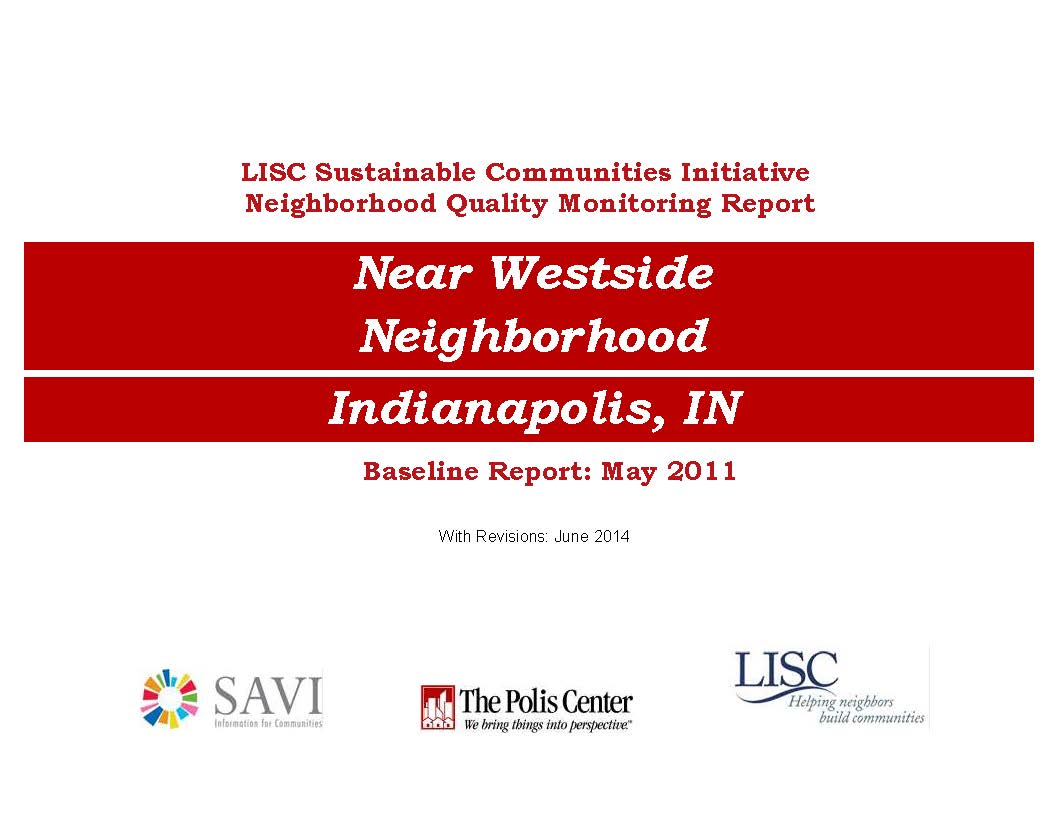
SAVI Report–2011 LISC Sustainable Communities Initiative Neighborhood Quality Monitoring Report: Near Westside
The Local Initiatives Support Corporation (LISC) Sustainable Communities Initiatives supports community-driven efforts to revitalize neighborhoods through comprehensive
community development. In 2006, Indianapolis launched the Great Indy Neighborhoods Initiative (GINI) to promote healthy communities through comprehensive quality of life
planning and development. This effort has resulted in several programs and targeted investments in six demonstration sites throughout the city. This report is intended to help local
funders, civic and neighborhood leaders, and LISC staff monitor change in these areas of concentrated investment by providing local data and indicators about the quality of life in
one of the six demonstration neighborhoods, the Near Westside
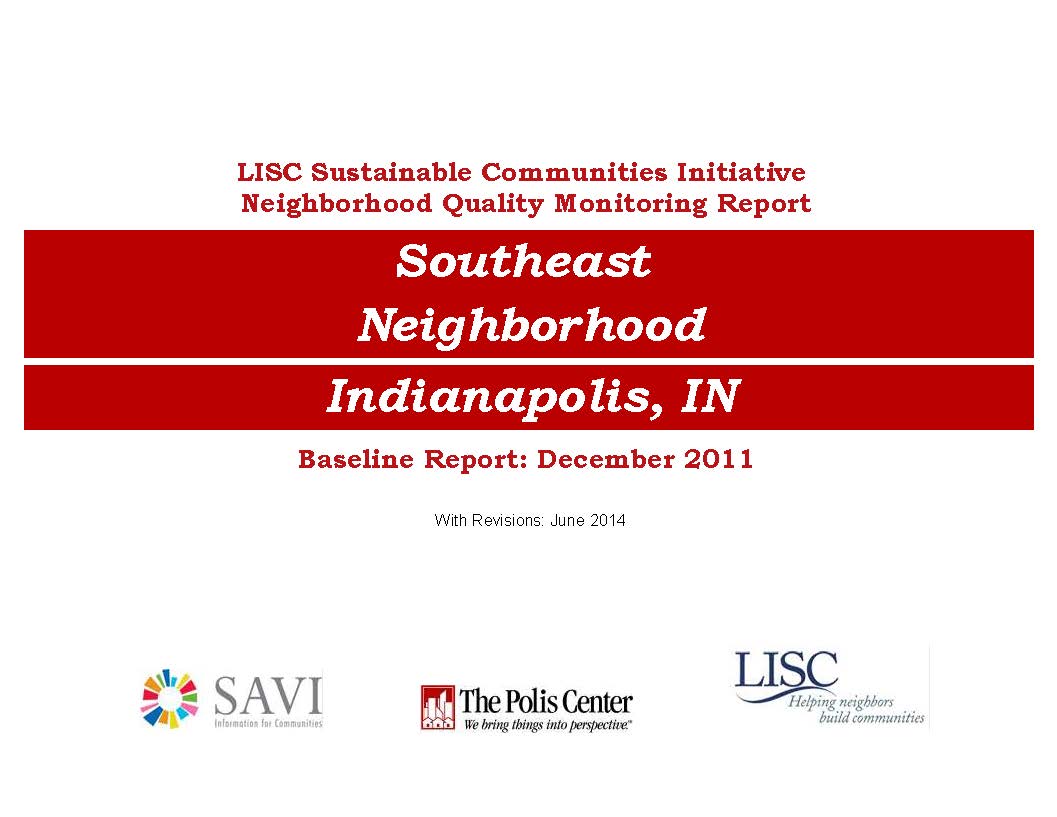
SAVI Report–2011 LISC Sustainable Communities Initiative Neighborhood Quality Monitoring Report: Southeast
The Local Initiatives Support Corporation (LISC) Sustainable Communities Initiatives supports community-driven efforts to revitalize neighborhoods through comprehensive
community development. In 2006, Indianapolis launched the Great Indy Neighborhoods Initiative (GINI) to promote healthy communities through comprehensive quality-of-life
planning and development. This effort has resulted in several programs and targeted investments in six demonstration sites throughout the city. This report is intended to help local
funders, civic and neighborhood leaders, and LISC staff monitor change in these areas of concentrated investment by providing local data and indicators of quality of life in one of the
six demonstration neighborhoods, Southeast.
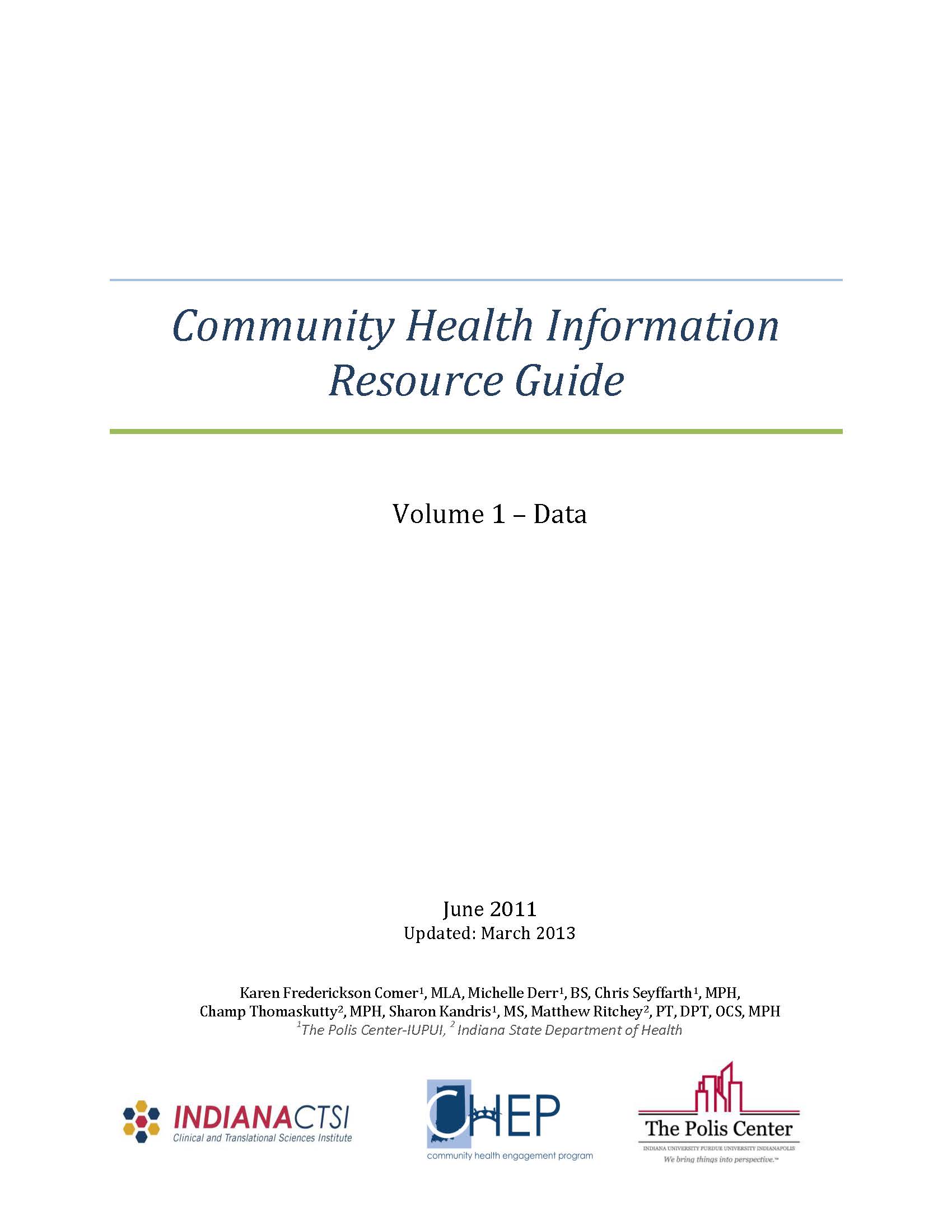
2011 SAVI Report–Community Health Resource Guide
This resource guide contains useful information for those who would like to use data to assess the health status of an Indiana community. Targeted users include local organizations such as county health departments and community health coalitions. Being able to access and use relevant data and information resources is a common hurdle for those interested in assessing and advancing community health. As a result of this need and at the request of the Community Advisory Council of the Community Health Engagement Program, we developed this resource guide to assist individuals, organizations, and coalitions in Indiana in identifying appropriate resources that guide their community health research and evaluation activities
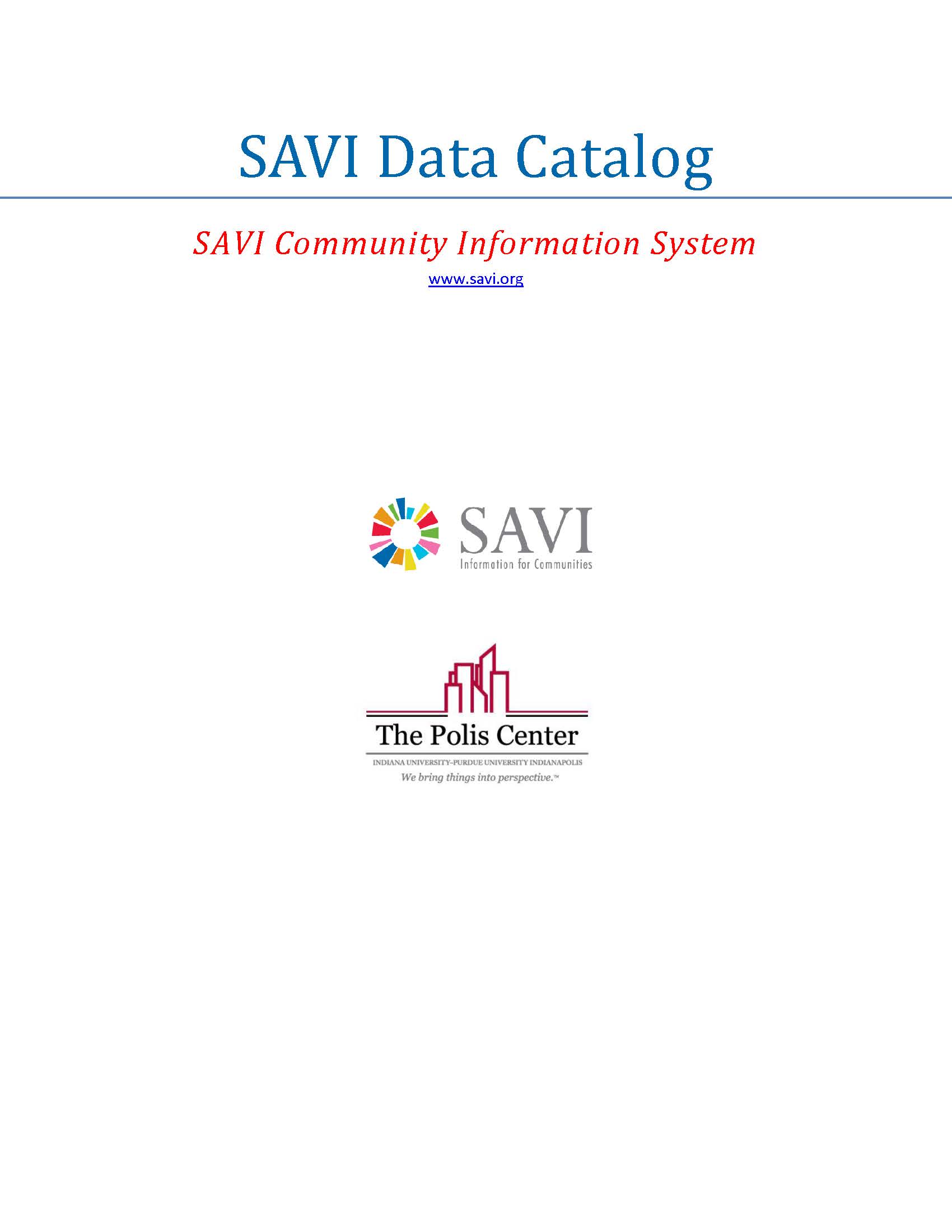
2011 SAVI Data Catalog
The SAVI data catalog is a detailed inventory, organized by category and source, of all vulnerability data found in the SAVI Community Information System database. For each topic, the data catalog provides detailed information on source providers, SAVI processing and output, SAVI indicators, reporting levels, data years, and limitations and assumptions. We created the catalog to help users understand the breadth of data available on the SAVI website and the nuances important when using and analyzing the data. The catalog can be used to determine if SAVI includes a particular data source or data about a certain topic and to learn the important details about the data in SAVI that are important to consider before using it for a particular purpose such as research.
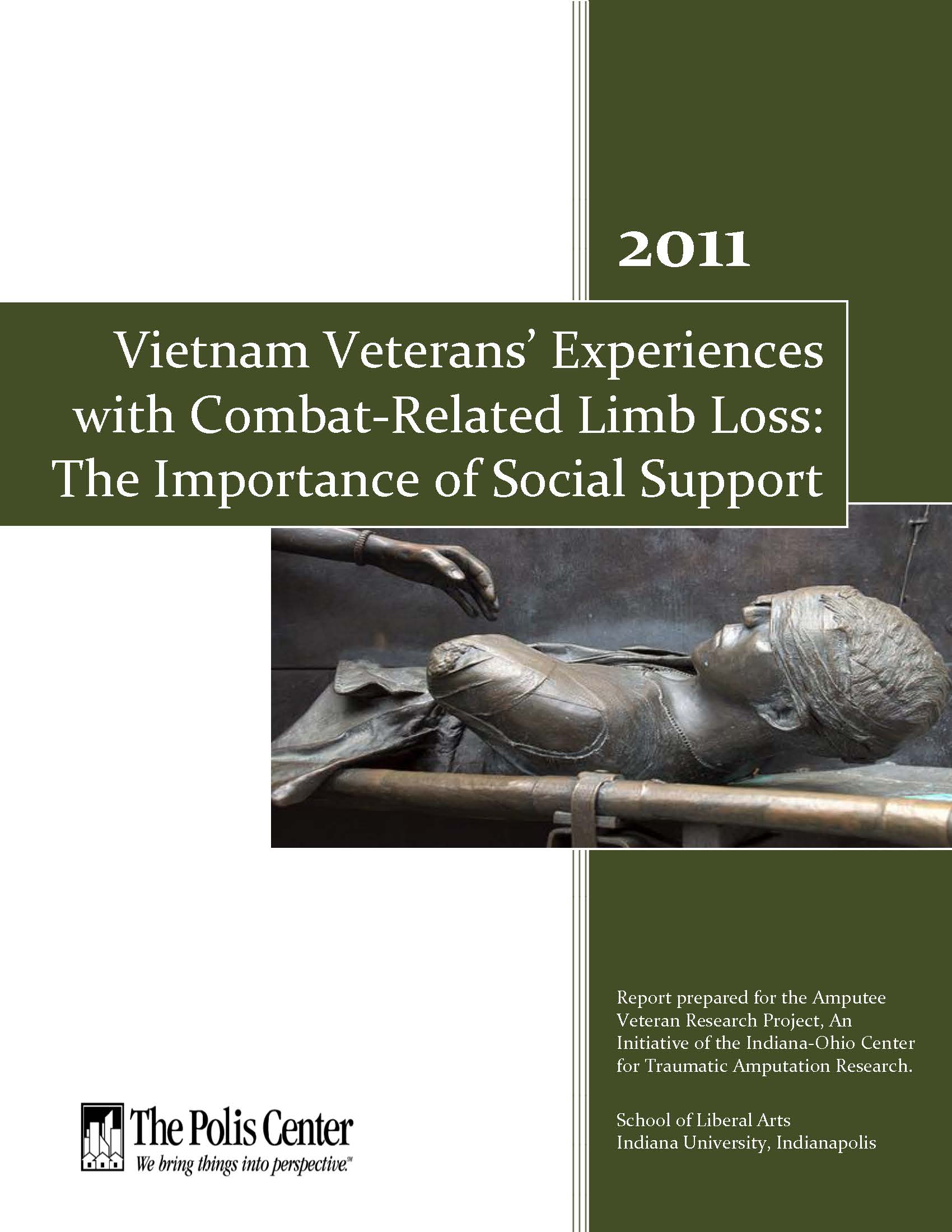
Vietnam Veterans’ Experiences with Combat-Related Limb Loss: The Importance of Social Support
The Polis Center at IUPUI, Foote, Carrie E., Regina Pessagno, Robbie Janik
The Indiana-Ohio Center for Traumatic Amputation Rehabilitation Research (IOCTARR) conducts policy-focused research on the various physical and mental health needs of veterans with combat related amputations, also known as traumatic amputations. The aim is to help determine the best ways to implement the rehabilitation processes for traumatic amputees of present and future conflicts. Researchers at IOCTARR hypothesized that United States military personnel who experience an amputation resulting from combat are likely to have unique rehabilitation needs, especially over the life course. examine these issues with Vietnam veterans who experienced combat-related limb loss. Most such surviving veterans have lived with their amputations close to, or slightly more than, 40 years. Understanding their experiences, the basic thrust of the project, should shed substantial light on the nature of both the short and long-term needs of current combat-related amputees. Understanding their experiences should shed substantial light on the nature of both the short and long-term needs of current combat-related amputees. The Amputee Veterans Research Project (AVR) unfolded in three phases and produced a series of reports. This report is the Phase III Social Support Interviews Final Report. Phase III constructed a 159-item survey instrument administered to the entire registry to understand the health and care-giving issues associated with traumatic amputations. Researchers also conducted follow-up interviews with two sets of respondents to develop a keener understanding of survey results, especially around issues of social support.

Executive Summary Amputee Veteran Project Phase II and Phase III
The Polis Center at IUPUI, Carrie E. Foote, Regina Pessagno, James Wolf
The Indiana-Ohio Center for Traumatic Amputation Rehabilitation Research (IOCTARR) conducts policy-focused research on the various physical and mental health needs of veterans with combat related amputations, also known as traumatic amputations. The aim is to help determine the best ways to implement the rehabilitation processes for traumatic amputees of present and future conflicts. Researchers at IOCTARR hypothesized that United States military personnel who experience an amputation resulting from combat are likely to have unique rehabilitation needs, especially over the life course. examine these issues with Vietnam veterans who experienced combat-related limb loss. Most such surviving veterans have lived with their amputations close to, or slightly more than, 40 years. Understanding their experiences, the basic thrust of the project, should shed substantial light on the nature of both the short and long-term needs of current combat-related amputees. Understanding their experiences should shed substantial light on the nature of both the short and long-term needs of current combat-related amputees. The Amputee Veterans Research Project (AVR) unfolded in three phases and produced a series of reports. This report is an executive summary of Phases II and III. Phase II collected in-depth interview data from a randomly drawn sample (n=20) of registrants. These interviews probed participants’ health and welfare needs during the first 12 months of injury and over their post-amputation lives. Phase III constructed a 159-item survey instrument administered to the entire registry to understand the health and care-giving issues associated with traumatic amputations. Researchers also conducted follow-up interviews with two sets of respondents to develop a keener understanding of survey results, especially around issues of social support.
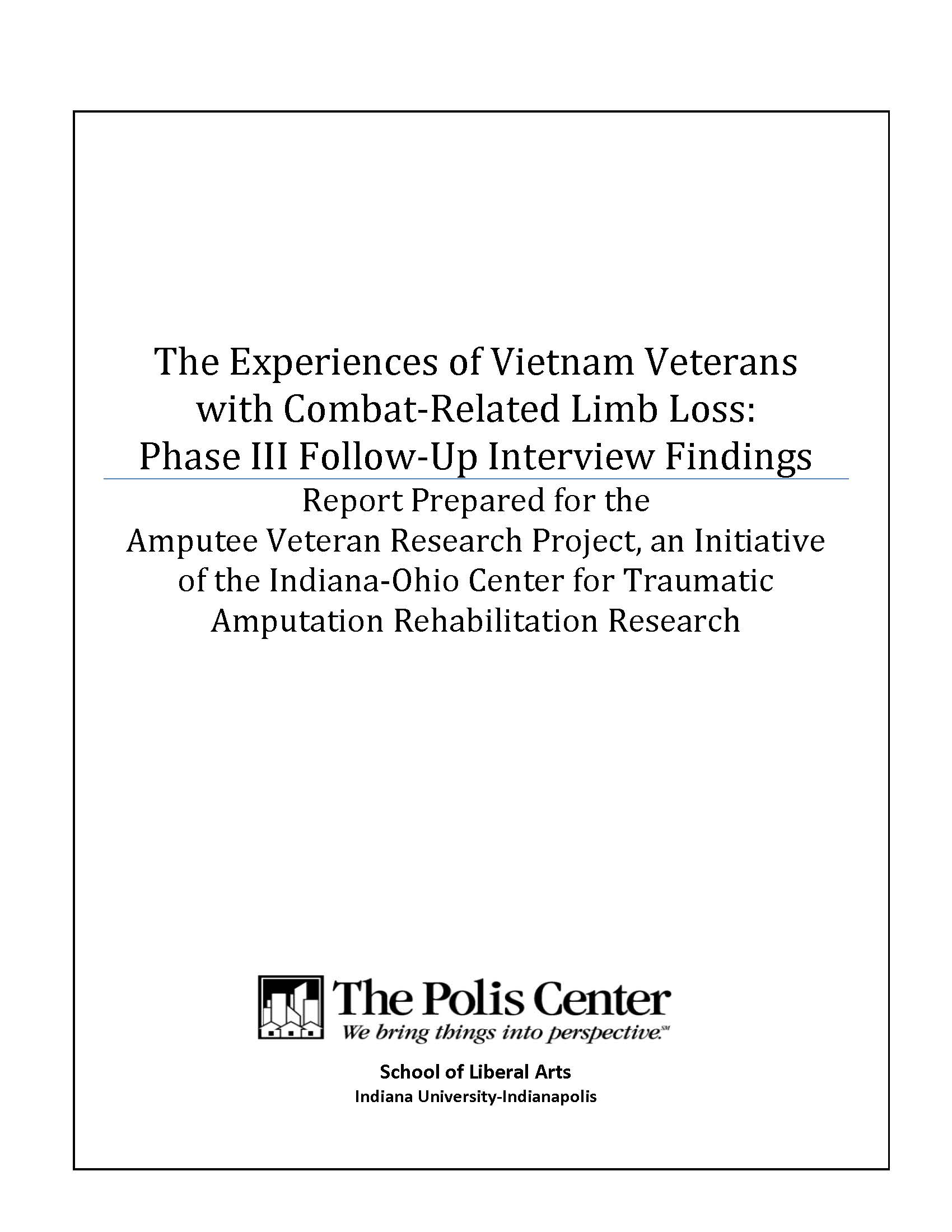
The Experiences of Vietnam Veterans with Combat-Related Limb Loss: Phase III Follow-Up Interview Findings
The Polis Center at IUPUI, Carrie Foote, Ph.D., Regina Pessagno, M.A.
The Indiana-Ohio Center for Traumatic Amputation Rehabilitation Research (IOCTARR) conducts policy-focused research on the various physical and mental health needs of veterans with combat related amputations, also known as traumatic amputations. The aim is to help determine the best ways to implement the rehabilitation processes for traumatic amputees of present and future conflicts. Researchers at IOCTARR hypothesized that United States military personnel who experience an amputation resulting from combat are likely to have unique rehabilitation needs, especially over the life course. examine these issues with Vietnam veterans who experienced combat-related limb loss. Most such surviving veterans have lived with their amputations close to, or slightly more than, 40 years. Understanding their experiences, the basic thrust of the project, should shed substantial light on the nature of both the short and long-term needs of current combat-related amputees. Understanding their experiences should shed substantial light on the nature of both the short and long-term needs of current combat-related amputees. The Amputee Veterans Research Project (AVR) unfolded in three phases and produced a series of reports. This report provides Phase III follow-up interview findings. Phase III constructed a 159-item survey instrument administered to the entire registry to understand the health and care-giving issues associated with traumatic amputations. Researchers also conducted follow-up interviews with two sets of respondents to develop a keener understanding of survey results, especially around issues of social support.
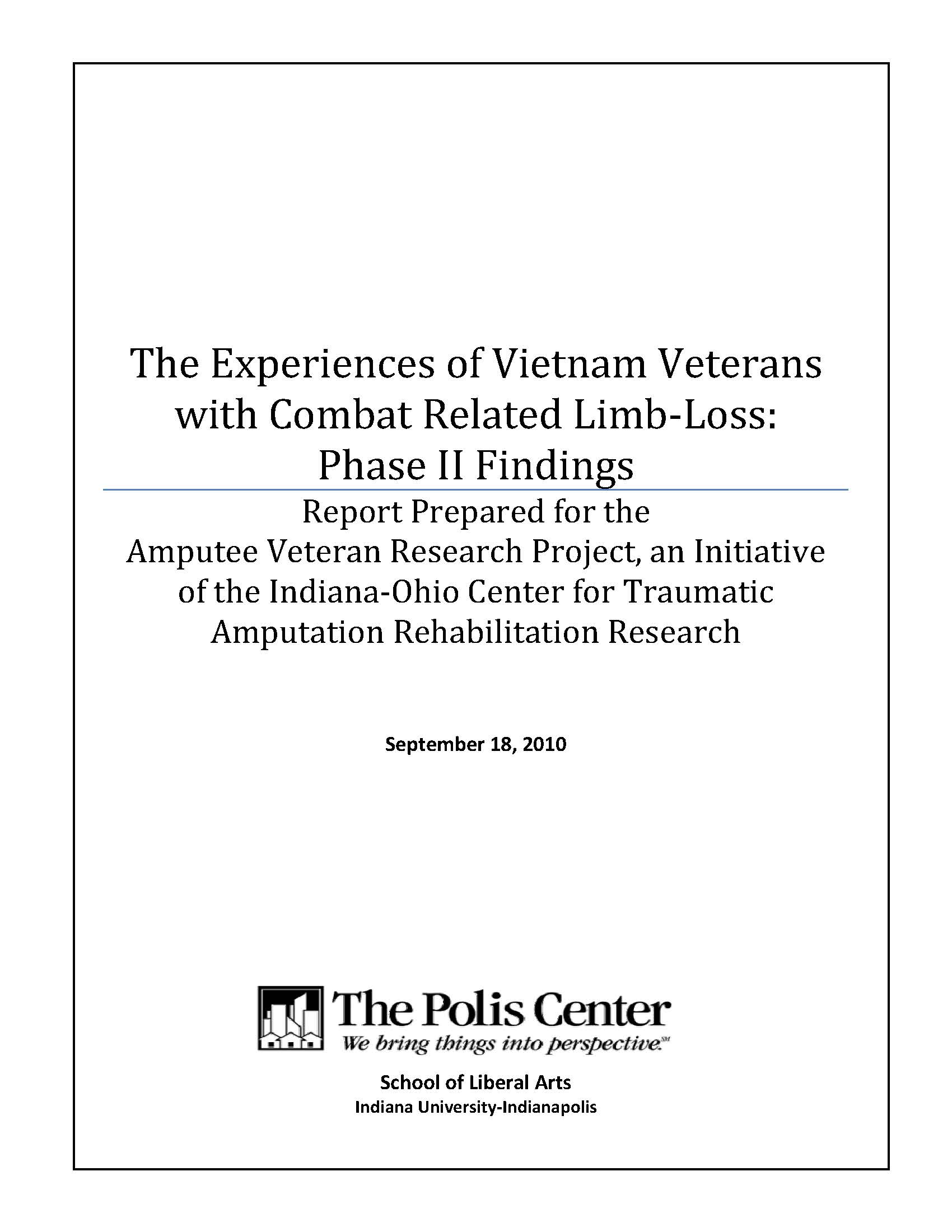
The Experiences of Vietnam Veterans with Combat Related Limb-Loss: Phase II Findings
The Polis Center at IUPUI, Carrie Foote, Ph.D. and Regina Pessagno, M.A.
The Indiana-Ohio Center for Traumatic Amputation Rehabilitation Research (IOCTARR) conducts policy-focused research on the various physical and mental health needs of veterans with combat related amputations, also known as traumatic amputations. The aim is to help determine the best ways to implement the rehabilitation processes for traumatic amputees of present and future conflicts. Researchers at IOCTARR hypothesized that United States military personnel who experience an amputation resulting from combat are likely to have unique rehabilitation needs, especially over the life course. examine these issues with Vietnam veterans who experienced combat-related limb loss. Most such surviving veterans have lived with their amputations close to, or slightly more than, 40 years. Understanding their experiences, the basic thrust of the project, should shed substantial light on the nature of both the short and long-term needs of current combat-related amputees. Understanding their experiences should shed substantial light on the nature of both the short and long-term needs of current combat-related amputees. The Amputee Veterans Research Project (AVR) unfolded in three phases and produced a series of reports. This report is the final report for Phase II. Phase II collected in-depth interview data from a randomly drawn sample (n=20) of registrants. These interviews probed participants’ health and welfare needs during the first 12 months of injury and over their post-amputation lives.
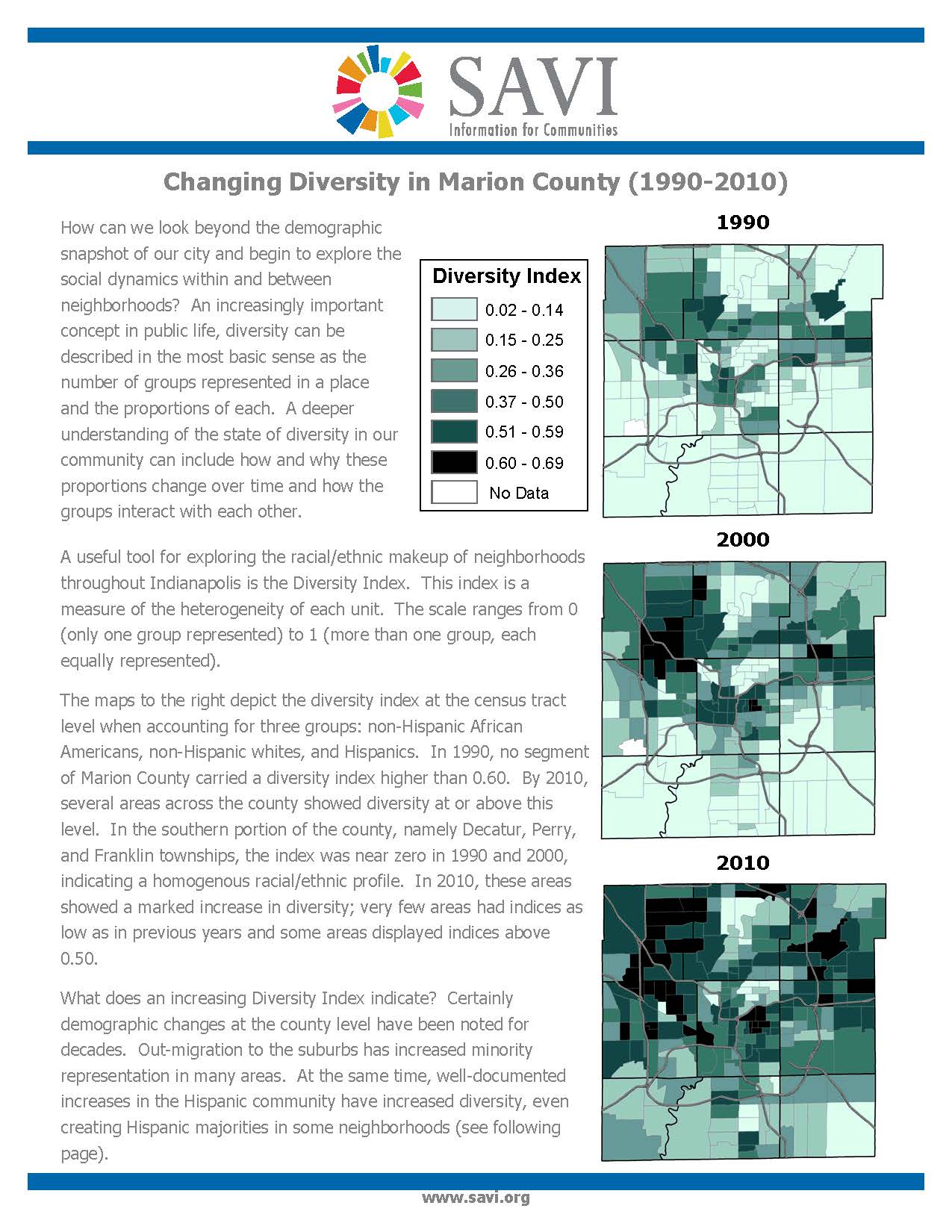
SAVI Report–1990-2010 Changing Diversity in Marion County
How can we look beyond the demographic snapshot of our city and begin to explore the social dynamics within and between neighborhoods? An increasingly important concept in public life, diversity can be described in the most basic sense as the number of groups represented in a place and the proportions of each. A deeper understanding of the state of diversity in our community can include how and why these proportions change over time and how the groups interact with each other.
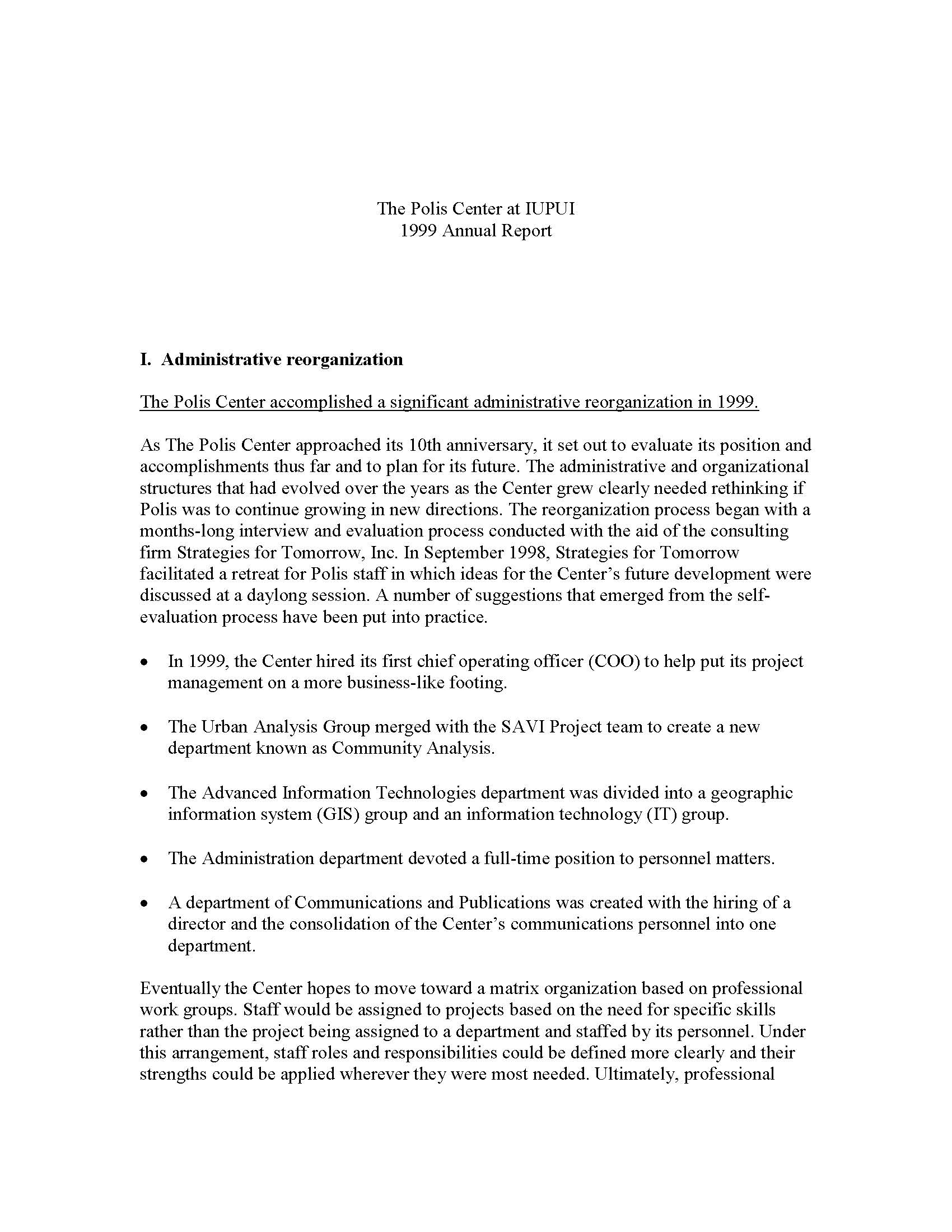
1999 Annual Report
As The Polis Center approached its 10th anniversary, it set out to evaluate its position and accomplishments thus far and to plan for its future. The administrative and organizational structures that had evolved over the years as the Center grew clearly needed rethinking if Polis was to continue growing in new directions. The reorganization process began with a months-long interview and evaluation process conducted with the aid of the consulting firm Strategies for Tomorrow, Inc. In September 1998, Strategies for Tomorrow facilitated a retreat for Polis staff in which ideas for the Center’s future development were discussed at a daylong session. A number of suggestions that emerged from the self evaluation process have been put into practice
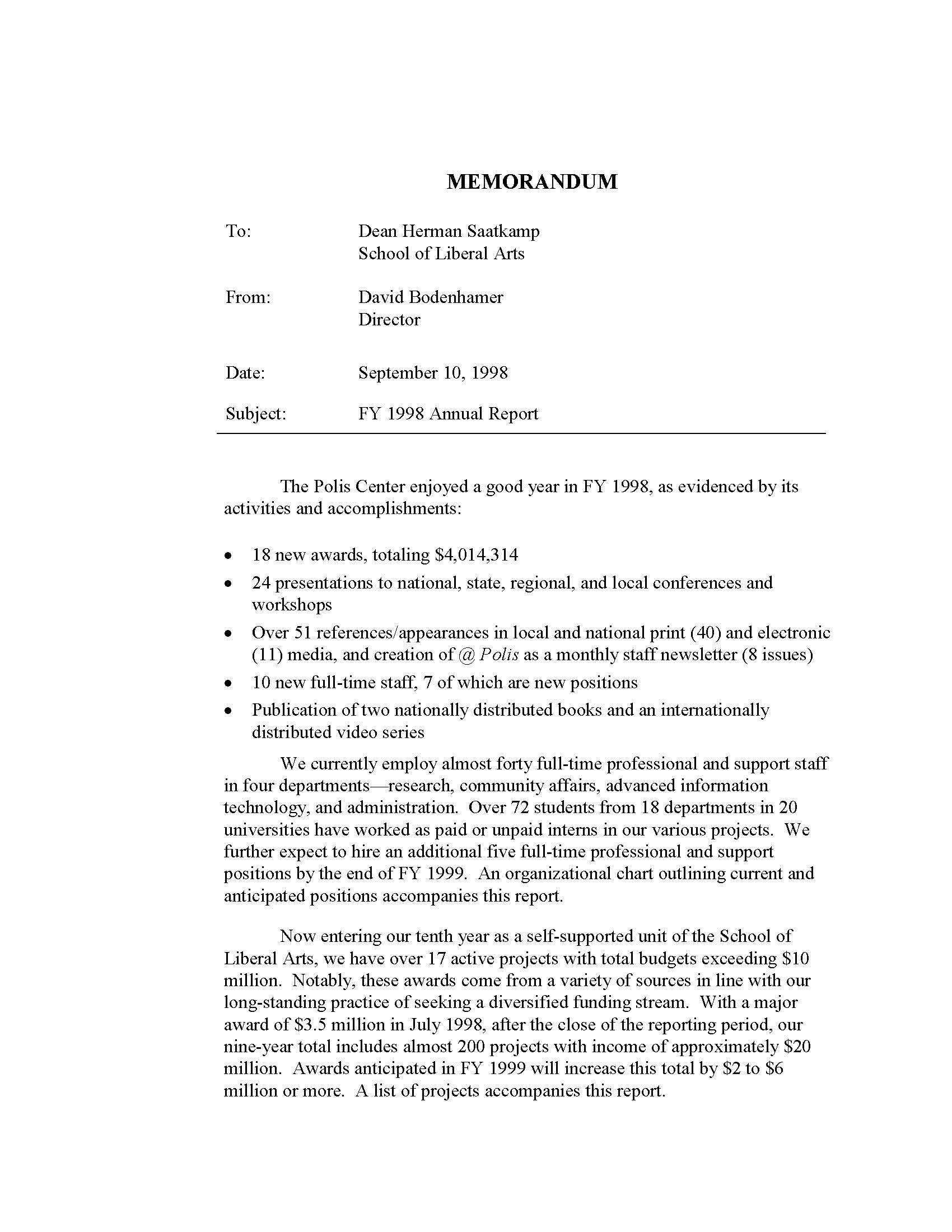
1998 Annual Report
Now entering our tenth year as a self-supported unit of the School of Liberal Arts, we have over 17 active projects with total budgets exceeding $10 million. Notably, these awards come from a variety of sources in line with our long-standing practice of seeking a diversified funding stream. With a major award of $3.5 million in July 1998, after the close of the reporting period, our
nine-year total includes almost 200 projects with income of approximately $20 million. Awards anticipated in FY 1999 will increase this total by $2 to $6 million or more. A list of projects accompanies this report.

